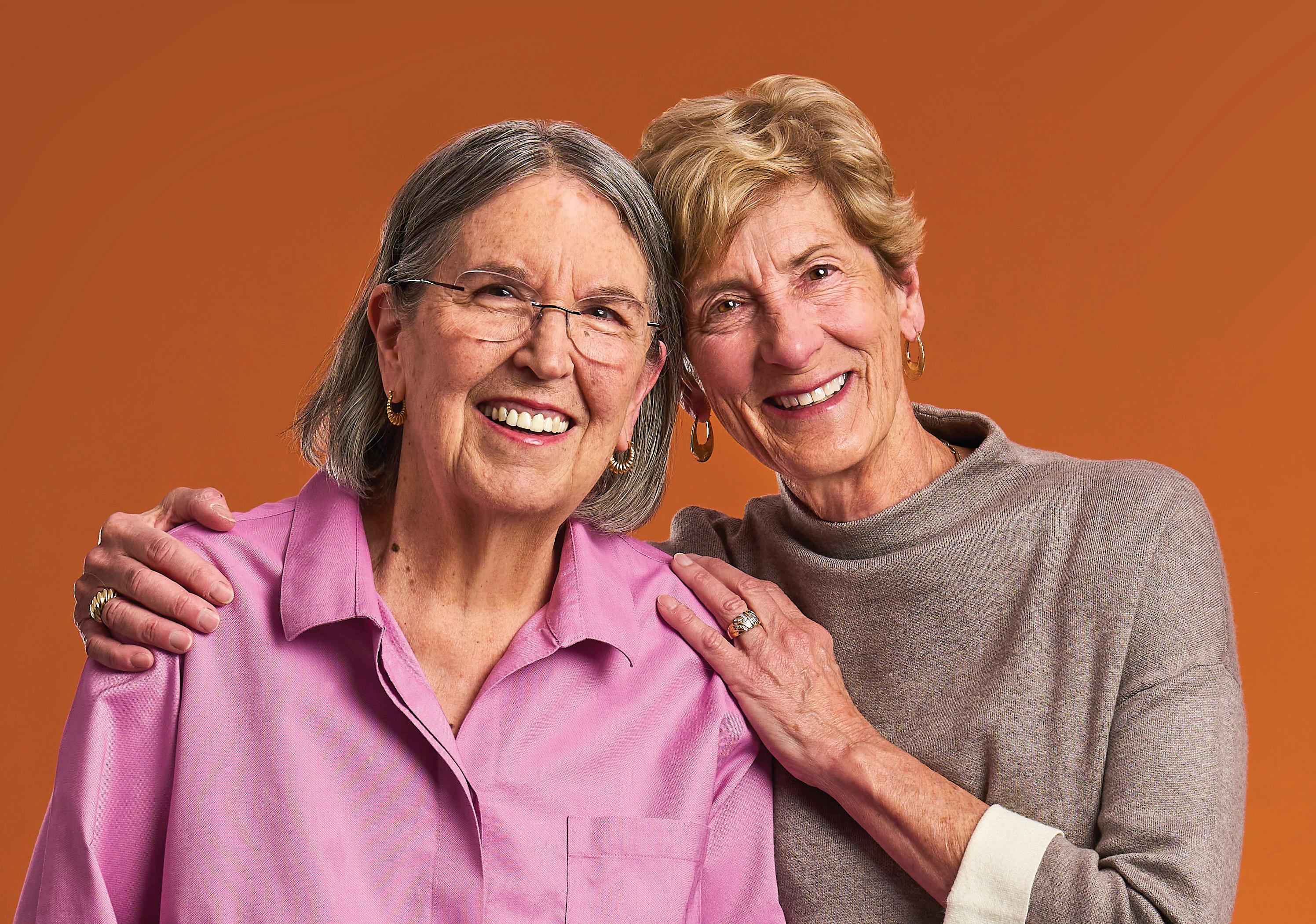
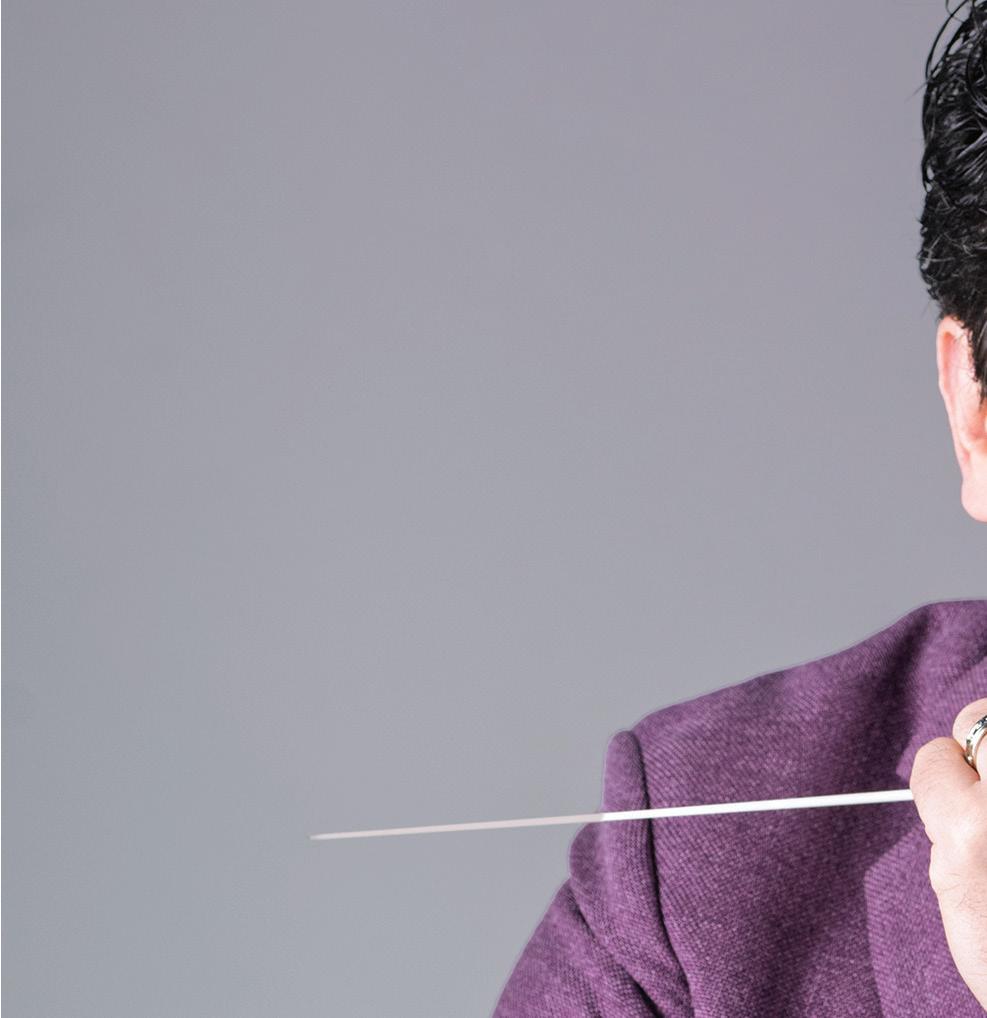
Life is good when you’re surrounded by music

/ OCT 2025



Life is good when you’re surrounded by music

/ OCT 2025
NOV / DEC 2025

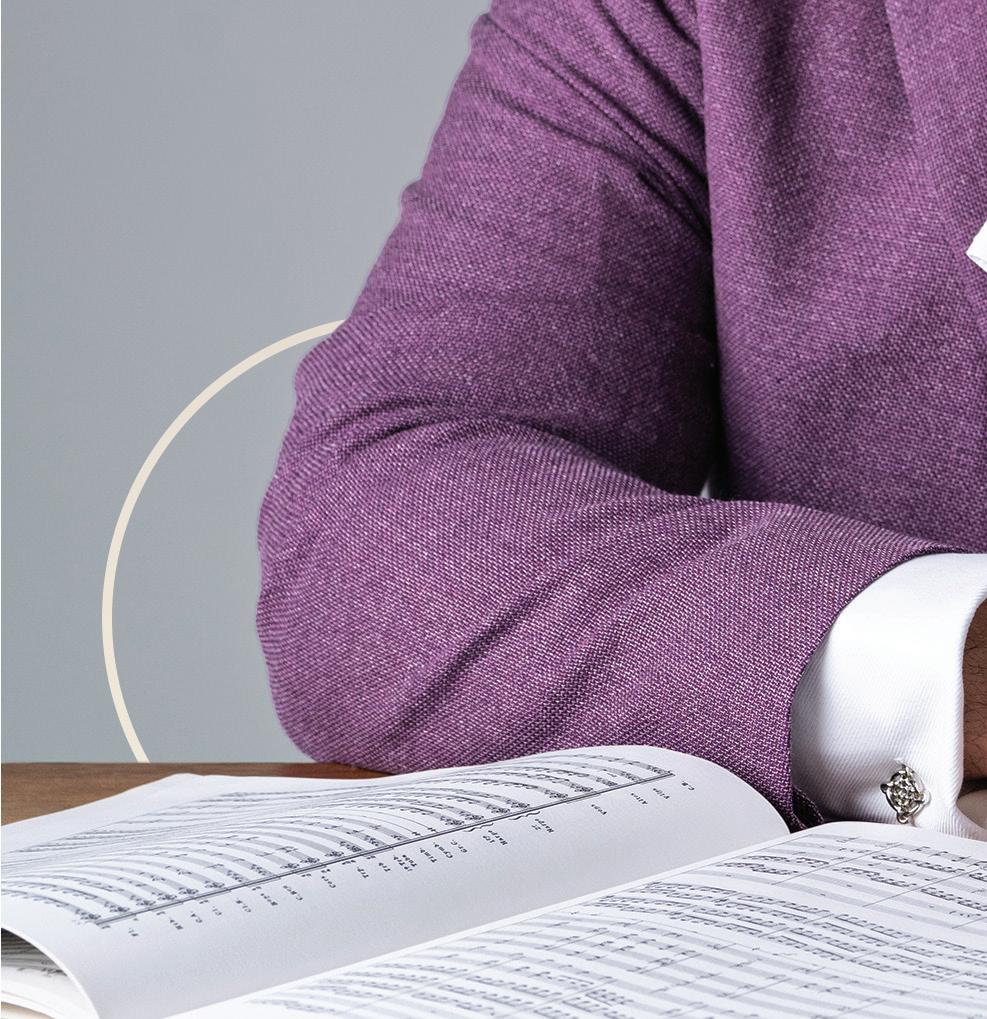



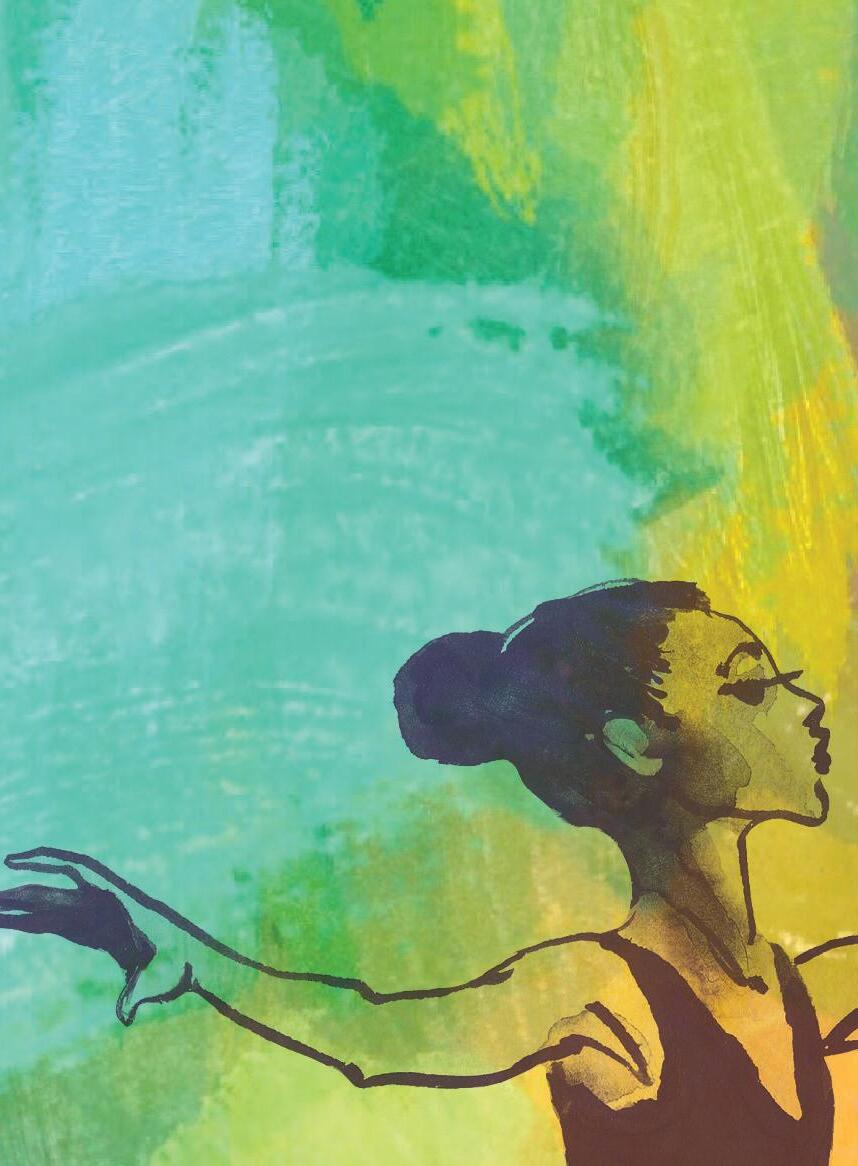












A proud sponsor of the musical arts







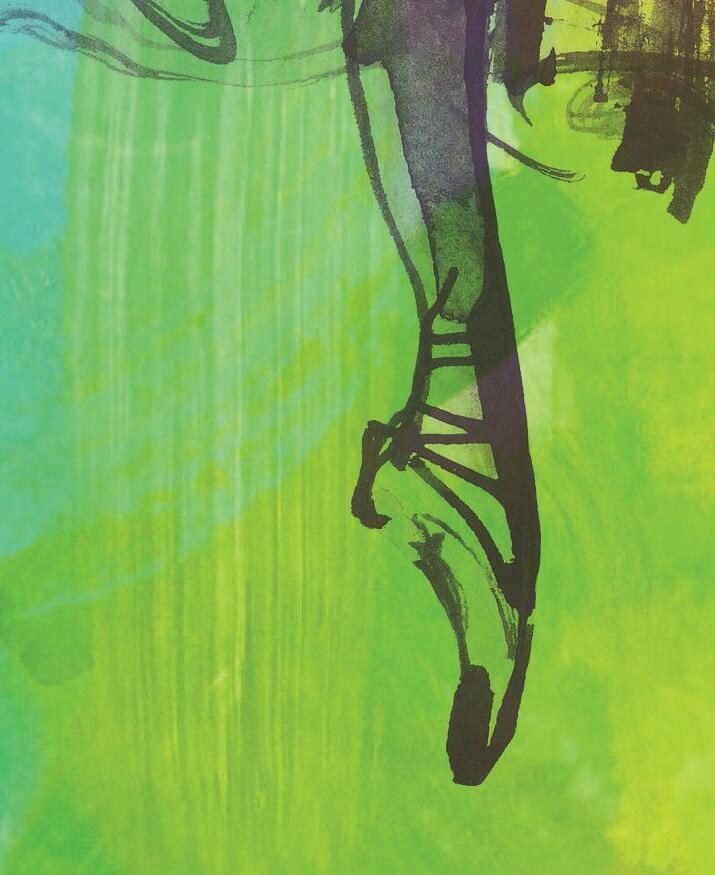


















9 A native of Romania, Cristian Măcelaru has always felt a keen connection to his countryman, the composer George Enescu, whom Măcelaru describes as “a personal hero.” Read about the many parallels between these two musicians, plus a Cincinnati connection, on pp. 9-13.
14

• NOV 1 & 2: Disney in Concert: Hocus Pocus (Pops)
• NOV 4: Yo-Yo Ma Plays Elgar (CSO)
• NOV 8 & 9: The Bells & Symphonie Fantastique (CSO)
• NOV 12 & 13: Nas: Illmatic Live (Pops)
• NOV 15: Let’s Dance (Lollipops Family Concert)
• NOV 21 & 22: Louis Conducts Petrushka (CSO)
• NOV 29 & 30: Dvořák Symphony No. 7 (CSO)
• DEC 5 & 6: Handel’s Messiah (CSO)
• DEC 7: Common Lines (CSYO Concert Orchestra) and The Year 1905 (CSYO Philharmonic Orchestra)
• DEC 12–14: Holiday Pops (CSO)
74
80 Administration
ON THE COVER: CSO Music Director Cristian Măcelaru.
Credit: Alex Johnson pp. 9-13. pp. 14–15. pp. 16–17.

“This season carries an incredible sense of anticipation and hope,” says Charla Weiss, the CSO’s new Board Chair. Read more about how Weiss, along with new Music Director Cristian Măcelaru and President & CEO Robert McGrath, are shaping the organization both on stage and in the community on pp. 14–15.
16
While listening to live music doesn’t guarantee healing from serious illnesses or chronic conditions, compelling scientific evidence suggests that it does have a positive impact, from improving breathing and heart rates to increasing focus and sociability. Find out more about the many good reasons to keep listening to live music, on pp. 16–17.
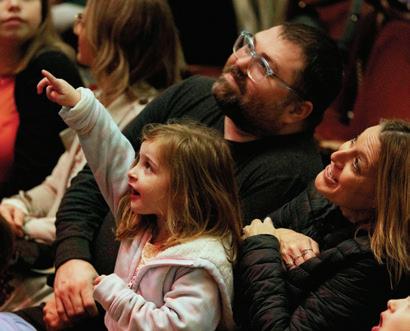

Whether you’re new to chamber music or have loved it for years, Linton Chamber Music offers a rich, unforgettable experience.
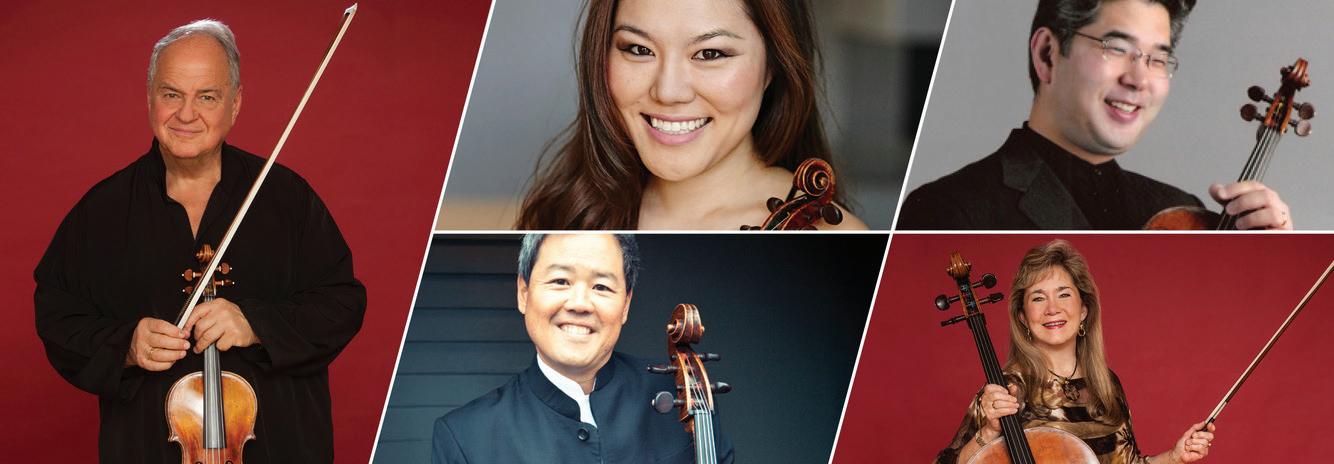

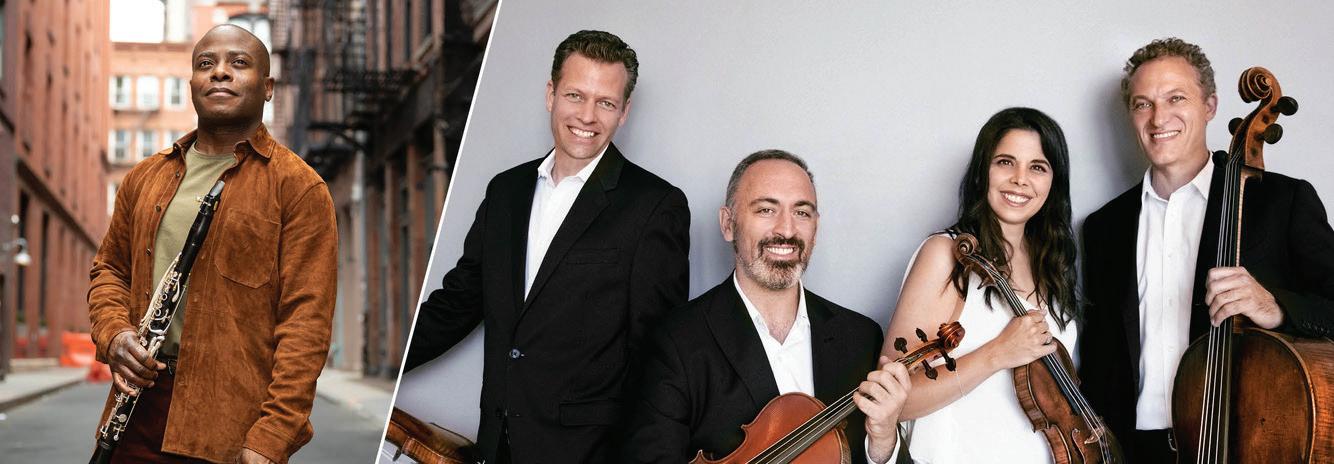
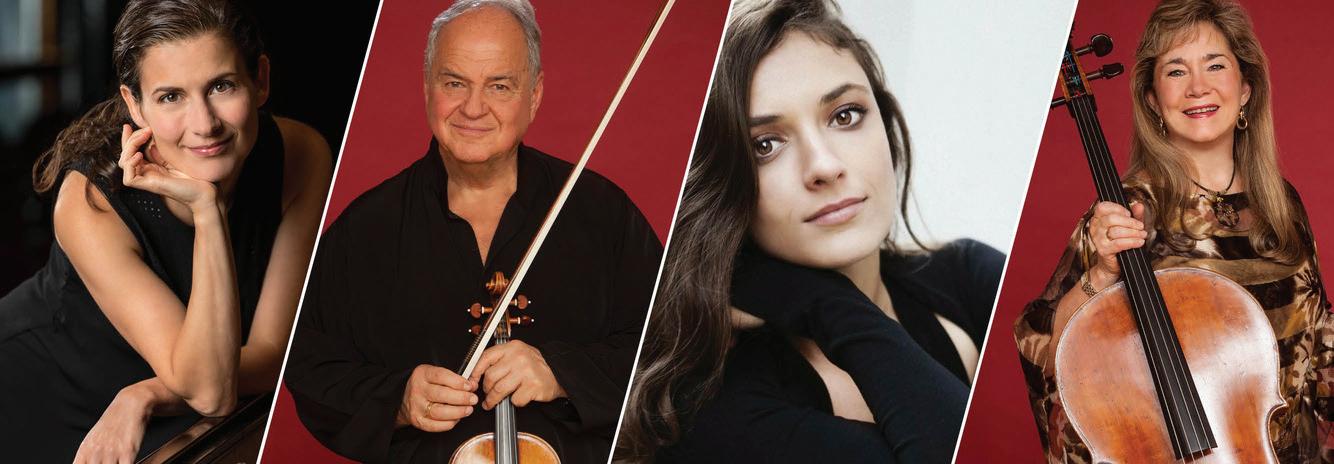

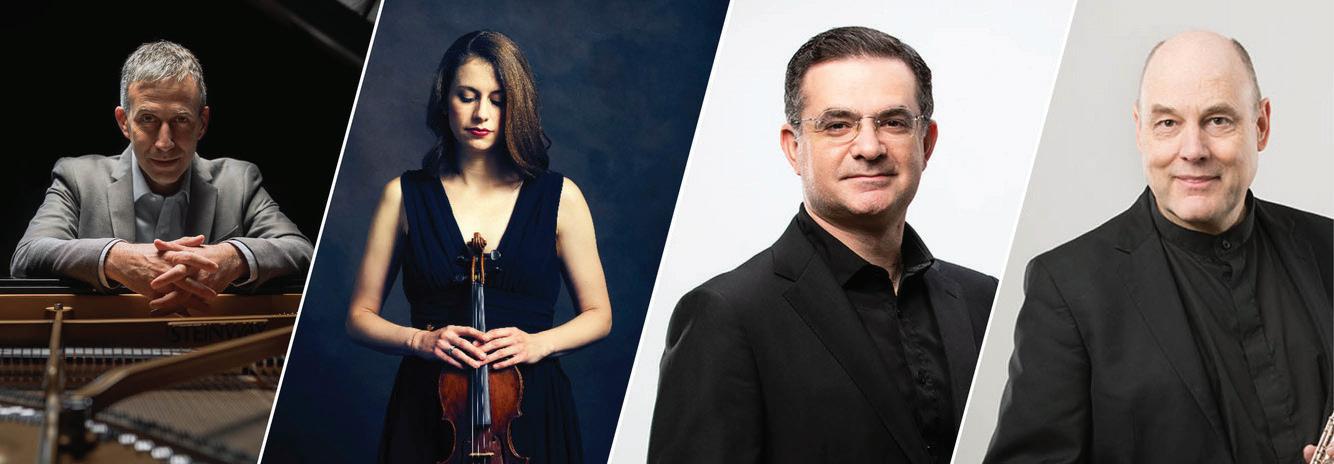
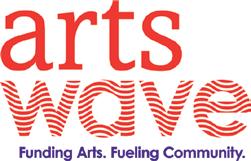

Schub e r t’s D iv ine Q uinte t
DEC 7/8, 2025
Experience a delightful duo by Mozart, the elegance and grace of Boccherini’s String Quintet (you might recognize its famous minuet f rom f ilms and TV), and Schubert’s String Quintet, a moving masterpiece known for its sublime beauty and emotional power
D y namic D uos
JAN 18, 2026
Violinist Bella Hristova and pianist Anna Polonsky perform a dynamic program that features the timeless beauty of Bach, playful charm of Haydn, exuberant melodies of Grieg, and a world premiere by Pulitzer Prize-winning composer Ellen Taaffe Zwilich
Ame r ica n S t or ies
FEB 1/2, 2026
Clarinetist Anthony McGill and the Pacif ica Quartet join together to perform a program that celebrates the rich tapestry of the American experience through the works of Richard Danielpour, James Lee III, Valerie Coleman, and Antonín Dvořák
D vořák’s Bohemia n Sp ir it
FEB 22/23, 2026
Experience piano quartets that feature the vibrant spirit of Dvořák, brilliance and wit of Beethoven, and the distinctive voice of neo-Romantic, American composer Richard Danielpour in a work that explores the cycles of life
The Ar t of the S t r ing Q uar te t
MAR 15/ 16, 2026
Take a journey with the Calidore String Quartet as they perform a groundbreaking Beethoven work with an exquisite slow movement known for moving the composer to tears, a lyrical, action-packed quartet by Haydn, and an elegiac, “self-portrait” by Shostakovich
Be e th ove n’s Gh os t Tr io
MAY 3/4 , 2026
CSO principals join pianist Benjamin Hochman to perform a trifecta of trios, including a tempestuous and triumphant masterpiece by Mendelssohn, a centerpiece by Beethoven known for its haunting beauty, and an animated gem by Haydn


CINCINNATI SYMPHONY ORCHESTRA & CINCINNATI POPS
Music Hall, 1241 Elm Street, Cincinnati, OH 45202
Box Office: 513.381.3300
hello@cincinnatisymphony.org
Group Sales: 513.864.0196 groupsales@cincinnatisymphony.org
TTY/TDD: Use TTY/TDD Relay Service 7-1-1
cincinnatisymphony.org cincinnatipops.org
O cers
Charla Weiss, Chair
Dianne Rosenberg, Immediate Past Chair
Sue McPartlin, Treasurer
Gerron McKnight, Secretary
Directors
Dorie Akers
Nick Apanius
Heather Apple
Evin Blomberg**
Kate C. Brown
Trish Bryan*
Otto M. Budig*
Emma Compton
Andrea Costa
FANFARE MAGAZINE STAFF:
Managing Editor
Tyler Secor
Senior Editor/Layout
Teri McKibben
Assistant Editor
Gabriela Godinez Feregrino
CINCINNATI MAGAZINE: Advertising and Publishing Partners for Fanfare Magazine
Publisher Ivy Bayer
Production Director & IT Systems
Administrator
Vu Luong
Advertising Designer
Sophie Kallis
Account Representatives
Laura Bowling, Maggie Wint Goecke, Chris Ohmer, Julie Poyer, Sarah Riesenberger
Operations Director
Missy Beiting
Business Coordinator
Meredith Carroll
Advertising and Business O ces
Atrium 2 — 221 E. 4th Street, Suite 130 Cincinnati, OH 45202 | 513.421.4300
Subscriptions: 1.866.660.6247 cincinnatimagazine.com




You are welcome to take this copy of Fanfare Magazine home with you as a souvenir of your concert experience. Alternatively, please share it with a friend or leave it with an usher for recycling. Thank you!
Adrian Cunningham
Gabriel Davis
Maria Espinola
Blair Fleischmann*
Kori Hill**
Francie S. Hiltz*
Joseph W. Hirschhorn*
Edna Keown
Florence Koetters*
John Lanni
H. Spencer Liles*
Robert W. McDonald
Dean Moulas
Ann E. Mulder
Aik Khai Pung
James B. (“Rick”) Reynolds*
Jack Rouse*
Patrick Schleker**
Valerie Sheppard
Brett Stover
Kari Ullman
Randolph (“Duck”) L. Wadsworth, Jr.*
Emeritus * Ex-O cio **
We thank our many partners who serve on the following CSO Board of Directors committees and task forces, as well as the Multicultural Awareness Council (MAC), as we collectively work to realize our vision to be the most relevant orchestra in America.
CSO Board of Directors Committees
Audience Engagement
Audit & Ethics
Inclusion
Executive
Finance & Investment
Learning
Nominating & Governance O cers Nominating
CSO Board of Directors Task Forces Government A airs Philanthropy Planned Giving
Non-Board Advisory Council Multicultural Awareness Council
WE BELIEVE MUSIC LIVES WITHIN US ALL regardless of who we are or where we come from. We believe that music is a pathway to igniting our passions, discovering what moves us, deepening our curiosity and connecting us to our world and to each other.
Our mission is to seek and share inspiration, and we exist to serve our community. Our entire community. Reflecting our community and the world around at every level — on stage, behind-the-scenes and in neighborhoods throughout the region — is essential to our present and future and makes us a strong ensemble and institution.
The Cincinnati Symphony Orchestra and Cincinnati Pops acknowledge that Cincinnati Music Hall occupies land that has been the traditional land of the Myaamia (Miami), Shawandasse Tula (Shawanwaki/Shawnee), and Wahzhazhe Manzhan (Osage) peoples, who have continuously lived upon this land since time immemorial. We honor past, present and future Indigenous peoples.









































































































































































































































































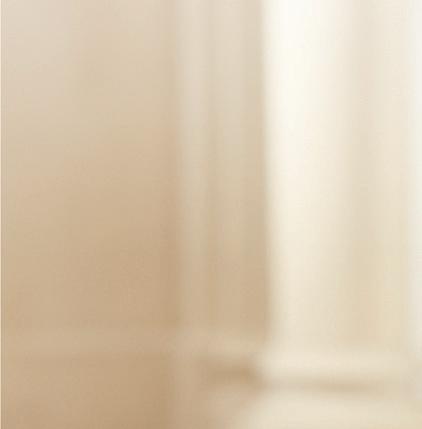
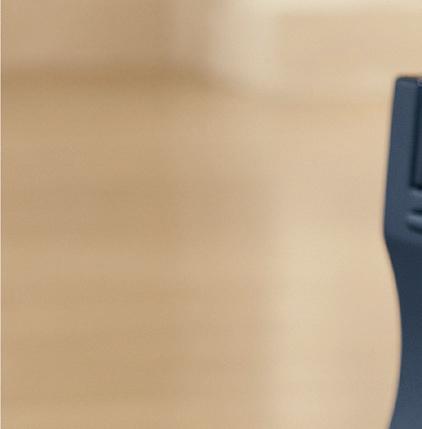
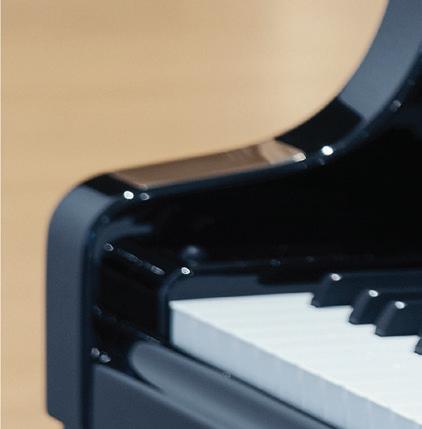



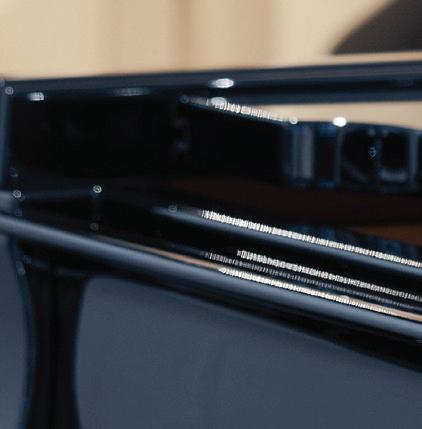




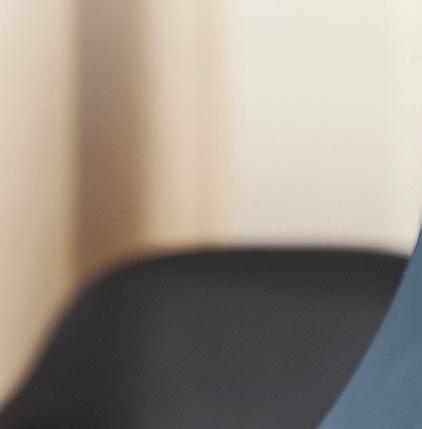
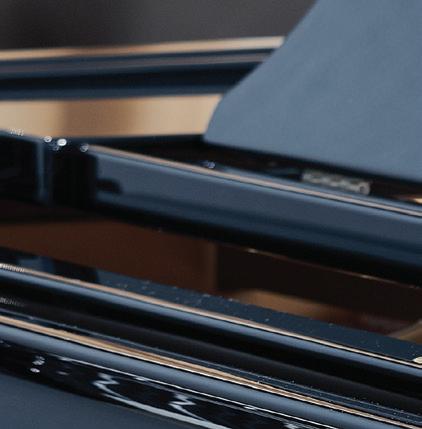
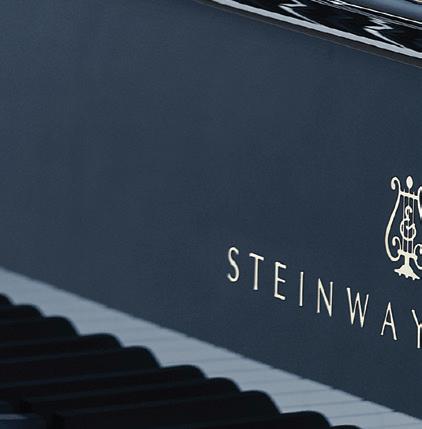


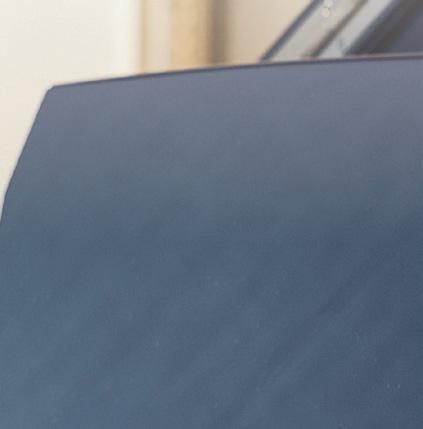

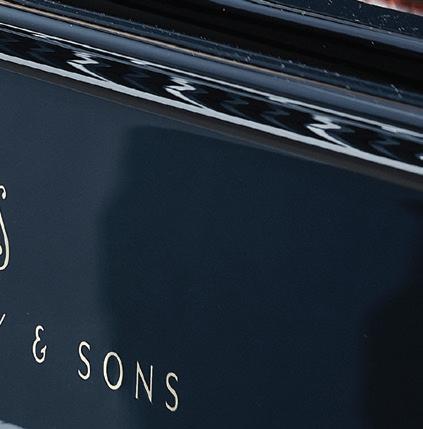
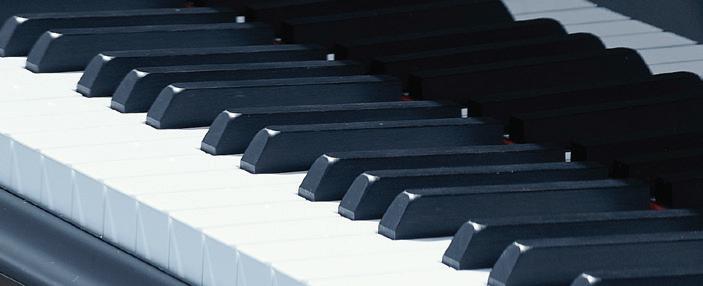
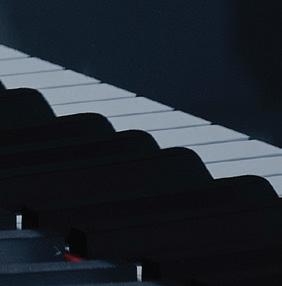

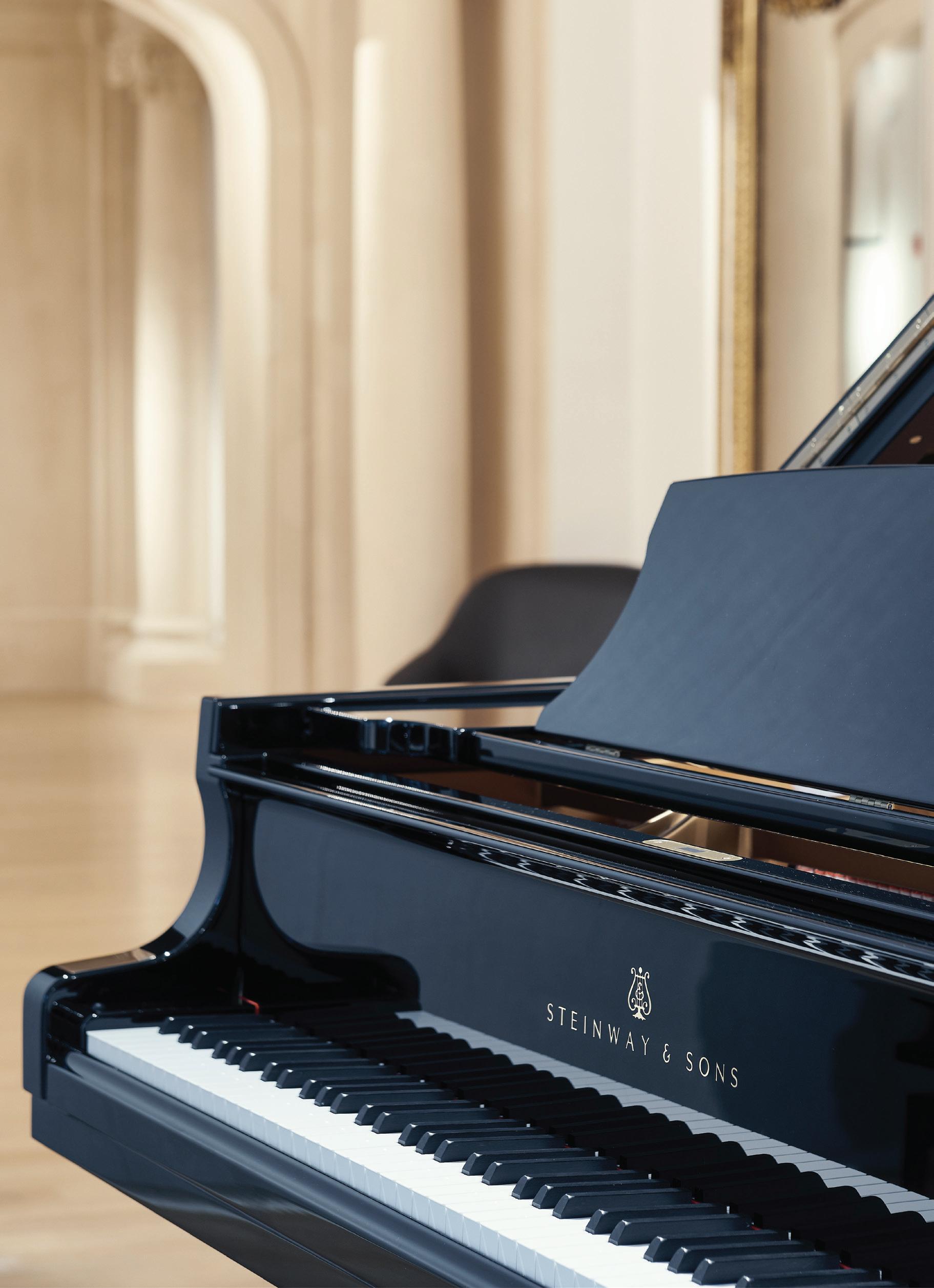
with the online version of Fanfare Magazine, the CSO developed a platform to deliver concertspecific content.
Along with the online version of Fanfare Magazine, the CSO has developed a digital platform to deliver concertspecific content.
Along with the online version of Fanfare Magazine, the CSO has developed a digital platform to deliver concertspecific content.
FOLLOW US social media for latest updates!
Facebook:
WELCOME to the November and December 2025 issue of Fanfare Magazine.
WELCOME to the November and December 2025 issue of Fanfare Magazine.
to the November and December 2025 issue of Fanfare Magazine.
For Cristian Măcelaru, the question of who he is and where he comes from is easier to answer not with words, but with music. Specifically, George Enescu’s Romanian Rhapsody No. 1. For Măcelaru, a native of Romania, Enescu is not only a national hero but also a personal guide. Hannah Edgar writes on pp. 9–13 about how Măcelaru’s legacy intertwines with that of Enescu’s, including unexpected connections with Cincinnati and the CSO.
For Cristian Măcelaru, the question of who he is and where he comes from is easier to answer not with words, but with music. Specifically, George Enescu’s Romanian Rhapsody No. 1. For Măcelaru, a native of Romania, Enescu is not only a national hero but also a personal guide. Hannah Edgar writes on pp. 9–13 about how Măcelaru’s legacy intertwines with that of Enescu’s, including unexpected connections with Cincinnati and the CSO.
For Cristian Măcelaru, the question of who he is and where he comes from is easier to answer not with words, but with music. Specifically, George Enescu’s Romanian Rhapsody No. 1. For Măcelaru, a native of Romania, Enescu is not only a national hero but also a personal guide. Hannah Edgar writes on pp. 9–13 about how Măcelaru’s legacy intertwines with that of Enescu’s, including unexpected connections with Cincinnati and the CSO.
Joining Music Director Cristian Măcelaru and President & CEO Robert McGrath to lead the organization into a bold new era is Board Chair Charla Weiss. On pp. 14–15 read about how Weiss completes a leadership trio poised to honor the CSO’s legacy while shaping its future.
Joining Music Director Cristian Măcelaru and President & CEO Robert McGrath to lead the organization into a bold new era is Board Chair Charla Weiss. On pp. 14–15 read about how Weiss completes a leadership trio poised to honor the CSO’s legacy while shaping its future.
Joining Music Director Cristian Măcelaru and President & CEO Robert McGrath to lead the organization into a bold new era is Board Chair Charla Weiss. On pp. 14–15 read about how Weiss completes a leadership trio poised to honor the CSO’s legacy while shaping its future.
Also joining our organization are our newest Orchestra musicians. David Lyman writes about their paths to joining the CSO, starting with their first music lessons. Acquaint yourself with David Smith, Michael Rau and Michael Martin by perusing their profiles on pp. 19–21.
Also joining our organization are our newest Orchestra musicians. David Lyman writes about their paths to joining the CSO, starting with their first music lessons. Acquaint yourself with David Smith, Michael Rau and Michael Martin by perusing their profiles on pp. 19–21.
Also joining our organization are our newest Orchestra musicians. David Lyman writes about their paths to joining the CSO, starting with their first music lessons. Acquaint yourself with David Smith, Michael Rau and Michael Martin by perusing their profiles on pp. 19–21.
Music has a deep impact on all of us, whether we are on stage or in the audience. Inspired by the 2025 May Festival’s Music and Mind program with soprano Renée Fleming, writer Anne Arenstein shares insights into what music does for our physical and emotional health on pp. 16–17.
Music has a deep impact on all of us, whether we are on stage or in the audience. Inspired by the 2025 May Festival’s Music and Mind program with soprano Renée Fleming, writer Anne Arenstein shares insights into what music does for our physical and emotional health on pp. 16–17.
Music has a deep impact on all of us, whether we are on stage or in the audience. Inspired by the 2025 May Festival’s Music and Mind program with soprano Renée Fleming, writer Anne Arenstein shares insights into what music does for our physical and emotional health on pp. 16–17.
FOLLOW US on social media for the latest updates!
FOLLOW US on social media for the latest updates!
@CincySymphony
Facebook: @CincySymphony
@CincinnatiPops
Facebook: @CincySymphony
@CincinnatiPops
Instagram: @CincySymphony
YouTube: CincySymphony
@CincinnatiPops
Instagram: @CincySymphony
Instagram: @CincySymphony
Knowing that a Romanian Rhapsody evokes thoughts of home for Măcelaru, we thought perhaps our Orchestra musicians share a similar sentiment. So, we asked them, “What music brings you home?” Explore their thoughtful answers on p. 18 and possibly reflect on your own answers to this issue’s Musician Q&A question.
Knowing that a Romanian Rhapsody evokes thoughts of home for Măcelaru, we thought perhaps our Orchestra musicians share a similar sentiment. So, we asked them, “What music brings you home?” Explore their thoughtful answers on p. 18 and possibly reflect on your own answers to this issue’s Musician Q&A question.
Knowing that a Romanian Rhapsody evokes thoughts of home for Măcelaru, we thought perhaps our Orchestra musicians share a similar sentiment. So, we asked them, “What music brings you home?” Explore their thoughtful answers on p. 18 and possibly reflect on your own answers to this issue’s Musician Q&A question.
Please enjoy these stories that have been curated for you in Fanfare Magazine, but also know that the Fanfare Magazine experience is not limited to a print publication available only at Music Hall concerts. You can explore Fanfare Magazine at any time via our website at cincinnatisymphony.org/fanfare-magazine, where you can also find web exclusive articles.
YouTube: @CincySymphony
YouTube: @CincySymphony
TikTok: @cincysymphony
TikTok: @cincysymphony
TikTok: @cincysymphony
Please enjoy these stories that have been curated for you in Fanfare Magazine, but also know that the Fanfare Magazine experience is not limited to a print publication available only at Music Hall concerts. You can explore Fanfare Magazine at any time via our website at cincinnatisymphony.org/fanfare-magazine, where you can also find web exclusive articles.
Please enjoy these stories that have been curated for you in Fanfare Magazine, but also know that the Fanfare Magazine experience is not limited to a print publication available only at Music Hall concerts. You can explore Fanfare Magazine at any time via our website at cincinnatisymphony.org/fanfare-magazine, where you can also find web exclusive articles.


*By texting to this number, you may receive messages that pertain to the organization and its performances; msg & data rates may apply. Reply HELP to help, STOP to cancel.
*By texting to this number, you may receive messages that pertain to the organization and its performances; msg & data rates may apply. Reply HELP to help, STOP to cancel.
Along with the online version of Fanfare Magazine, the CSO has developed a digital platform to deliver concert-specific content to meet the CSO’s ongoing commitment to digital storytelling, innovation and accessibility. This digital platform offers early access to exclusive concert-specific content: full-length program notes, artist biographies, feature stories, up-to-theminute information and much more! As a bonus, program notes and artist biographies for the entire season will be available on this digital platform in advance of the season-opening concerts, allowing you to engage with all the content before you arrive at Music Hall.
Along with the online version of Fanfare Magazine, the CSO has developed a digital platform to deliver concert-specific content to meet the CSO’s ongoing commitment to digital storytelling, innovation and accessibility. This digital platform offers early access to exclusive concert-specific content: full-length program notes, artist biographies, feature stories, up-to-theminute information and much more! As a bonus, program notes and artist biographies for the entire season will be available on this digital platform in advance of the season-opening concerts, allowing you to engage with all the content before you arrive at Music Hall.
Along with the online version of Fanfare Magazine, the CSO has developed a digital platform to deliver concert-specific content to meet the CSO’s ongoing commitment to digital storytelling, innovation and accessibility. This digital platform offers early access to exclusive concert-specific content: full-length program notes, artist biographies, feature stories, up-to-theminute information and much more! As a bonus, program notes and artist biographies for the entire season will be available on this digital platform in advance of the season-opening concerts, allowing you to engage with all the content before you arrive at Music Hall.
Unlike a print magazine, this digital platform is compatible with all smartphone accessibility features. The CSO’s digital platform is easily accessible — no app to download or subscription to manage. To explore our digital content, visit cincinnatisymphony.org/DigitalProgram, text the word PROGRAM to 513.845.3024* or scan the QR code at right with your mobile device.
Unlike a print magazine, this digital platform is compatible with all smartphone accessibility features. The CSO’s digital platform is easily accessible — no app to download or subscription to manage. To explore our digital content, visit cincinnatisymphony.org/DigitalProgram, text the word PROGRAM to 513.845.3024* or scan the QR code at right with your mobile device.
Unlike a print magazine, this digital platform is compatible with all smartphone accessibility features. The CSO’s digital platform is easily accessible — no app to download or subscription to manage. To explore our digital content, visit cincinnatisymphony.org/DigitalProgram, text the word PROGRAM to 513.845.3024* or scan the QR code at right with your mobile device.
The CSO hopes you find inspiration within these pages and within the music — past, present and future — that reverberates at Music Hall and in the community. Thank you for being with us!
The CSO hopes you find inspiration within these pages and within the music — past, present and future — that reverberates at Music Hall and in the community. Thank you for being with us!
The CSO hopes you find inspiration within pages and within the music — past, present and future — that reverberates at Music Hall and in the community. Thank you for being with us!

Program Spotlight: POETRY OUT LOUD
Investing state and federal dollars, the Ohio Arts Council funds and supports quality arts experiences for all Ohioans to strengthen communities culturally, educationally, and economically.
Learn more about our grant programs and resources, find your next arts experience, or connect: OAC.OHIO.GOV.
CSO Music Director Cristian Măcelaru has long been fascinated by his fellow countryman. He’s tracing the late composer’s footsteps in more ways than one.
by HANNAH EDGAR
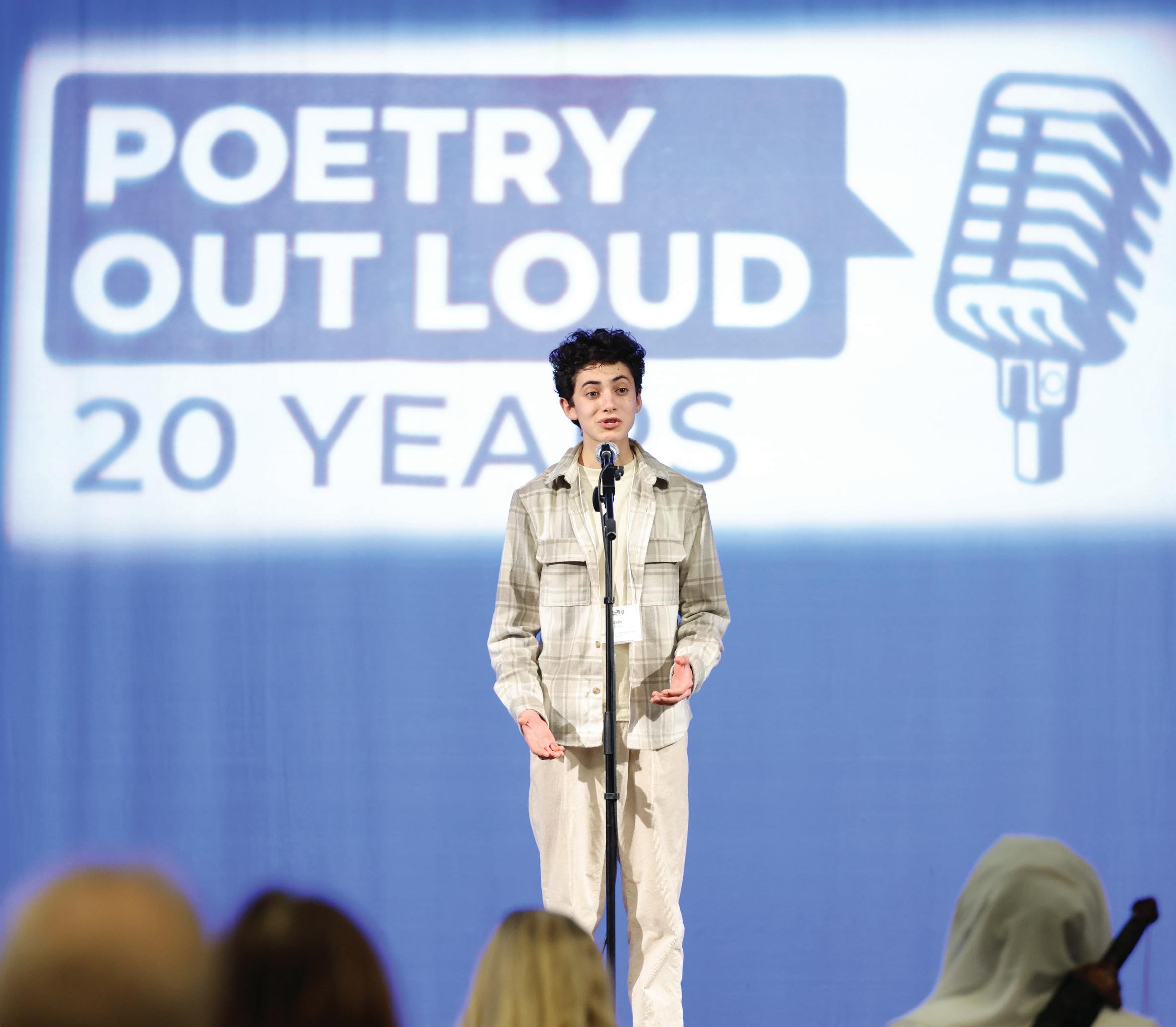
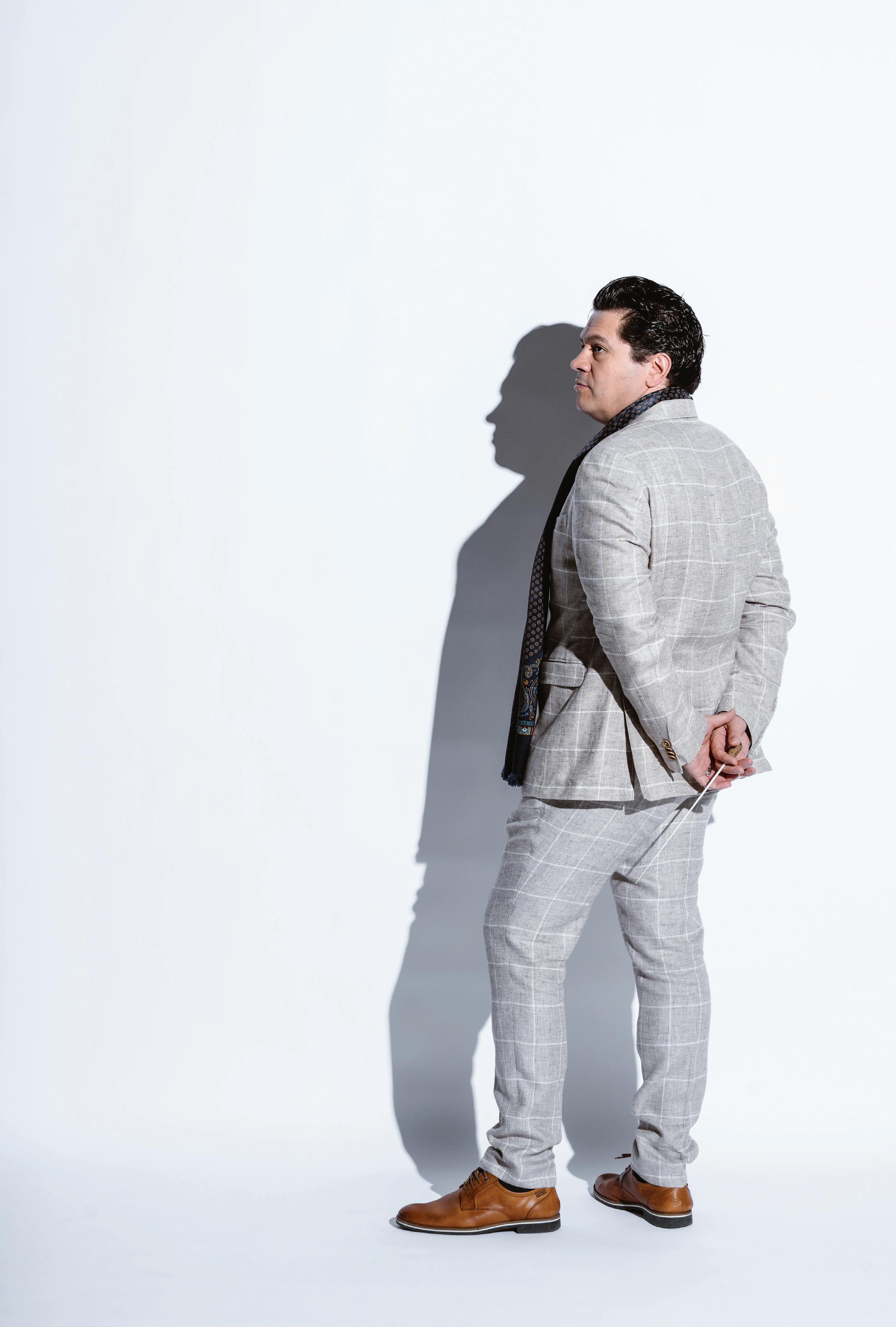
WWhen CSO Music Director Cristian Măcelaru first met Yo-Yo Ma, the cellist posed a question to him that took him aback: Who was he, and where was he coming from?
Măcelaru decided to answer Ma through music, and he didn’t have to think particularly hard about which piece: George Enescu’s Romanian Rhapsody No. 1, one of the composer’s most-performed works.
“It really, truly speaks of the beauty of the folklore, the traditions, the rhythms and the dances,” Măcelaru says.
Like so many Romanian musicians, Măcelaru considers Enescu “a personal hero.” The young Enescu was hailed as a musical phenom along the lines of Mozart, Korngold and other precocious talents. He was not only a world-class composer but also a conductor, violinist and pianist. Yehudi Menuhin, his former violin student, idolized him; Alfred Cortot, considered one of the 20th century’s greatest pianists, apparently claimed that his keyboard technique was outclassed by Enescu’s. The small village in which Enescu was born, in northeast Romania, has since been renamed in his honor.
In some ways, Măcelaru’s career path echoes Enescu’s. As a conductor, Enescu was accomplished
enough that he became a serious contender for the directorship of the New York Philharmonic after Arturo Toscanini resigned in 1936. For Măcelaru, composing was an early professional ambition; he attempted to write his first symphony as a teenager. Both, too, were virtuoso violinists: Enescu concertized throughout the U.S. and Europe, sometimes on the same programs he conducted, and Măcelaru’s talents on the instrument kickstarted his musical career.
At the time he connected with Fanfare Magazine for this story, Măcelaru had just wrapped a long day recording Enescu’s Suite No. 3 with the Orchestre National de France, with whom he is releasing a multiyear, six-disc recording project for Deutsche Grammophon. The venerable German label unveiled the first three discs as a box set last April. Since then, it has garnered a bevy of industry awards, like the Diapason d’Or and a spot on Gramophone’s 2024 critics’ choice shortlist.
“Receiving an award is not the reason why we do recordings,” says Măcelaru, “but it is such a beautiful validation of one’s effort, if for no other reason than to see so many people recognize [Enescu’s works] as really, truly being cornerstones of the classical music repertoire.”

Left: Violinist George Enescu (1881–1955) and pianist Alfred Cortot (1877–1962) (Credit: E. Joaillier, Paris). Below: A violin owned by George Enescu in a museum in Bucharest, Romania.
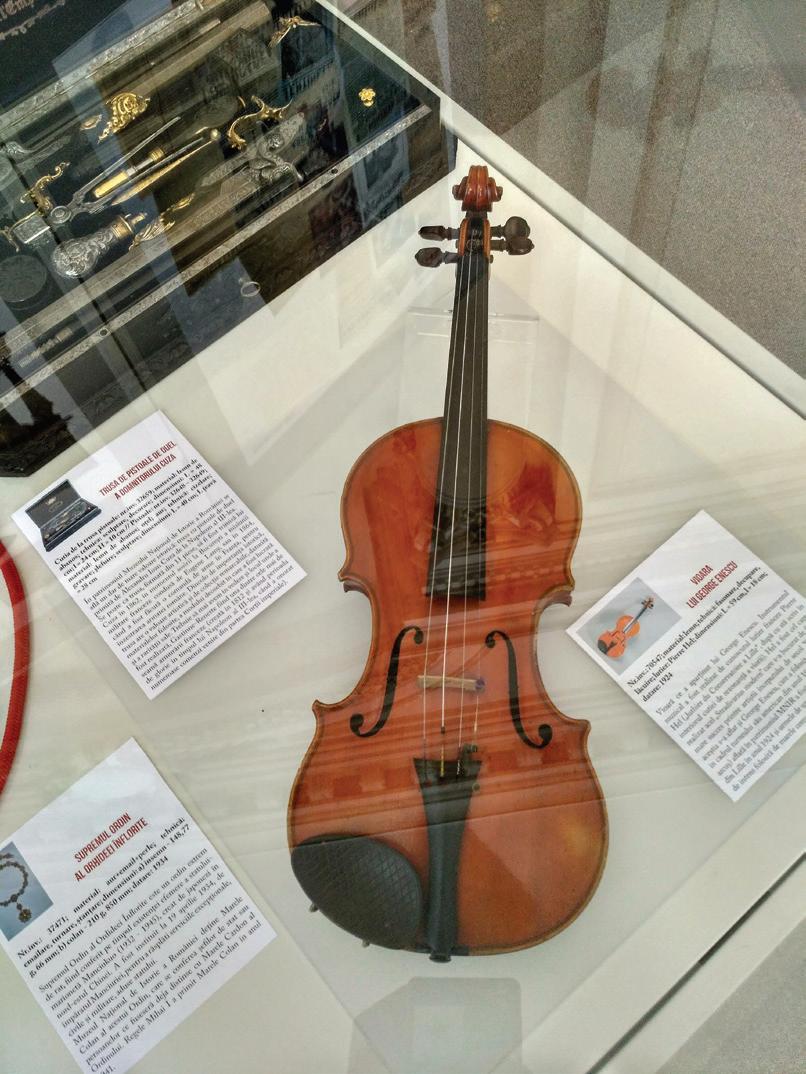
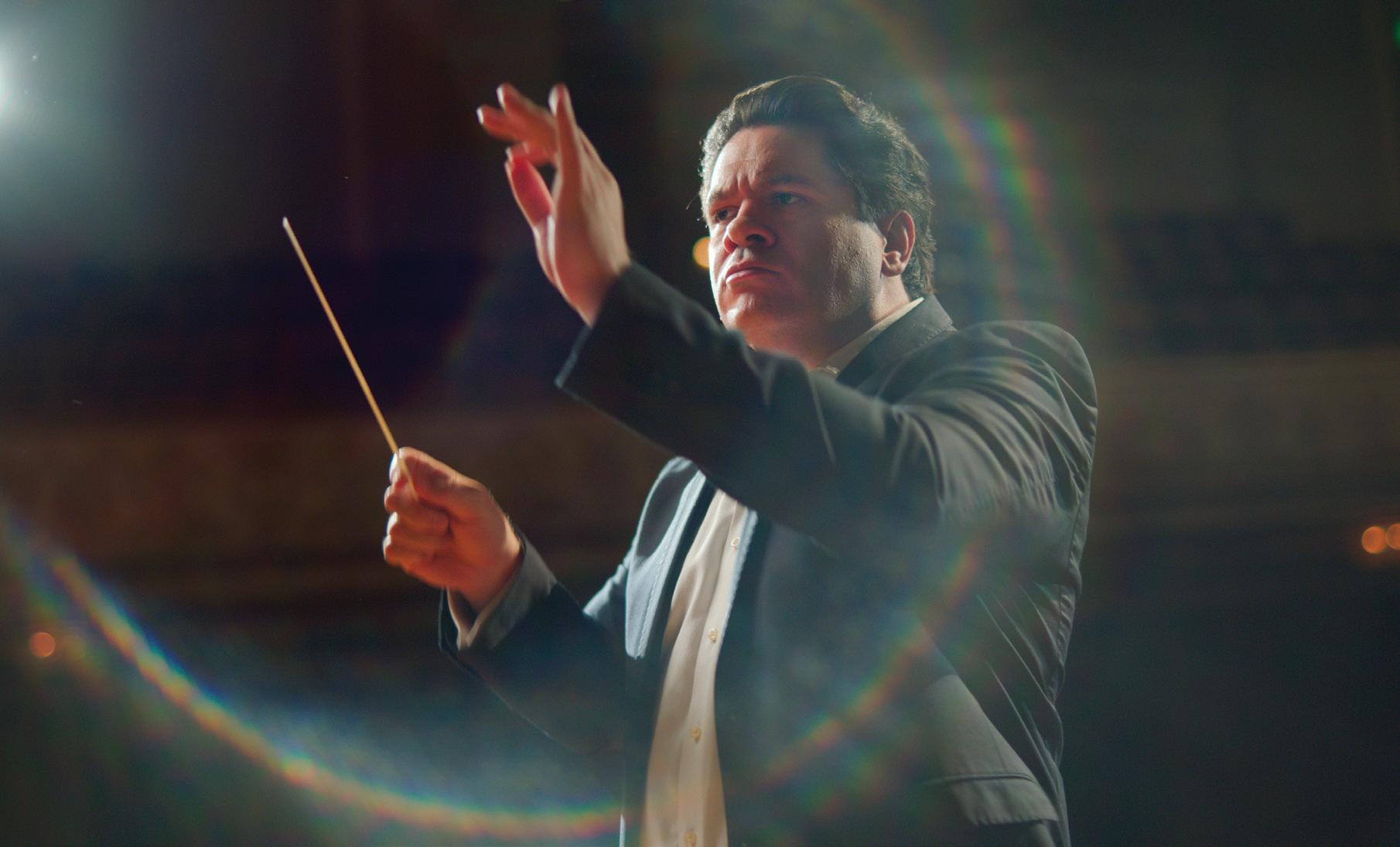
Enescu’s legacy has been far from assured. He’s known mostly for his Rhapsody No. 1 and violin sonatas, still frequently played and recorded. But performances of his works have been somewhat few and far between outside Romania. When Măcelaru began preparing for the Deutsche Grammophon recordings, he had to correct “hundreds, maybe thousands” of inconsistencies between the printed editions of Enescu’s music and his own manuscripts.
Ironically, for a time, Enescu’s star status was lost on his own home country. Because Enescu lived outside Romania for so much of his career, he wasn’t seen as a national symbol in the same way he is today — and Romania’s Eastern Bloc government was especially loath to champion an émigré who had married into the old aristocracy. Even the biennial George Enescu Festival, which Măcelaru also directs, wasn’t established until three years after the composer’s death, in 1955.
Enescu’s life bridged the 19th century with the long 20th. His music is predominantly tonal and lush but, much like his contemporary Richard Strauss, he deploys those harmonies toward narrative and often daring ends. One of Măcelaru’s favorite examples of this comes at the middle of Enescu’s Suite No. 3, nicknamed “Villageoise,” or “of the village.” A shepherd, represented by an offstage oboe, tries to soothe his sheep, their braying depicted through the drone of a pump organ and stinging brass clusters.
To Măcelaru, Enescu’s music also captures the complexity of the émigré experience. Enescu’s family
moved him to Vienna when he was just seven to support his meteoric musical talents. He eventually settled in Paris — yet another parallel with Măcelaru, who lives there when he’s not in Cincinnati — where he died and was buried.
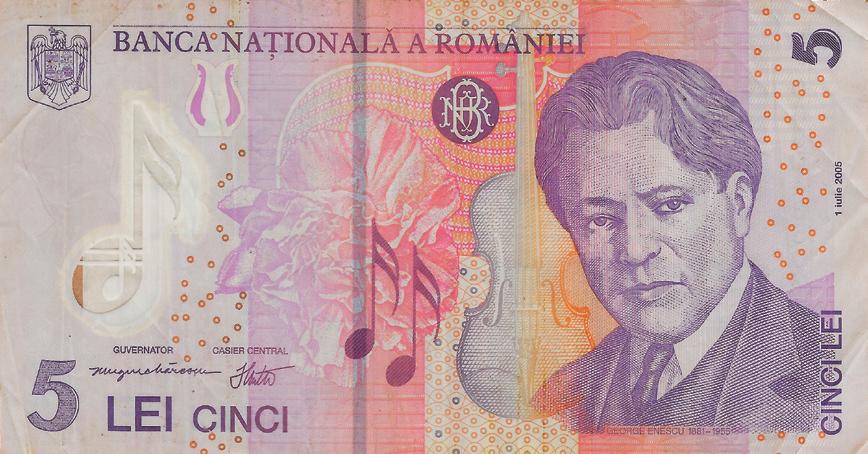
The Romanian 5 lei bill, since 2005 featuring Enescu’s image.
Măcelaru believes Enescu’s distance to his homeland gives his folk themes both a certain “purity” and a “melancholic twist.”
“Enescu always wrote about Romanian culture and folklore traditions from an immigrant’s perspective, trying to tell you how beautiful the country is that he left behind,” he says.
But Enescu’s music just as frequently absorbed the sensibilities of his chosen home. Măcelaru identifies Enescu’s approach to orchestration as distinctly French: bursting with maximalist color, yet contoured and fine-grained.
“He wrote so many indications on every note. I really think he was trying to capture the spirit of a style of playing,” Măcelaru says.
Meanwhile, the Orchestre National de France is the Parisian orchestra that “has maintained and kept the focus of the [French] style” most, according to Măcelaru. It made them an ideal recording partner for the project.
“I think that if anyone wants to really, truly do research into the French style of playing from 100 years ago, they need to look at Enescu’s symphonies,” Măcelaru asserts.
As a busy touring musician, Enescu made his way to the United States — and often. He led several back-to-back concert cycles a year at the New York Philharmonic between 1937 and 1939. In 1939, he was invited to New York City again to lead the Philharmonic in a program of Romanian music as part of that year’s World’s Fair. “None of the foreign programs given at the Fair have had a more
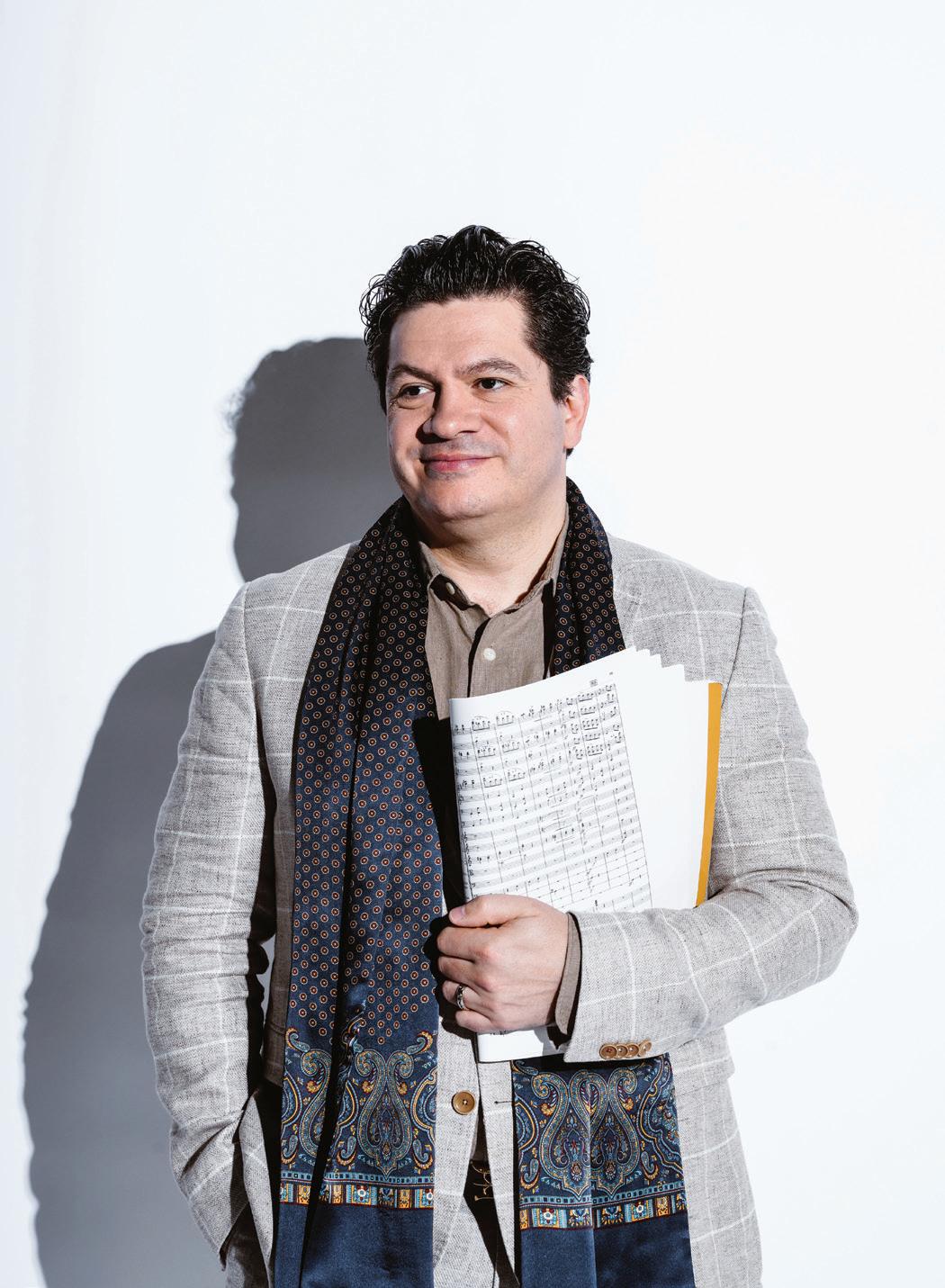
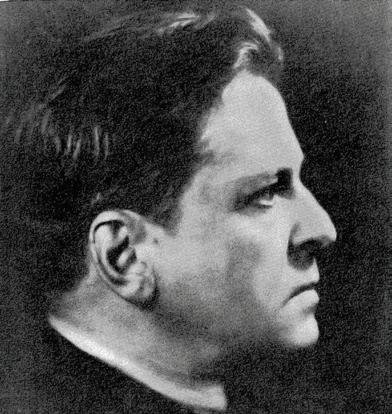
George Enescu visited the CSO four times, as both conductor and violin soloist:
February 1933. Enescu played Mozart’s Violin Concerto No. 7 and conducted his own Romanian Rhapsody No. 2.
December 31, 1937 and January 1, 1938. Enescu played Mozart’s Violin Concerto No. 7 and conducted his Symphony No. 1 in E-flat, Op. 13.
April 1948. Enescu played Bach’s Violin Concerto No. 1 and Chausson’s Poème and conducted his own Romanian Rhapsody No. 1 in A Major, Op. 11.
February 1949. Enescu played Mozart’s Violin Concerto No. 7 and conducted his own Suite No. 2 in C Major and Romanian Rhapsody No. 2.
Reviews from local critics were glowing:
The Cincinnati Enquirer, February 24, 1933 by George A. Leighton
“The Rhapsody is a series of impassioned utterances expressed in folk tunes pleasantly harmonized and skillfully orchestrated. It is a relaxing piece with its melodic charm, comfortable rhythms and clearly defined sectional divisions.
“As soloist, Enesco played Mozart’s D major Concerto, demonstrating the artistry for which the is so well known. His Mozart playing is far from conventional or traditional, and the great pleasure derived from his performance was more traceable to the artist than his vehicle. The same emotional temperament that created the Rhapsody was to be found in the Concerto and auditors reveled in wonder of tone, great depth of feeling, and exceptional violinism in every respect. The second movement with its exquisite melodic lines and the final Rondeau, sharply rhythmical and happy in thought, gave the best opportunities for display of the artist’s fine capacities.”
The Cincinnati Enquirer, January 1, 1938 by Frederick Yeiser
“What a man, this Georges Enesco! And what a tremendous musical figure!
“Both as solo violinist and conductor Mr. Enesco gives the impression of combining both emotional and intellectual power. … Although the music comes first for him, the strength of his personality never ceases to make itself felt.
“He has expressed himself with insight and feeling through billowing phrases of melody which his gift for orchestration leads him to color in a variety of ways. The Cincinnati Symphony Orchestra gave one of the most spontaneous performances that I have ever heard. The men played as though inspired, as they probably were. At the end, Mr. Enesco gave them the signal to rise and share his ovation but they let him have it all to himself.”
distinctive and unmistakable color than this one,” enthused The New York Times
Enescu even visited the CSO four times as both conductor and violin soloist in the same period. The discovery that his hero had been to Cincinnati “tickled” Măcelaru.
“I think it speaks to how important Cincinnati was on the national circuit,” he says. “While being a little bit out of the main East Coast route, that part of the country was quite prosperous, which led very much to a really beautiful, world-class orchestra. That, of course, attracted Enescu.”
But Măcelaru also noticed something surprising: In many of the concerts he led while in the U.S., Enescu conducted his own music sparingly. Instead, he mainly seemed to promote works by other
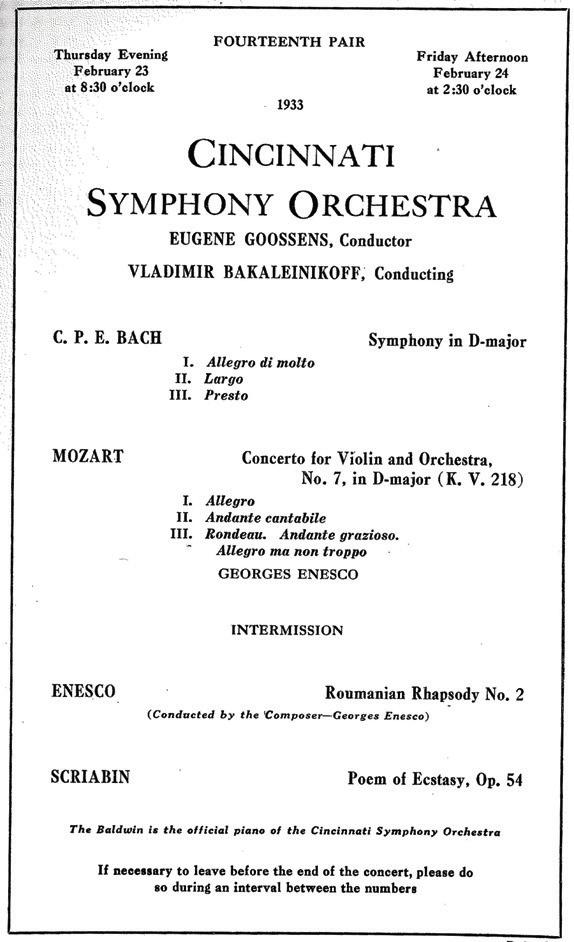
living Romanian composers, some of them world premieres. Later in life, he would contribute the modern equivalent of $150,000 to create the first competition specifically for Romanian composers.
“I think it’s a really wonderful mission that he assigned himself, to promote a Romanian national school of composition,” says Măcelaru.
One with a direct line to the CSO’s new Music Director, no less.
Subscribe to the CSO’s YouTube channel and watch the three-part docuseries: Introducing Cristian Măcelaru.
@CincySymphony

The Cincinnati Post, April 10, 1948 by
Eleanor Bell
“The presence of George Enesco had an electrifying effect on the doing in Music Hall yesterday.
“The great Roumanian composer, conductor and violinist was making his first appearance here since before the war, and both the sight and sound of him brought tears to many eyes and great surging bursts of applause for his artistry and musicianship.
“He played the Bach Concerto in A-minor and the Poème by Chausson with flawless phrasing and style, and with that grand and elegant seriousness that has always set him apart from the common garden variety of virtuoso.
“His performance was amazing.”
Cincinnati Symphony Orchestra program listings from the February 23 & 24, 1933 and April 9 & 10, 1948 concerts featuring Enescu as violinist and conductor.
The Cincinnati Post, February 21, 1949 by Eleanor Bell
“Mr. Enesco’s reading of Mozart’s Concerto No. 7 in D-major for violin and orchestra was filled with all of the grace and charm and eloquence and superb musicianship we have come to expect from him.
“Under M. Enesco’s abbreviated baton the orchestra came to life in his Second Romanian Rhapsody and the Suite No. 2 in C-major. Both of these works were ingeniously orchestrated so that there was never any doubt as to the intended mood, and the musical ideals were skillfully projected through the language by one who is by all standards more fluent than most. Aside from their remarkable craftsmanship, however, both the Rhapsody and the Suite had flashes of humor and contrasting moments of pathos that were meant to be enjoyed by the least informed layman.”
by CSO STAFF
by CSO STAFF
Throughout Cincinnati, autumn holds an air of anticipation. Students return to school, festivals return to the parks and concerts return to Music Hall. For the Cincinnati Symphony Orchestra, this season not only carries the warmth of return, but also the thrill of new beginnings. Music Director Cristian Măcelaru made his debut with the CSO October 3–4, and this will be Robert McGrath’s first full season as President & CEO. Completing the trio of leadership is Board Chair Charla Weiss. Each of these leaders plays a distinct but complementary role, shaping the artistic vision, managing the organization and ensuring strong guidance so the Orchestra can thrive both on stage and within the community.


Throughout Cincinnati, autumn holds an air of anticipation. Students return to school, festivals return to the parks and concerts return to Music Hall. For the Cincinnati Symphony Orchestra, this season not only carries the warmth of return, but also the thrill of new beginnings. Music Director Cristian Măcelaru made his debut with the CSO October 3–4, and this will be Robert McGrath’s first full season as President & CEO. Completing the trio of leadership is Board Chair Charla Weiss. Each of these leaders plays a distinct but complementary role, shaping the artistic vision, managing the organization and ensuring strong guidance so the Orchestra can thrive both on stage and within the community.
It is widely accepted that the Board Chair is a position that, beyond a deep commitment to the organization, requires strong leadership qualities and high ethical standards. This is why it is clear that Charla Weiss — who took the helm at the start of the 2025–26 season — was the perfect complement to this leadership trio. Weiss is no stranger to the complex nature of a large nonprofit organization. She recently retired from Cincinnati Children’s Hospital Medical Center after 13 years of service as the Director of the Office of Diversity and Inclusion.
It is widely accepted that the Board Chair is a position that, beyond a deep commitment to the organization, requires strong leadership qualities and high ethical standards. This is why it is clear that Charla Weiss — who took the helm at the start of the 2025–26 season — was the perfect complement to this leadership trio. Weiss is no stranger to the complex nature of a large nonprofit organization. She recently retired from Cincinnati Children’s Hospital Medical Center after 13 years of service as the Director of the Office of Diversity and Inclusion.
When Weiss was hired at Cincinnati Children’s, she was creating something new, as her role had never existed at the hospital. She stated her goal was to “increase the cultural competency of all those who interacted with all patients to make sure that everyone got extraordinary medical care.” This included starting a resident fellowship program for hospital administrators who were from underrepresented populations in the healthcare profession.
When Weiss was hired at Cincinnati Children’s, she was creating something new, as her role had never existed at the hospital. She stated her goal was to “increase the cultural competency of all those who interacted with all patients to make sure that everyone got extraordinary medical care.” This included starting a resident fellowship program for hospital administrators who were from underrepresented populations in the healthcare profession.
Weiss had no easy task at Cincinnati Children’s. The hospital world exists at an intersection between patients, doctors, education systems, insurance companies, cultural and religious beliefs, and a whole host of places in between. This may be overwhelming for some, but Weiss is an expert. “I love the complexity of people,” remarks Weiss. “I like looking at complex organizations and finding my way to help the organization move forward.”
Credit: Claudia Hershner
Weiss had no easy task at Cincinnati Children’s. The hospital world exists at an intersection between patients, doctors, education systems, insurance companies, cultural and religious beliefs, and a whole host of places in between. This may be overwhelming for some, but Weiss is an expert. “I love the complexity of people,” remarks Weiss. “I like looking at complex organizations and finding my way to help the organization move forward.”
In addition to her incredible wealth of knowledge Weiss also brings a unique perspective. From being a Black child attending grade school on a Native American reservation in South Dakota to, as an adult, living in Hong Kong for seven years, she has refined her ability to interact with and embrace all people. Her experiences as a global citizen, enriched by music and life, led her to the field of psychology and sociology. She ultimately earned her Ph.D. while
In addition to her incredible wealth of knowledge Weiss also brings a unique perspective. From being a Black child attending grade school on a Native American reservation in South Dakota to, as an adult, living in Hong Kong for seven years, she has refined her ability to interact with and embrace all people. Her experiences as a global citizen, enriched by music and life, led her to the field of psychology and sociology. She ultimately earned her Ph.D. while

working full time at the University of Michigan. Therefore, when the opportunity arose to take on the position of CSO Board Chair, Weiss was undaunted. It’s clear why the CSO wanted to work with Weiss, but why did she agree?
Weiss has always loved music. As a child she learned piano, and as a teenager she earned a scholarship to spend the summer at the prestigious Interlochen Center for the Arts for voice. Yes, Charla Weiss attended the very same arts school that Cristian Măcelaru attended, also as a teenager.
“This season carries an incredible sense of anticipation and hope.”
“This season carries an incredible sense of anticipation and hope,” affirms Weiss. “Cristi’s presence marks the beginning of a bold new chapter — one that honors the CSO’s rich 130year history while embracing fresh energy, vision and possibility. It truly feels like a moment of transformation, and I couldn’t be prouder to be part of it.”
The Orchestra was founded in 1895, and since then there had only been 13 first Music Director concerts and, now with Măcelaru, 14. It is a momentous time for Weiss to begin this tenure. The Măcelaru era is one that will completely transform not just the CSO, but the entire Cincinnati arts community.
A key relationship for any Music Director is the one with the Orchestra’s chief executive. In the case of Măcelaru, this relationship is with Robert McGrath, newly appointed President & CEO of the Orchestra. McGrath isn’t new to the CSO, however.
He is a 14-year veteran of the organization, having previously served as Chief Operating Officer. A consistent, steady force behind the Orchestra’s resilience, McGrath played instrumental roles during the Covid-19 pandemic and Music Hall renovation. From the creation of CSO Proof and the 2019 Fanfare Project to the Live from Music Hall digital concert series, McGrath has made a lasting mark on the CSO’s artistic and community initiatives.
—Charla Weiss
In her new role as Board Chair, Weiss says her responsibility is to “advocate for the Board within the community, with community being defined very broadly. It is to partner with the leaders and teams of the organization to make sure they have what they need to be successful at their jobs. And to be a strong partner to the Music Director and President & CEO. “These three strands are what I think will keep the organization moving forward and make sure that the people who were with the organization 130 years ago say, ‘they’re doing better than we thought they could.’”
In a 2025 Fanfare Magazine interview, McGrath said about the CSO, “This is an organization that has always been determined for greatness.” With this new trio of leaders, perhaps it isn’t the amorphous “organization” that has determined the CSO’s greatness, but rather the leaders who recognize and honor past guidance while pushing the organization to strive for a better tomorrow.
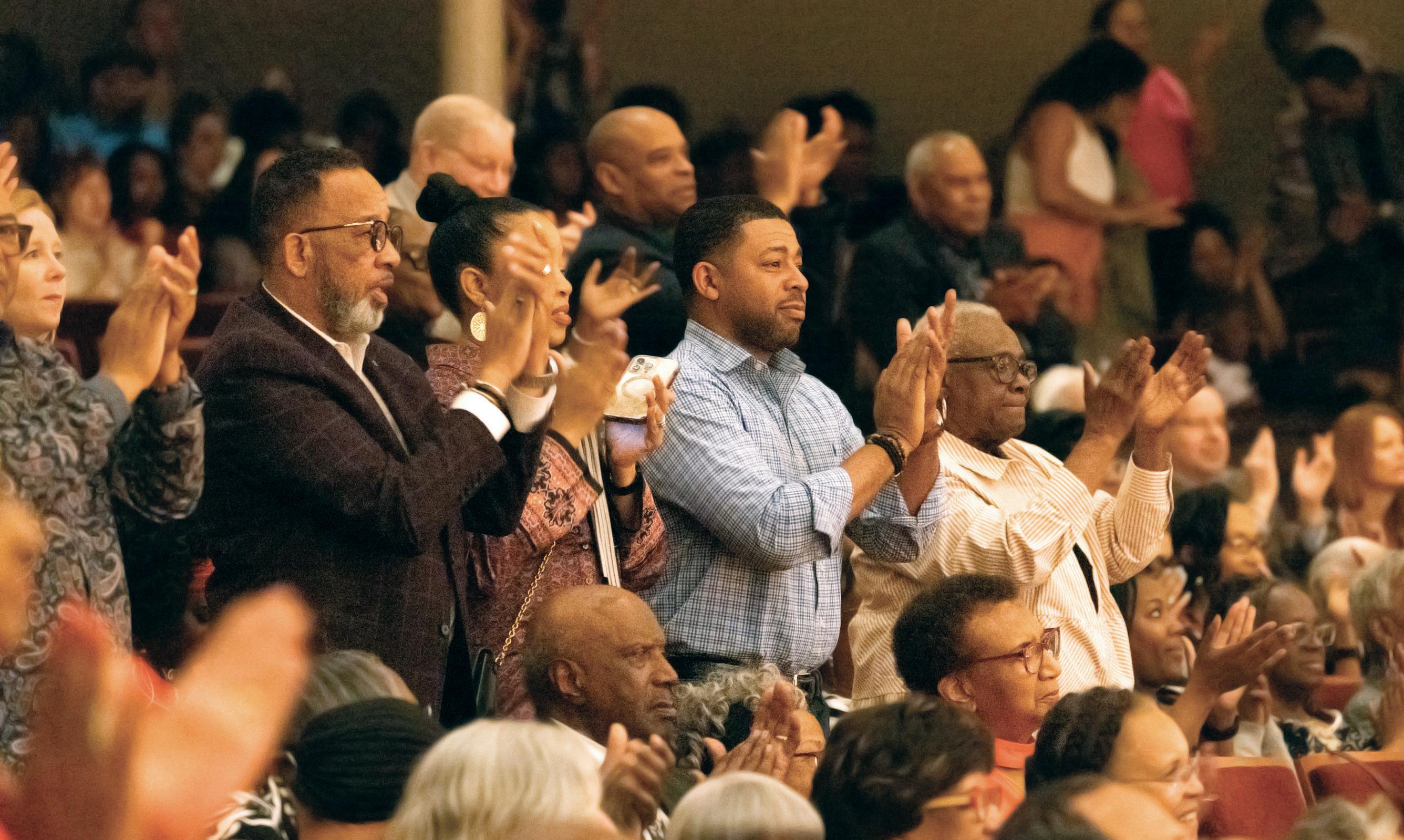
by ANNE ARENSTEIN
Every part of maintaining a healthy lifestyle can be tracked on your phone’s health apps. Everything from steps to sleep patterns can be charted. Well, almost everything. Minutes listening to live classical music should be on the list.
There’s compelling scientific evidence that live music, especially classical music, has a positive impact, from improving breathing and heart rates to increasing sociability.
Last May, the May Festival’s 2025 Festival Director Renée Fleming hosted a discussion on “Music and Mind,” focusing on the intersection of music, health and neuroscience. Fleming is a passionate advocate for research on music and the mind. She edited Music and Mind: Harnessing the Arts for Health and Wellness, a collection of essays by leading experts in science and the arts, and the book the event was titled after. The panelists represented psychology, neurology, music therapy and early childhood education.
During the discussion, Stacy Sims, founder and executive director of The Well, a Cincinnati-based organization whose mission is to improve the human mental and emotional well-being, connectedness
and effectiveness through arts integration, especially music, provided compelling evidence for music’s impact on human behavior.
The Well’s Mindful Musical Moments program, geared toward school children, combines creative and mindful prompts with three minutes of orchestral, jazz, world and new music heard at the beginning of the school day. The results are dramatic. Teachers report that listening to music helps students to focus and reduces anxiety. Mindful Musical Moments is now in more than 300 schools, including Cincinnati Public Schools. Utah’s state board of education is implementing the program statewide, Sims reported.
In 1993, a scientific study claimed that listening to Mozart temporarily increased spatial reasoning. Popular media dubbed this “The Mozart Effect,” adding now-debunked claims of boosted intelligence, particularly in young children. However, this sparked interest that led to subsequent studies that used advanced technologies like fMRI (functional magnetic resonance imaging) to provide proof that listening to music improved well-being across the spectrum of physical and emotional health. The findings ranked live music superior to recordings, in terms of brain stimulation.
As part of her personal research, Fleming participated in a fMRI study as part of the National
Institutes of Health’s Sound Health initiative to understand how music affects the brain. While in the MRI scanner, she performed activities like singing and imagining singing, with the goal of identifying which parts of the brain are activated by music. The fMRI showed that imagining singing activated more brain regions than singing itself, which was a surprising finding for the scientists. In an interview with CityBeat, Fleming said that seeing the result of her fMRI as she sang or listened to a live performance was a revelation, noting “I marveled at how responsive my brain is to these sounds, how much activity was going on in there!”
A Swiss study conducted in 2023 and published on the National Institute of Health’s (NIH) National Library of Medicine web page demonstrated that live music — piano performance in this study — produced higher activity in the amygdala, the brain’s emotion center. The study also found people could focus more when exposed to live music, noting enhanced neural flow between the regions of the brain that filter out distractions and manage information processing.
Research from the past two decades confirms that live music benefits the brain in other significant areas. The NIH’s Medical Library lists references to studies on music affecting mental and physical ailments, from anxiety to tinnitus. If you play an instrument, the health benefits increase even more. Regular practice and performance help stimulate neural connections and establish new ones. Playing or singing in an ensemble gets those neurons working, as well as encouraging social interaction.
It doesn’t matter who the composer is or whether it’s a suite, a full symphony or a concerto, live classical music has been shown to produce dopamine (vital to movement, motivation and mood — so-called 3M) and reduce cortisol (high cortisol can have negative affects on neural and cognitive function).
Moreover, researchers Aaron Williamon, professor of performance science at the Royal College of Music, and Daisy Fancourt, professor of psychobiology and epidemiology at University College London, noticed that blood pressure was reduced and heart rates lowered after live musical events. Live music experiences can even act as a natural pain management method; concerts can help to relieve physical pain by triggering the release of endorphins, which reduce a person’s perception of pain, or even intercepting pain signals before they reach the brain.
Then there’s the social aspect of enjoying a live musical performance. When you choose to attend a Cincinnati Symphony Orchestra concert, the experience can make you feel like a part of a community. During breaks, you may be discussing the performance with the folks around you. A lyric passage may move you to tears or a rollicking finale may bring you to your feet, yelling “Bravo!” There will be others who share those emotions.
Live music doesn’t promise to heal serious illnesses or chronic conditions, but it can promote improvement in mental outlook and physical wellbeing, as well as reductions in blood pressure and heart rate. Whether you’re here to heal your body or heal your soul, there are always good reasons to keep listening.
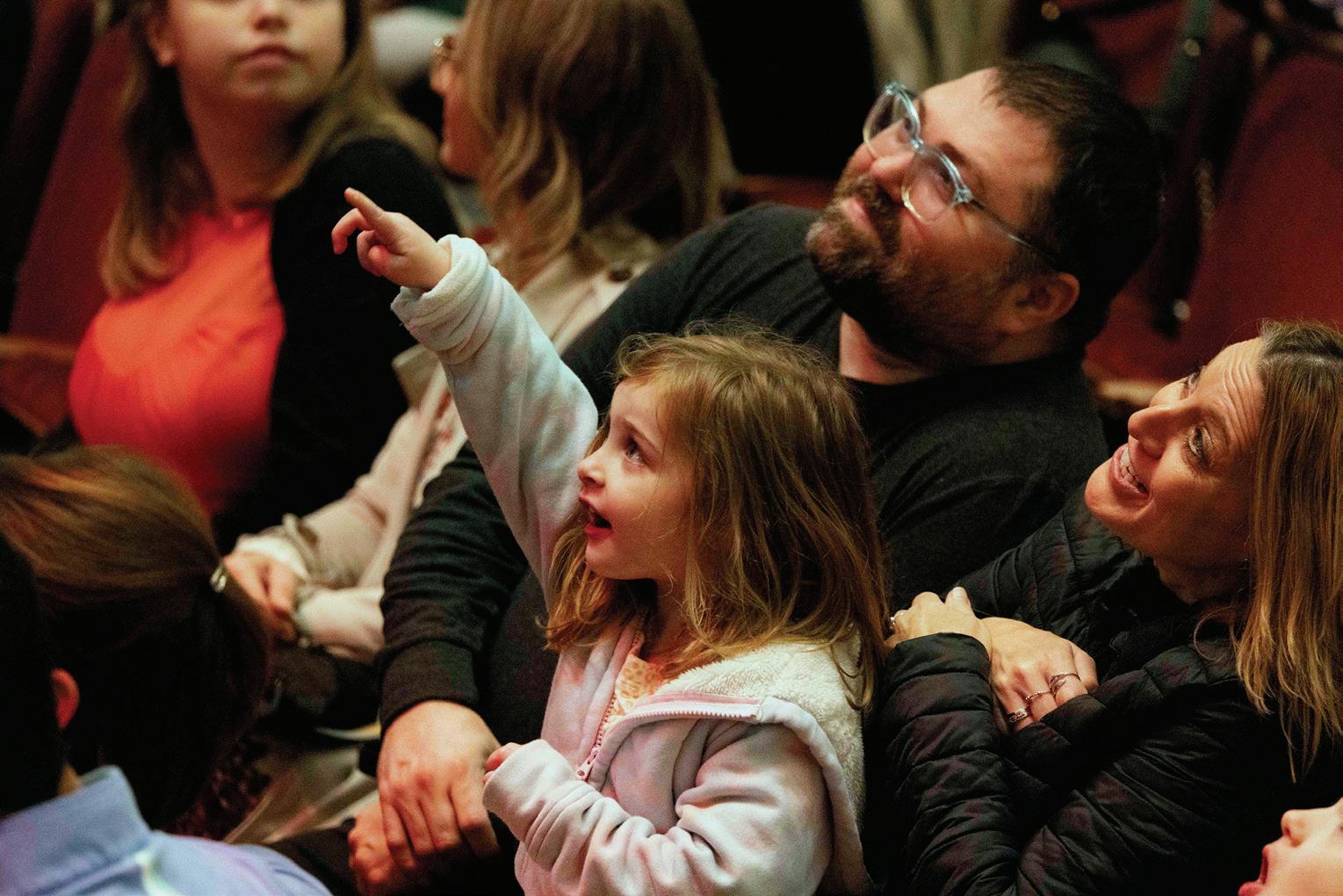
Music has the power to transport us back to moments that shaped us. For our musicians, certain music holds a special connection to memory, identity and belonging. We asked them a simple but meaningful question: “What music brings you home?” We invite you to explore their answers and perhaps reflect on the question yourself.
Denisse Rodriguez-Rivera
Viola
I listened to Beethoven’s symphonies early on in my musical life, so I feel at home performing them.
Joseph Rodriguez
Second/Associate Principal Trombone
Sallie Robinson Wadsworth & Randolph L. Wadsworth Jr. Chair
I grew up with country gospel music. Anytime I hear that southern twang, it takes me home to my childhood.
Rachel Charbel
Violin
Ida Ringling North Chair
I always think of my hometown (Bellingham, Washington) every time I hear Sibelius, specifically his Fifth Symphony. Sibelius said that the theme to the last movement was inspired by watching a flock of swans fly overhead, which is something I’m very familiar with, as Bellingham is a stopover point for a massive trumpeter swan migration. My mom also thinks the first movement feels like a boat leaving a harbor for open waters, and I completely agree!
Joanne Wojtowicz
Viola
When I cross the bridge over the Detroit River into my hometown of Windsor, Ontario, I can’t help but hear Calixa Lavallée‘s “O Canada.”
Caterina Longhi
Viola
Shostakovich’s Symphony No. 5 was one of the first major symphonies I played when I was 13 and a member of the New York Youth Symphony. It was my first time as a violist realizing how thrilling orchestra playing could be!
Michael Rau
Violin
The Beethoven violin sonatas, specifically the Isaac Stern/Eugene Istomin recordings. These were a favorite of mine to listen to while driving to violin lessons.
Christopher Philpotts
Principal English Horn
Alberta & Dr. Maurice Marsh Chair
Even though I have played this solo a gazillion times, I never tire from hearing it. Dvořák’s Largo from the New World Symphony is a warm hug of goodness!
Haley Bangs
Flute
Jane & David Ellis Chair
John Williams’ score to Jurassic Park always reminds me of my childhood. It was the first PG-13 movie I was allowed to watch, and my best friend and I loved it so much we had to watch it every time we had a sleepover party!
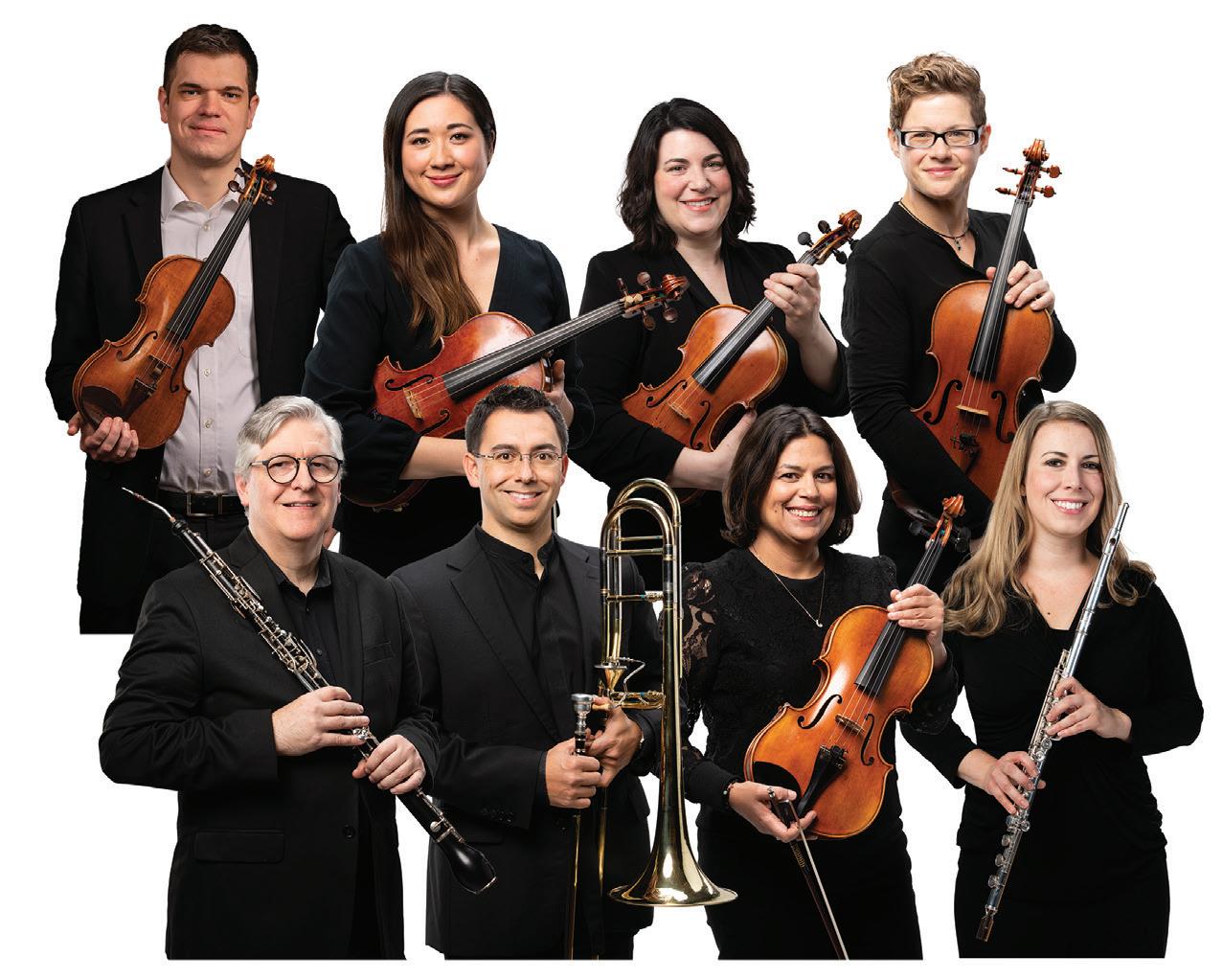
This season, audiences will see three new faces on Music Hall’s stage. Learn more about their musical journeys and what brought them to Cincinnati.
by DAVID LYMAN
David Smith
Acting
Associate Principal Horn
Ellen A. & Richard C. Berghamer Chair
David Smith had his heart set on being a drummer.
It didn’t work out that way. In September, he began a one-year appointment as Acting Associate Principal Horn with the Cincinnati Symphony Orchestra.
What changed? You have to go back more than 25 years, to when Smith was in the fifth grade.
“There was an assembly, a presentation by the middle school band,” says Smith, who is now 38. “I had no idea what a band was. But to any kid at that age, assemblies were the most interesting things in the world. You could escape the malaise of the classroom and see your friends.”
But by the end of the assembly, a whole new world had opened up to him.
“I thought that the band was the coolest thing I’d ever seen,” says Smith. “I wanted to join as soon as I could. I went home and told my family I wanted to play the drums.”
His parents were having none of that. They said he had two options, either pick another instrument or not play in the band.
So, he and the band director did a little brainstorming. Renting a trumpet — Smith’s second choice — proved too pricey. But since there were never enough kids who wanted to play French horn, they had a couple of instruments in storage. Smith’s parents could rent one of them for $25 for the entire academic year.
Unlike many of his orchestral colleagues, who grew up hearing classical music all the time, Smith’s love of the horn grew from listening to movie scores.
“There were composers like John Williams — the greatest of all time — and Michael Giacchino and Howard Shore. You’d see Jurassic Park or Harry Potter or Lord of the Rings and you would hear the complete breadth of what the horn could do. You’d get the heroic moment, the sappy moment, the break-your-heart moments. I could never forget those moments.”
Though his love for the instrument was immediate, there’s a steep learning curve to the horn.
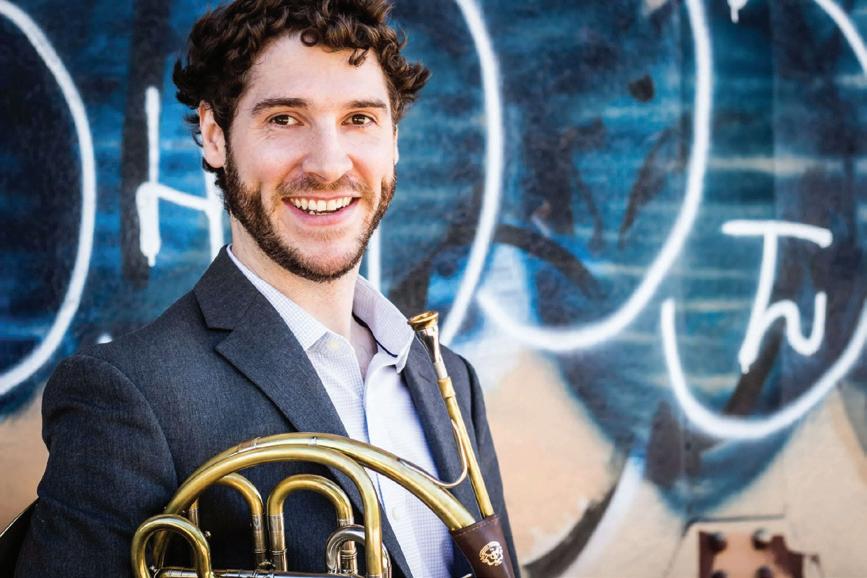
“I was rubbish in the sixth and seventh grade,” he says. But in ninth grade, the family moved to Myrtle Beach, South Carolina. There, Smith got his first private lessons, and, the following year, he was accepted into the South Carolina Governor’s School for the Arts and Humanities.
“Fifteen-year-old me was super-excited,” he says. “I got to leave the nest early. These ended up being the most formative years for me in my early training.”
Besides all the usual academic subjects, Smith had an intensive musical curriculum: music theory, music history, ear training, keyboard skills and more.
“I played in ensembles and learned about chamber music. I even had to sing in the choir. And the brilliant thing about it at the time was that it was free. You had to audition to get in. But this was a public education — it was free.”
Later, at the Peabody Institute, he would not only study horn performance but also recording engineering.
“My father was a very practical person,” says Smith. “While he wanted to support my dreams, he believed in things like financial security, so he thought it was important for me to have some backup plans in place besides being a professional horn player.”
Initially, Smith was skeptical. But in retrospect, he realizes it was a wise decision.
“I have zero regrets about learning every aspect of the music business,” he says. “It’s always great to soak up new knowledge. When I listen to an orchestra recording now, I can listen as a musician and also through a studio recording lens.”
His most immediate concern, though, is a monthlong Asian trip with his new wife, Natalie Hoe, the principal clarinet of The Florida Orchestra.
His most immediate concern, though, is a monthlong Asian trip with his new wife, Natalie Hoe, the principal clarinet of The Florida Orchestra.
“We got married in a courthouse here on May 29,” he says. “Then, we’re off to do the whole thing properly with her side of the family. Her mom is in Hong Kong and her dad’s side is from Malaysia. So we’re going to spend a month meeting family and then get married all over again on Pangkor Laut Island in Malaysia.”
“We got married in a courthouse here on May 29,” he says. “Then, we’re off to do the whole thing properly with her side of the family. Her mom is in Hong Kong and her dad’s side is from Malaysia. So we’re going to spend a month meeting family and then get married all over again on Pangkor Laut Island in Malaysia.”
Smith may not have ended up behind a drum set, but his journey shaped him into the musician he is today. Dreams change over time as new opportunities are presented. And now, those dreams have brought Smith back to Music Hall, where several years ago he had filled in a Holiday Pops concert.
Smith may not have ended up behind a drum set, but his journey shaped him into the musician he is today. Dreams change over time as new opportunities are presented. And now, those dreams have brought Smith back to Music Hall, where several years ago he had filled in at a Holiday Pops concert.
“We were in our red jackets and there was JMR in front of us,” says Smith. “The air was electric with energy. And now, to come back to that same stage every night and perform live in front of 2,000 people — it’s definitely going to be a thrill.”
“We were in our red jackets and there was JMR in front of us,” says Smith. “The air was electric with energy. And now, to come back to that same stage every night and perform live in front of 2,000 people — it’s definitely going to be a thrill.”
Michael Rau
Michael Rau
Section Second Violin
Section Second Violin
“The violin would not have been my first choice,” says Michael Rau, who is joining the Cincinnati Symphony Orchestra this season. As a violinist, mind you. “When my parents bought a used upright after my older brother started taking piano lessons, I would spend hours just staring at it, clearly wanting to play it.”
“The violin would not have been my first choice,” says Michael Rau, who is joining the Cincinnati Symphony Orchestra this season. As a violinist, mind you. “When my parents bought a used upright after my older brother started taking piano lessons, I would spend hours just staring at it, clearly wanting to play it.”
didn’t realize how odd that was. But once I picked up the instrument, you couldn’t pry it out of my hands.”
didn’t realize how odd that was. But once I picked up the instrument, you couldn’t pry it out of my hands.”
Exactly how thrilled was he? The day after his very first lesson was “show and tell” day at school, and he couldn’t help but show what he had learned.
Exactly how thrilled was he? The day after his very first lesson was “show and tell” day at school, and he couldn’t help but show what he had learned.
“I took in my violin and played the first four bars of ‘Twinkle, Twinkle Little Star.’ It was all I knew how to play. But I was determined to share it with my class. I guess I was really gung-ho about it from the start.”
“I took in my violin and played the first four bars of ‘Twinkle, Twinkle Little Star.’ It was all I knew how to play. But I was determined to share it with my class. I guess I was really gung-ho about it from the start.”
He was so enthused that, when all his friends dreamed of becoming astronauts or firemen, he told his father he wanted to be a violinist when he grew up. “Or a shortstop, if I’m being completely honest,” he adds. “But there was something about the violin that I loved, so I kept going on that path.”
He was so enthused that, when all his friends dreamed of becoming astronauts or firemen, he told his father he wanted to be a violinist when he grew up. “Or a shortstop, if I’m being completely honest,” he adds. “But there was something about the violin that I loved, so I kept going on that path.”
It’s a path that would, in time, lead him to the Chicago Youth Symphony, then the New England Conservatory of Music and, after graduation, to the New World Symphony in Miami.
It’s a path that would, in time, lead him to the Chicago Youth Symphony, then the New England Conservatory of Music and, after graduation, to the New World Symphony in Miami.
In retrospect, it sounds so ordered, so organized — as if Rau planned each step along the way. But, in truth, it wasn’t so very long ago that Rau was uncertain if he would continue the musical career he had chased for so many years. He was 28 when the Covid-19 pandemic shut down the arts in America. Since the New World Symphony only offers threeyear fellowships to its young musicians, Rau and his colleagues were taking every audition they could.
In retrospect, it sounds so ordered, so organized — as if Rau planned each step along the way. But, in truth, it wasn’t so very long ago that Rau was uncertain if he would continue the musical career he had chased for so many years. He was 28 when the Covid-19 pandemic shut down the arts in America. Since the New World Symphony only offers threeyear fellowships to its young musicians, Rau and his colleagues were taking every audition they could.
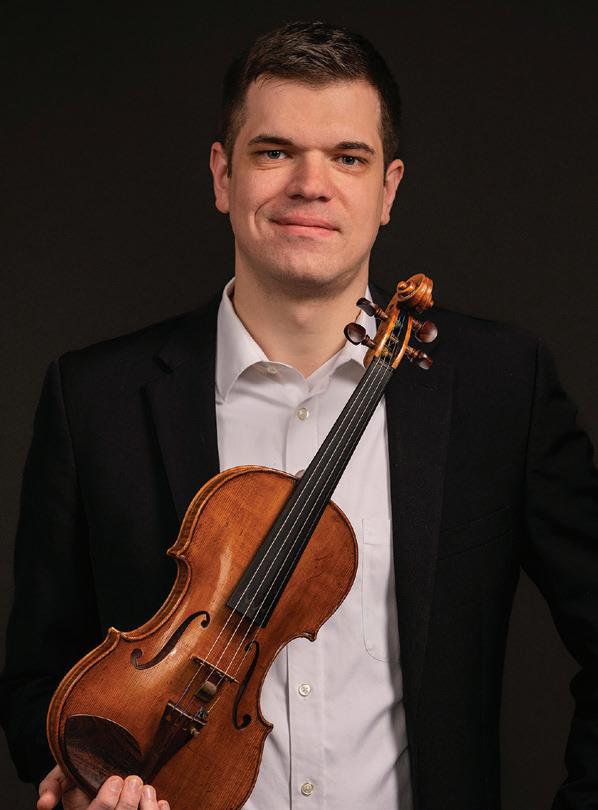
But even at the age of six, he and his brother had a reputation for being hyper-competitive in all things. Having both boys play the piano seemed like inviting trouble.
But even at the age of six, he and his brother had a reputation for being hyper-competitive in all things. Having both boys play the piano seemed like inviting trouble.
“I can’t say that my parents forced me to play the violin. But they suggested it would be better for me to take up another instrument,” says Rau. “There just happened to be a three-quarter-sized violin in my mother’s family.” So Rau ended up learning how to play the violin.
“I can’t say that my parents forced me to play the violin. But they suggested it would be better for me to take up another instrument,” says Rau. “There just happened to be a three-quarter-sized violin in my mother’s family.” So Rau ended up learning how to play the violin.
“It was a crazy instrument,” he recalls. “It had guitar pegs for tuning instead of regular violin pegs. I
“It was a crazy instrument,” he recalls. “It had guitar pegs for tuning instead of regular violin pegs. I
“The problem was that, when Covid hit, there were almost no auditions for a year and a half,” he says. “Even before that, the auditions were insanely competitive. That was a very tough time, not just for me, but for every musician trying to break into the field. I really had to take stock. Do I really want to do this? Realistically, what could I expect?”
“The problem was that, when Covid hit, there were almost no auditions for a year and a half,” he says. “Even before that, the auditions were insanely competitive. That was a very tough time, not just for me, but for every musician trying to break into the field. I really had to take stock. Do I really want to do this? Realistically, what could I expect?”
Fortunately, Rau persisted. And one of those auditions, in 2022, paid off.
Fortunately, Rau persisted. And one of those auditions, in 2022, paid off.
“That’s when I won the audition with the Baltimore Symphony Orchestra,” he says. Even though we are speaking on the phone, you can almost hear the grin in his voice. “Oh, man, that felt really great. All those years of degrees and lessons … .”
“That’s when I won the audition with the Baltimore Symphony Orchestra,” he says. Even though we are speaking on the phone, you can almost hear the grin in his voice. “Oh, man, that felt really great. All those years of degrees and lessons … .”
As much as he liked playing in Baltimore, when he heard about auditions for the CSO, he leapt at the chance. He’d played here as a substitute several times in the past and saw Cincinnati as a clear step up the musical ladder.
As much as he liked playing in Baltimore, when he heard about auditions for the CSO, he leapt at the chance. He’d played here as a substitute several times in the past and saw Cincinnati as a clear step up the musical ladder.
“I’m really excited about coming to Cincinnati,” he says. “I was amazed the first time I played with the Orchestra. I just love Music Hall. It’s really incredible how clearly you can hear everything. And it’s such a beautiful hall, too.”
“I’m really excited about coming to Cincinnati,” he says. “I was amazed the first time I played with the Orchestra. I just love Music Hall. It’s really incredible how clearly you can hear everything. And it’s such a beautiful hall, too.”
And then there is the opportunity to work with Cristian Măcelaru, the CSO’s new Music Director. As coincidence would have it, Rau was
And then there is the opportunity to work with Cristian Măcelaru, the CSO’s new Music Director. As coincidence would have it, Rau was
guesting with the CSO the week that Măcelaru’s appointment was announced.
“Then the week after that he came to Baltimore. So, I had two weeks with him, back-to-back. I loved both weeks. He’s fantastic to work with. He’s a violinist, you know. When he’s up there in front of you, it’s almost like he’s another member of the orchestra. Cristi is just fantastic to work with. I can’t wait to start there.”
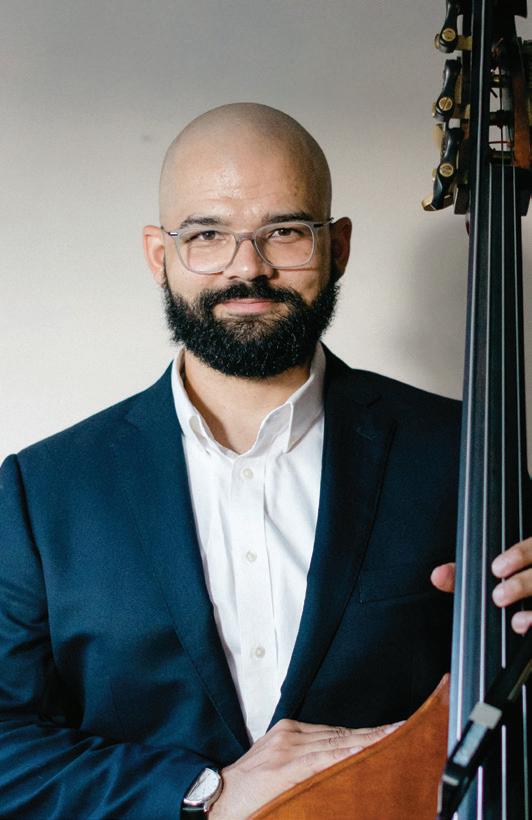
“This feels totally surreal,” says Michael Martin, reflecting on his appointment as a member of the bass section of the CSO. “I keep pinching myself. This is something I’ve been doing seriously since I was 13 years old. So to finally get to do what I’ve worked for since I was a young teenager … well, it just feels like it’s happening to someone else.” His excitement is understandable. There are precious few fulltime orchestra positions in the country, fewer still when you’re talking about top-flight orchestras like the Cincinnati Symphony Orchestra.
“I feel supremely lucky,” he says.
Now, luck is a fine concept. But that’s not what drove Martin’s success. His journey with the double bass began when he was in the third grade back in Allentown, Pennsylvania. His family was not a particularly musical one. Neither of his parents played an instrument, other than his father’s brief dalliance with the trumpet when he was very young.
But there was something about the bass’s raw, rumbling sound and the idea of making music with an instrument nearly as big as him that was profoundly appealing to Martin. Even though no one else in the home was playing an instrument, Martin says that “music was a constant in my life. Any time I was in the car, there was music playing. Both my parents had pretty well-developed musical tastes. My dad really likes Bill Withers and Marvin Gaye. And my mom would listen to Metallica and Led Zeppelin and AC/DC.”
True, that’s not the style of music that dominates Martin’s playing today.
“But I was richer for the broad gamut of music I was exposed to,” he says. “I learned what was good music and what wasn’t. Those lessons are really not that hard to apply to other kinds of music.”
At the outset, Martin wasn’t what you would call a gifted player. He was good enough to play in the school orchestra, but he admits “I never really practiced.”
That all changed during a trip to New York City.
“I heard the New York Philharmonic play the Mahler 5,” he says. “It blew me away. For two hours, I felt like I was in a completely different place, on a different metaphysical level. I came out of that experience thinking maybe I really should do more with my instrument.”
Clearly, he did do more. After earning performance degrees from Northwestern University and the Oberlin Conservatory of Music, Martin was awarded a 2019 Fellowship with the Cincinnati Symphony Orchestra.
“It was the first time I played regularly with a professional orchestra,” he recalls. “And it was completely different from anything I’d ever experienced as a player. I felt like I fit in here.”
In a curious way, he credits the Covid-19 pandemic with preparing him for the rigors of life as a professional musician. Three months after he joined the New World Symphony in Miami, the pandemic kicked in.
“We didn’t play in person for a year,” he says. “It was terrible, but everybody was in the same boat.”
Like many of us, Martin was faced with the question of what to do with all the additional time on his hands.
“I had a friend who went fishing every day and then did some practicing,” he says. “But the main thing he decided to do was study for the law school exam.” That turned out to be time well spent. The friend was accepted into Harvard Law School.
“For me, though, I viewed it as my time to level up my playing and take it to a different level.” Prior to the pandemic, he’d auditioned with great regularity. “But the feedback I had been getting was that ‘you’re not doing anything wrong, but you’re not doing enough to sell me on your playing.’ I decided that was what I was going to work on and fix.”
It was a grueling time for him, filled with intense musical self-evaluation. But in the end, it paid off.
“If you’re not a musician, not someone who takes auditions, it’s really hard to get across how difficult it is to get a job,” says Martin. “So, to get to return to Cincinnati is thrilling. Playing with the CSO had a huge influence on me. You can’t imagine what it feels like to return to a place where my sound fits.”
FIRST VIOLINS
Stefani Matsuo
Concertmaster
Anna Sinton Taft Chair
Felicity James
Associate Concertmaster
Tom & Dee Stegman Chair
Philip Marten
First Assistant Concertmaster
James M. Ewell Chair++
Eric Bates
Second Assistant Concertmaster
Serge Shababian Chair
Kathryn Woolley
Nicholas Tsimaras–
Peter G. Courlas Chair++
Anna Reider
Dianne & J. David Rosenberg Chair
Mauricio Aguiar§
Anne G. & Robert W. Dorsey Chair
Minyoung Baik‡
Jo Ann & Paul Ward Chair
James Braid
Marc Bohlke Chair given by Katrin & Manfred Bohlke
Rebecca Kruger Fryxell
Clifford J. Goosmann &
Andrea M. Wilson Chair
Elizabeth Furuta
Gerald Itzkoff
Jean Ten Have Chair
Joseph Ohkubo
Luo-Jia Wu
Jonathan Yi
SECOND VIOLINS
Gabriel Pegis
Principal
Al Levinson Chair
Yang Liu*
Harold B. & Betty Justice Chair
Scott Mozlin**
Henry Meyer Chair
Kun Dong
Charles Gausmann Chair++
Cheryl Benedict
Evin Blomberg§
Sheila and Christopher Cole Chair
Rose Brown
Rachel Charbel
Ida Ringling North Chair
Chika Kinderman
Charles Morey
Hyesun Park
Michael Rau
Stacey Woolley
Brenda & Ralph Taylor Chair++
VIOLAS
Christian Colberg
Principal
Louise D. & Louis Nippert Chair
Gabriel Napoli*
Grace M. Allen Chair
Julian Wilkison**
Rebecca Barnes§
Christopher Fischer
Stephen Fryxell
Melinda & Irwin Simon Chair
Caterina Longhi
Denisse Rodriguez-Rivera
Dan Wang
Joanne Wojtowicz
Music Director
Louise Dieterle Nippert & Louis Nippert Chair
JOHN MORRIS RUSSELL, Cincinnati Pops Conductor
Louise Dieterle Nippert & Louis Nippert Chair
Matthias Pintscher, CSO Creative Partner
Damon Gupton, Pops Principal Guest Conductor
Louis Langrée, Music Director Laureate
Alex Amsel, Assistant Conductor
Ashley and Barbara Ford Chair
Duo Shen, Assistant Conductor
Ashley and Barbara Ford Chair
CELLOS
Ilya Finkelshteyn
Principal
Irene & John J. Emery Chair
Lachezar Kostov*
Ona Hixson Dater Chair
[OPEN]
Karl & Roberta Schlachter
Family Chair
Drew Dansby§
Daniel Kaler
Peter G. Courlas–
Nicholas Tsimaras Chair++
Nicholas Mariscal
Marvin Kolodzik & Linda S. Gallaher Chair for Cello
Hiro Matsuo
Laura Kimble McLellan Chair++
Alan Rafferty
Ruth F. Rosevear Chair
Tianlu (Jerry) Xu
BASSES
Owen Lee
Principal
Mary Alice Heekin Burke Chair++
Luis Celis*
Thomas Vanden Eynden Chair
Stephen Jones**
Trish & Rick Bryan Chair
Boris Astafiev§
Michael Martin
Gerald Torres
Rick Vizachero
HARP
Gillian Benet Sella
Principal
Cynthia & Frank Stewart Chair
FLUTES
Randolph Bowman
Principal
Charles Frederic Goss Chair
Henrik Heide*
Haley Bangs
Jane & David Ellis Chair
PICCOLO
Rebecca Pancner
Patricia Gross Linnemann Chair
OBOES
Dwight Parry
Principal
Josephine I. & David J. Joseph, Jr. Chair
[OPEN]*
Stephen P. McKean Chair
Emily Beare
ENGLISH HORN
Christopher Philpotts
Principal
Alberta & Dr. Maurice Marsh Chair++
CLARINETS
Christopher Pell
Principal
Emma Margaret & Irving D.
Goldman Chair
Joseph Morris*
Associate Principal and E-flat Clarinet
Robert E. & Fay Boeh Chair++
Ixi Chen
Vicky & Rick Reynolds Chair in honor of William A. Friedlander
BASS CLARINET
Ronald Aufmann
BASSOONS
Christopher Sales Principal
Emalee Schavel Chair++
Martin Garcia*
Hugh Michie
CONTRABASSOON
Jennifer Monroe
HORNS
Elizabeth Freimuth‡
Principal
David Alexander†
Acting Principal
Mary M. & Charles F. Yeiser Chair
David Smith†
Acting Associate Principal
Ellen A. & Richard C. Berghamer
Chair
[OPEN]**
Sweeney Family Chair in memory of Donald C. Sweeney
Lisa Conway
Susanne & Philip O. Geier, Jr. Chair
Duane Dugger
Mary & Joseph S. Stern, Jr. Chair
Charles Bell
Donald & Margaret Robinson Chair
TRUMPETS
Anthony Limoncelli
Principal
Rawson Chair
[OPEN]
Jackie & Roy Sweeney
Family Chair
Alexander Pride†
Otto M. Budig Family
Foundation Chair++
Christopher Kiradjieff
David C. Reed, MD Chair
TROMBONES
Cristian Ganicenco
Principal, in memoriam
Dorothy & John Hermanies
Chair
Joseph Rodriguez**
Second/Assistant Principal Trombone
Sallie Robinson Wadsworth & Randolph L. Wadsworth Jr. Chair
BASS TROMBONE
Noah Roper
TUBA
Christopher Olka
Principal
Ashley & Barbara Ford Chair
TIMPANI
Patrick Schleker
Principal
Matthew & Peg Woodside Chair
Joseph Bricker*
Morleen & Jack Rouse Chair
PERCUSSION
David Fishlock
Principal
Susan S. & William A. Friedlander Chair
Michael Culligan*
Joseph Bricker
Morleen & Jack Rouse Chair
Marc Wolfley+
KEYBOARDS
Michael Chertock
James P. Thornton Chair
Julie Spangler+
James P. Thornton Chair
LIBRARIANS
Christina Eaton
Principal Librarian
Lois Klein Jolson Chair
Elizabeth Dunning
Associate Principal Librarian
Cara Benner
Assistant Librarian
Citlalmina Hernandez
Orchestra Library Intern
STAGE MANAGERS
Brian P. Schott
Phillip T. Sheridan
Daniel Schultz
Mike Ingram
Andrew Sheridan
§ Begins the alphabetical listing of players who participate in a system of rotated seating within the string section.
* Associate Principal
** Assistant Principal
† One-year appointment
‡ Leave of absence
+ Cincinnati Pops rhythm section
++ CSO endowment only
Music Director
Louise Dieterle Nippert & Louis Nippert Chair
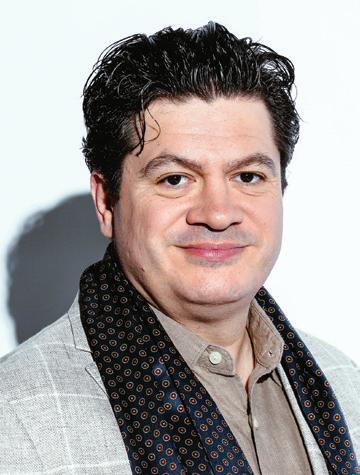
Grammy-winning conductor Cristian Măcelaru is Music Director of the Cincinnati Symphony Orchestra, Music Director of the Orchestre National de France, Artistic Director of the George Enescu International Festival and Competition, Artistic Director and Principal Conductor of the Interlochen Center for the Arts’ World Youth Symphony Orchestra, Music Director and Conductor of the Cabrillo Festival of Contemporary Music and Distinguished Visiting Artist at The Shepherd School of Music at Rice University. He also serves as Artistic Partner of the WDR Sinfonieorchester in Cologne, where he was Chief Conductor from the 2019–20 through 2024–25 seasons.
Măcelaru’s 2025–26 guest engagements include debuts with the Münchner Philharmoniker and Orchestra dell’Accademia Nazionale di Santa Cecilia, as well as returns with Tonhalle-Orchester Zürich, Czech Philharmonic, Leipzig Gewandhaus Orchestra, Philharmonia Orchestra and San Francisco Symphony.
Măcelaru’s previous seasons include European engagements with the London Philharmonic Orchestra, NDR Elbphilharmonie, Concertgebouworkest, Symphonieorchester des Bayerischen Rundfunks, Budapest Festival Orchestra and Wiener Symphoniker. In North America, he has led the New York Philharmonic, Philadelphia Orchestra, Los Angeles Philharmonic, Chicago Symphony Orchestra, Boston Symphony Orchestra and The Cleveland Orchestra. He is equally at home as a conductor of opera, with career highlights including productions of Don Giovanni with the Houston Grand Opera and Madama Butterfly with Opera Națională București.
In 2020, Măcelaru received a Grammy Award for conducting the Decca Classics recording of Wynton Marsalis’ Violin Concerto with Nicola Benedetti and The Philadelphia Orchestra. His highly anticipated recording of George Enescu’s complete symphonic works with the Orchestre National de France was released in April 2024 on Deutsche Grammophon. September 2025 marks the release of Măcelaru’s and the Orchestre National de France’s Ravel Paris 2025 album on the naïve label, featuring the symphonic works of Maurice Ravel in celebration of the 150th anniversary of the composer’s birth.
JOHN MORRIS RUSSELL
Cincinnati Pops Conductor

Louise Dieterle Nippert & Louis Nippert Chair John Morris Russell’s (JMR) embrace of America’s unique voice and musical stories has transformed how orchestral performances connect and engage with audiences. As conductor of the Cincinnati Pops since 2011, the wide range and diversity of his work as a musical leader, collaborator and educator continues to reinvigorate the musical scene throughout Cincinnati and across the continent. As Music Director of the Hilton Head Symphony Orchestra in South Carolina, JMR conducts the classical series as well as the prestigious Hilton Head International Piano Competition.
A Grammy-nominated artist, JMR has worked with leading performers from across a variety of musical genres, including Aretha Franklin, Emanuel Ax, Amy Grant and Vince Gill, Garrick Ohlsson, Rhiannon Giddens, Hilary Hahn, Brian Stokes Mitchell, Cynthia Erivo, Sutton Foster, George Takei, Steve Martin, Brian Wilson, Leslie Odom, Jr., Lea Salonga and Mandy Gonzalez.
For over two decades, JMR has led the Cincinnati Symphony Orchestra’s wildly successful Classical Roots initiative honoring and celebrating Black musical excellence. Guest artists have included Marvin Winans, Alton White, George Shirley, Common and Hi-Tek.
JMR has contributed seven albums to the Cincinnati Pops discography, including 2023’s holiday album JOY!. In 2015, he created the “American Originals Project,” which has won both critical and popular acclaim and features two landmark recordings: American Originals (the music of Stephen Foster) and the Grammynominated American Originals 1918 (a tribute to the dawn of the jazz age). The 2020 “American Originals” concert King Records and the Cincinnati Sound with Late Show pianist Paul Shaffer honored legendary recording artists associated with the Queen City. In the 2024–25 season JMR took on the next installment of the project, offering a concert and recording celebrating the legacy of the Harlem Renaissance, and presented a national PBS broadcast of Rick Steves’ Europe: A Symphonic Journey. JMR’s American Soundscapes video series with the Pops and Cincinnati’s CET public television station has surpassed one million views on YouTube since its launch in 2016.
For more information about Cristian Măcelaru and John Morris Russell, please visit cincinnatisymphony.org/about/artistic-leadership.
SAT NOV 30, 7:30 PM
SUN DEC 1, 2 PM Music Hall
DISNEY IN CONCERT: HOCUS POCUS | 2025–26 SEASON
SAT NOV 1, 7:30 PM | SUN NOV 2, 2 PM Music Hall
JASON SEBER conductor
There will be one intermission.
Starring Bette Midler
Sarah Jessica Parker
Kathy Najimy
Directed by Kenny Ortega
Produced by David Kirschner
Steven Haft
Screenplay by Mick Garris
Neil Cuthbert
Story by David Kirschner
Mick Garris
Executive Producer
Ralph Winter
The Cincinnati Pops Orchestra is grateful to Pops Season Presenter PNC.
The Cincinnati Symphony Orchestra is grateful for the support of the Louise Dieterle Nippert
Musical Arts Fund of the Greenacres Foundation, the Nina Browne Parker Trust, and the thousands of people who give generously to the ArtsWave Community Campaign, the region’s primary source for arts funding. This project was supported in part by the Ohio Arts Council, which receives support from the State of Ohio and the National Endowment for the Arts
The CSO in-orchestra Steinway piano is made possible in part by the Jacob G. Schmidlapp Trust.
Score by John Debney
Additional Music by James Horner
Brock Walsh
“I Put a Spell on You”
Music and Lyrics by Jay Hawkins
Arranged by Marc Shaiman
Musical Arrangements by Marc Shaiman
Choreography
Peggy Holmes
Kenny Ortega
Prints by TECHNICOLOR®

Walt Disney Pictures
Original Motion Picture Soundtrack available at Disneymusicemporium.com.
PRESENTATION LICENSED BY
This film is rated “PG”
Tonight’s performance lasts approximately 1 hour and 39 minutes with a 20-minute intermission. The performance is a presentation of the complete film Hocus Pocus with a live performance of the film’s entire score. Out of respect for the musicians and your fellow audience members, please remain seated until the conclusion of the end credits.
Presentation licensed by Disney Concerts ©All rights reserved.

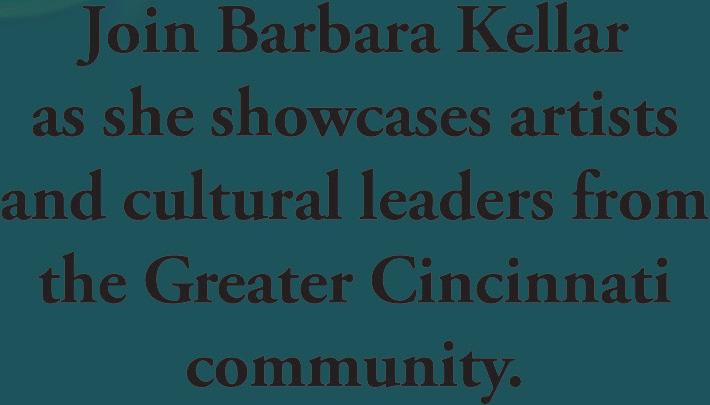

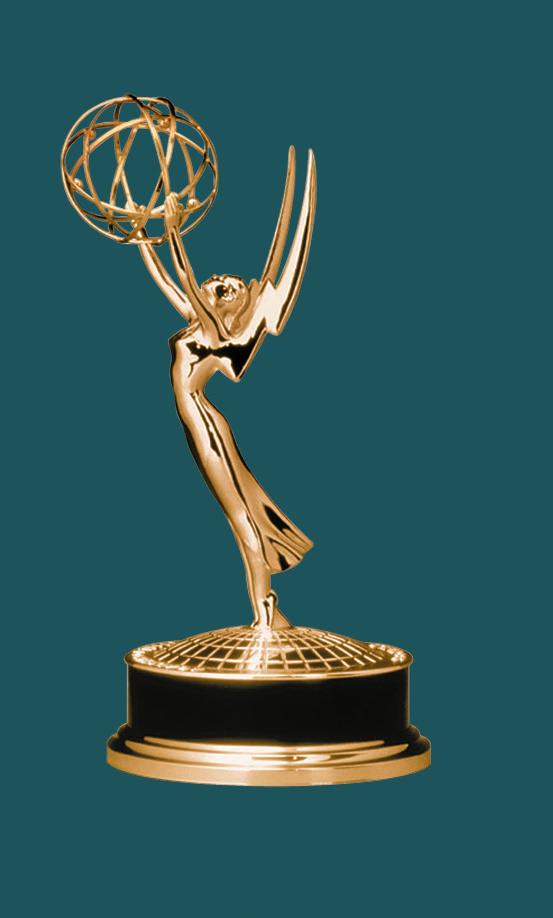

Johannes Brahms
YO-YO MA PLAYS ELGAR | 2025–26 SEASON
TUE NOV 4, 7:30 PM
Music Hall
Cristian Măcelaru conductor Yo-Yo Ma cello
Tragische Ouvertüre (“Tragic Overture”), Op. 81 (1833–1897)
Edward Elgar
Concerto in E Minor for Cello and Orchestra, Op. 85 (1857–1934)
Adagio — Moderato
Lento — Allegro molto
Adagio — Lento
Allegro
George Enescu
Romanian Rhapsody in A Major, Op. 11, No. 1* (1881–1955)
*New edition, corrected on the original manuscripts, edited by Stefan Diaconu, provided by Musica Coloris Edition.
This performance is approximately 60 minutes long. There is no intermission.
The CSO is grateful to CSO Season Sponsor Western & Southern Financial Group and Encore Sponsor Messer Construction.
The Cincinnati Symphony Orchestra is grateful for the support of the Louise Dieterle Nippert Musical Arts Fund of the Greenacres Foundation, the Nina Browne Parker Trust, and the thousands of people who give generously to the ArtsWave Community Campaign, the region’s primary source for arts funding. This project was supported in part by the Ohio Arts Council, which receives support from the State of Ohio and the National Endowment for the Arts.
The CSO in-orchestra Steinway piano is made possible in part by the Jacob G. Schmidlapp Trust
with Cristian Măcelaru, Music Director
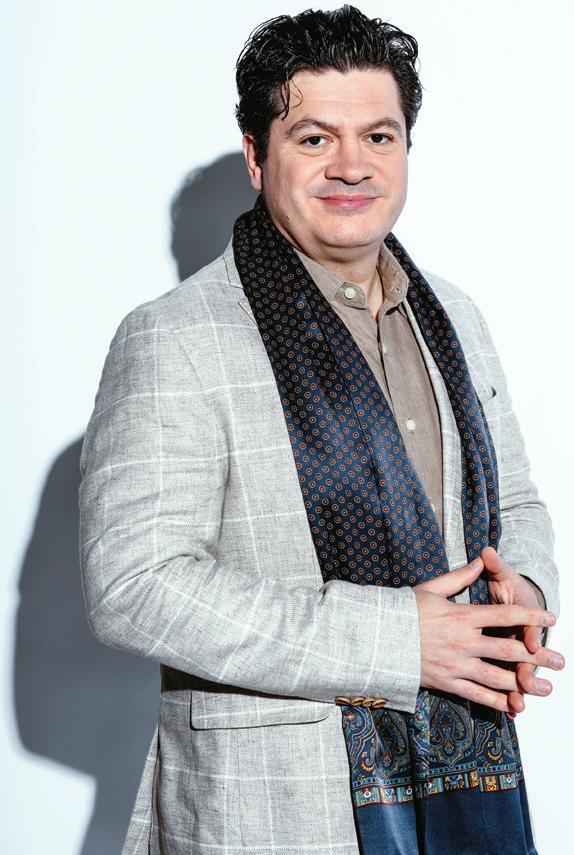
Cristian Măcelaru first performed with Yo-Yo Ma a few years ago, at Tanglewood. After their first rehearsal with the orchestra, Măcelaru heard a knock at the door connecting his and Ma’s dressing rooms. Sure enough, Ma himself snuck in and beelined for Măcelaru. “I want to understand who you are, and where you’re coming from,” the cellist told him.
A musical answer comes in the form of George Enescu’s Romanian Rhapsody No. 1 — a tribute to Măcelaru’s homeland and to the composer who made its sounds known around the world. (For more on Măcelaru and Enescu, see “In Search of George Enescu,” on pp. 9–13.)
Why this rhapsody specifically? According to Măcelaru, it references a lot of Romanian tradition — dances, rhythms — in a short amount of time. “It’s basically a 11-minute folk piece,” he says, albeit one “that is highly sophisticated and incredibly virtuosic for everyone in the orchestra.” Programming it on a concert that also features Ma “is my gift back to him,” Măcelaru says.
Măcelaru paired the Rhapsody with Elgar’s Cello Concerto, the same piece he and Ma performed together at Tanglewood. The concerto is solidly in Ma’s wheelhouse, of course, but Măcelaru also thinks of it as “the most tragic” of Elgar’s works. “You know, this was a composition written after the war,” he says. “This concerto brings back so many thoughts about human suffering, and the fragility of the human spirit.”
He sees Brahms’ Tragic Overture in the same vein. All that solemnity might seem odd for a gala concert. Măcelaru sees it differently. “What I would say is that neither the Elgar nor the Brahms speaks of the tragedy aspect,” he says. “[They] speak of the sensitivity that is a result of something truly traumatic in one’s life …. There’s an intimacy that it would be beautiful for the audience to be part of.”
—Hannah Edgar
To view the Digital Program for exclusive content, such as full-length program notes and artist biographies, please text PROGRAM to 513.845.3024*, use your mobile device to scan the QR code or visit cincinnatisymphony.org/digitalprogram.
*By texting to this number, you may receive messages that pertain to the organization and its performances; msg & data rates may apply. Reply HELP to help, STOP to cancel.
Cristian Măcelaru, conductor
A complete biography for Music Director Cristian Măcelaru can be found on p. 23.
Yo-Yo Ma, cello
Yo-Yo Ma’s multi-faceted career is testament to his belief in culture’s power to generate trust and understanding. Whether performing new or familiar works for cello, bringing communities together to explore culture’s role in society or engaging unexpected musical forms, Ma strives to foster connections that stimulate the imagination and reinforce our humanity.
Most recently, Ma began Our Common Nature, a cultural journey to celebrate the ways that nature can reunite us in pursuit of a shared future. Our Common Nature follows the Bach Project, a 36-community, six-continent tour of J.S. Bach’s cello suites paired with local cultural programming. Both endeavors reflect Ma’s lifelong commitment to stretching the boundaries of genre and tradition to understand how music helps us to imagine and build a stronger society.
Yo-Yo Ma was born in 1955 to Chinese parents living in Paris, where he began studying the cello with his father at age four. When he was seven, he moved with his family to New York City, where he continued his cello studies before pursuing a liberal arts education.
Ma has recorded more than 120 albums, is the winner of 19 Grammy Awards and has performed for nine American presidents, most recently on the occasion of President Biden’s inauguration. He has received numerous awards, including the National Medal of the Arts, the Presidential Medal of Freedom and the Birgit Nilsson Prize. He has been a UN Messenger of Peace since 2006 and was recognized as one of TIME magazine’s 100 Most Influential People of 2020. yo-yoma.com
Johannes Brahms: Tragische Ouvertüre (“Tragic Overture”), Op. 81
Composed: 1880
Premiere: December 26, 1880, in Vienna, Hans Richter conducting the Philharmonic Orchestra
Instrumentation: 2 flutes, piccolo, 2 oboes, 2 clarinets, 2 bassoons, 4 horns, 2 trumpets, 3 trombones, tuba, timpani, strings
CSO notable performances: First: January 1913, Ernst Kunwald conducting. Most Recent: March 2011, Louis Langrée conducting.
Duration: approx. 13 minutes
Brahms composed his one-movement Tragic Overture in 1880, around the same time he was working on his Academic Festival Overture, which he wrote in gratitude for an honorary doctorate from the University of Breslau. He often wrote pairs of works in which one work complemented or contrasted with the other. In this case, the Tragic Overture is somber and intense while the Academic Festival Overture is witty and jubilant. Brahms himself remarked to a friend, “One weeps while the other laughs.”
The official premiere of the Tragic Overture took place in December 1880 in Vienna, with Hans Richter, a loyal supporter and friend of Brahms’, conducting the Philharmonic Orchestra. Less than a year later, in October 1881, the work received its American premiere with the Boston Symphony Orchestra under George Henschel, another friend of Brahms’ and the orchestra’s founding conductor. American conductors quickly took up the work, with Theodore Thomas leading performances in New York the next month and then, for the 1882 May Festival, in Cincinnati. Brahms’ contemporaries and 20th-century commentators offered a variety of interpretations of the Tragic Overture’s meaning. Hermann Deiters, a music critic and friend of Brahms’, heard it as depicting “a strong hero battling with an iron and relentless fate; passing hopes of victory cannot alter an impending destiny.” Donald Frances Tovey, another associate of the composer’s, proffered a similar reading, describing the overture as expressing “human defiance against a dark destiny.”
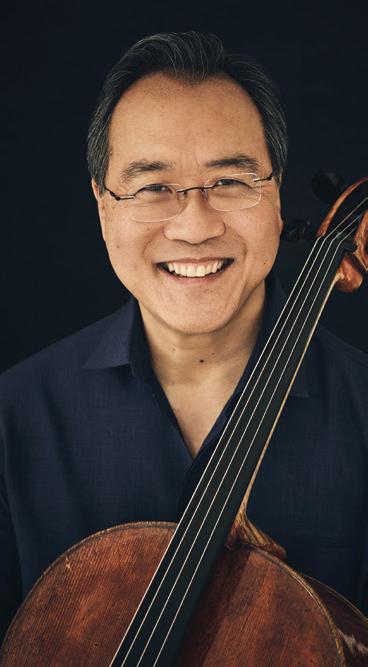
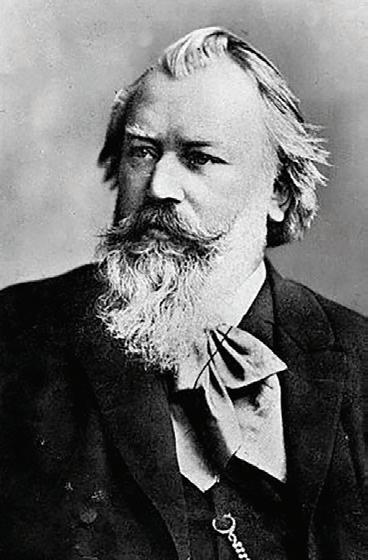
Born: May 7, 1833, Hamburg, Germany
Died: April 3, 1897, Vienna, Austria

Born: June 2, 1857, Broadheath, U.K. Died: February 23, 1934, Worcester, U.K.
Much of the work’s psychological battle is conveyed through contrasts: loud, forceful passages, played by the full orchestra alternate with quieter, lyrical, almost peaceful interludes often performed by the strings and solo winds. Whereas other turbulent works, such as Brahms’ First Symphony, end triumphantly, the Tragic Overture concludes with a loud, defiant return to the unresolved tensions of its opening.
—©Heather Platt, Sursa Distinguished Professor of Fine Arts, Ball State University
Edward Elgar: Concerto in E Minor for Cello and Orchestra, Op. 85
Composed: 1918
Premiere: October 27, 1919, London, Edward Elgar conducting the Queen’s Hall Orchestra, Felix Salmond, cello
Instrumentation: solo cello, 2 flutes (incl. piccolo), 2 oboes, 2 clarinets, 2 bassoons, 4 horns, 2 trumpets, 3 trombones, tuba, timpani, strings
CSO notable performances: First: November 1970, Erich Kunzel conducting; Jacqueline du Pré, cello. Most Recent: March 2022, David Danzmayr conducting; Alban Gerhardt, cello.
Duration: approx. 30 minutes
In May 1917, Sir Edward Elgar and his wife, Alice, rented an unpretentious thatched-roof cottage called “Brinkwells” in an isolated part of West Sussex, very close to the English Channel. The relocation was partly out of economic necessity — World War I had a devastating effect on musical life and, therefore, on Elgar’s income — and partly due to the composer’s depression and poor health. Staying at Brinkwells from May to October reinvigorated Elgar’s creative powers. Returning in 1918 and 1919, Elgar sketched, composed and virtually completed three major chamber music scores and, in 1919, his Cello Concerto in E Minor, Op. 85. The war was still eerily present, however: as he was writing the Cello Concerto in 1918, Elgar could hear echoes of the final titanic battles wafting across the channel from northern France.




The concerto’s premiere was a shambles. The soloist, Felix Salmond, lost his nerve during the performance. Furthermore, Albert Coates, the conductor with whom Elgar shared the program, had monopolized the rehearsal time, leaving the concerto woefully under-rehearsed. Many music critics dismissed the work as old-fashioned. However, the charismatic cellist Beatrice Harrison championed the concerto; she recorded it twice with the composer conducting, and her insightful interpretations revealed the work’s true stature.
The audience at the premiere may have been puzzled by the concerto’s innovative formal design. Unlike most cello concertos, this score is concise, almost terse; the orchestral timbre is subdued; and the mood is autumnal. After the soloist proclaims a dramatic double-stopped recitative, the first movement begins wistfully, the music rising and falling in waves of emotion. The quicksilver scherzo that follows without a break demands complete technical control from the soloist. The slow movement, marked adagio, is a heartrending “song without words.” Although the finale begins with a swaggering theme, the music gradually loses confidence as it progresses and dissolves into a poignant lament. After a return of the soloist’s majestic recitative from the concerto’s opening, a precipitous coda hurtles to a brusque final cadence.
—©Byron Adams, Emeritus Distinguished Professor of Musicology, University of California, Riverside
George Enescu: Romanian Rhapsody in A Major, Op. 11, No. 1
Composed: 1901
Premiere: March 8, 1903 in Bucharest, conducted by the composer
Instrumentation: 3 flutes (incl. piccolo), 2 oboes, English horn, 2 clarinets, 2 bassoons, 4 horns, 2 trumpets, 2 cornets, 3 trombones, tuba, timpani, crash cymbals, snare drum, suspended cymbals, triangle, 2 harps, strings
CSO notable performances: First: December 1912, Ernst Kunwald conducting. Most Recent: February 1957, Thor Johnson conducting, as well as on several Parks, Riverbend and Pops concerts since then. Notable: April 1948, George Enescu conducting; in 1988, the Cincinnati Pops recorded the work for its 1988 release, Symphonic Spectacular, Erich Kunzel conducting.
Duration: approx. 11 minutes
George Enescu, Romania’s greatest composer, was one of the most prodigiously gifted musicians of the 20th century. He began playing violin at age four, wrote his first compositions a year later and was admitted to the Vienna Conservatory when he was seven. He was already an accomplished violinist and composer by the time he moved to Paris, at age 14, to continue his studies with Massenet and Fauré. The first concert of his works was given in Paris in 1897; the next year he introduced the Poème roumain, which he counted as his Op. 1.
During the years before World War I, Enescu’s career as violin soloist and chamber musician flourished, he was much in demand as a conductor, and his compositions, especially the two Romanian Rhapsodies of 1901, carried his name into the world’s concert halls.
Enescu’s music shows a broad range of influences — alongside native folksong stand echoes of Wagner, Brahms, Strauss, Fauré, Debussy, Bach, Bartók and Stravinsky. His Romanian Rhapsodies are modeled in form and style on Franz Liszt’s Hungarian Rhapsodies. Based on indigenous tunes, the Romanian Rhapsody No. 1 is a work of high spirits and good cheer. The themes are presented episodically with little development. The first melody, a traditional drinking song with the straightforward title “I have a coin and I want a drink,” is a perky ditty given by the clarinet and woodwinds. It is taken up by the strings and leads to the second theme, a slow dance in 6/8 meter with a sweeping figure in its first measure. This motive is succeeded by a languid phrase initiated by the violins. The slow dance, led this time by the solo viola, and the languid phrase return before a ponderous theme with an East Asian tinge is introduced. The last half of the work is a brilliant display of flashing orchestral sonority and leaping rhythmic vivacity.
—©Dr. Richard E. Rodda
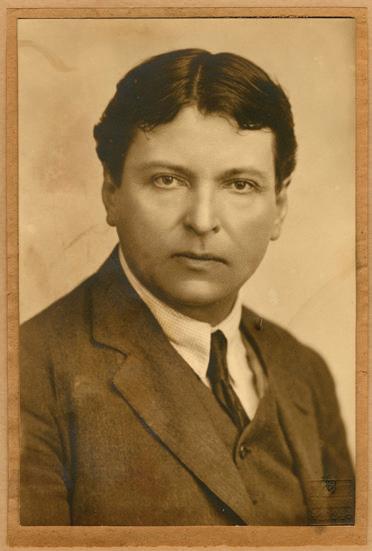
Born: August 19, 1881 in Liveni-Virnav, Romania
Died: May 4, 1955 in Paris
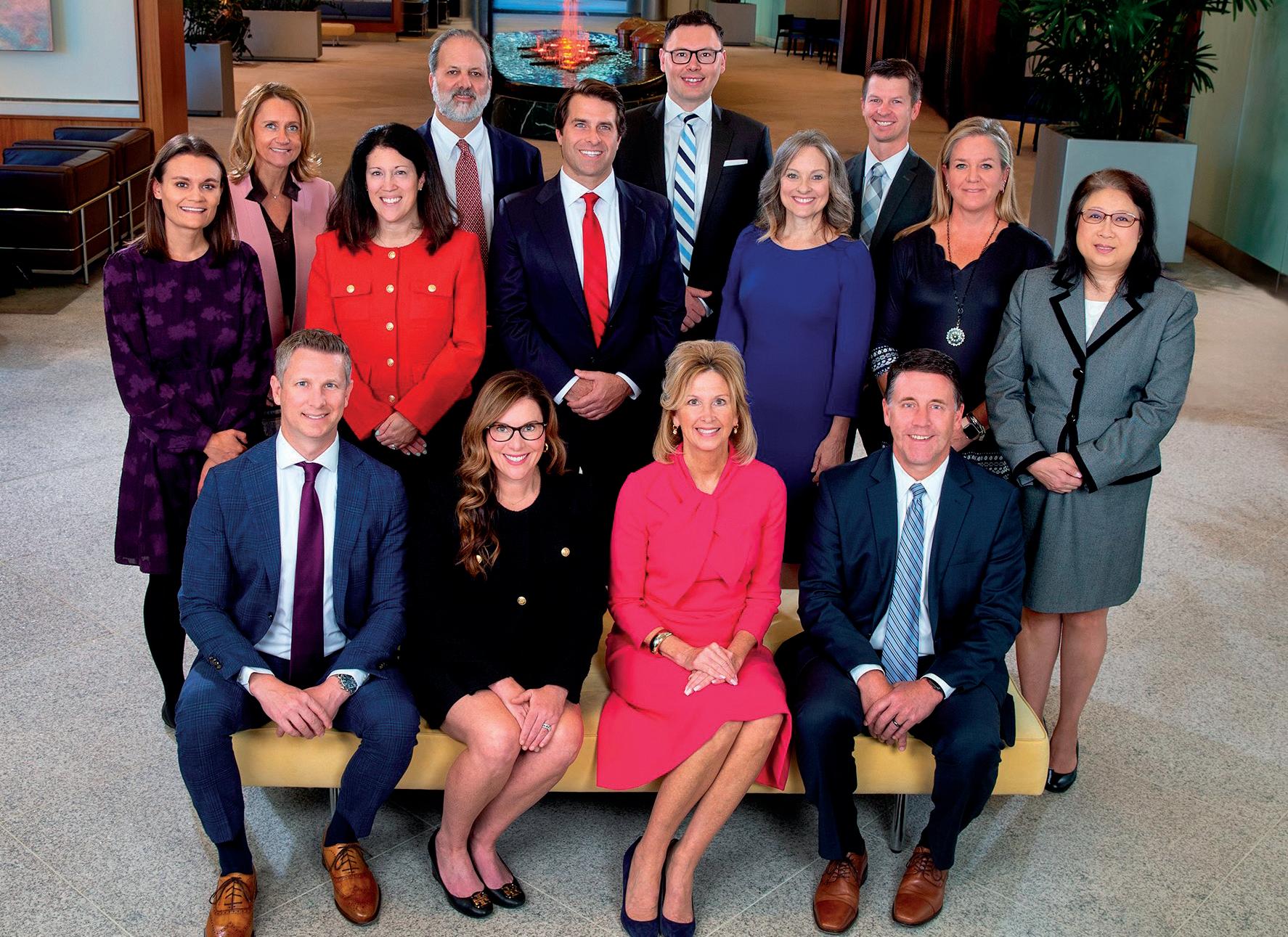
THE BELLS & SYMPHONIE FANTASTIQUE | 2025–26 SEASON
SAT NOV 8, 7:30 PM | SUN NOV 9, 2 PM
Music Hall
Matthias Pintscher conductor
Andriana Chuchman soprano
Garrett Sorenson tenor
Joshua Hopkins baritone
May Festival Chorus Matthew Swanson, director
Sergei Rachmanino
The Bells, Op. 35 (1873–1943)
The Silver Sleigh Bells: Allegro, ma non tanto
The Golden Wedding Bells: Lento
The Loud Alarum Bells: Presto
The Mournful Iron Bells: Lento lugubre
Hector Berlioz
Symphonie fantastique, Op. 14a (1803–1869)
Reveries, Passions
A Ball Scene in the Country
March to the Sca old Dream of a Witches’ Sabbath
These performances are approximately 120 minutes long, including intermission.
The CSO is grateful to CSO Season Sponsor Western & Southern Financial Group.
The Cincinnati Symphony Orchestra is grateful for the support of the Louise Dieterle Nippert Musical Arts Fund of the Greenacres Foundation, the Nina Browne Parker Trust, and the thousands of people who give generously to the ArtsWave Community Campaign, the region’s primary source for arts funding. This project was supported in part by the Ohio Arts Council, which receives support from the State of Ohio and the National Endowment for the Arts
Pre-Concert Talks are made possible by an endowed gift from Melody Sawyer Richardson
WGUC is the Media Partner for these concerts. This concert will air on 90.9 WGUC on January 18, 2026, followed by 30 days of streaming at cincinnatisymphony.org/replay.
The CSO in-orchestra Steinway piano is made possible in part by the Jacob G. Schmidlapp Trust.
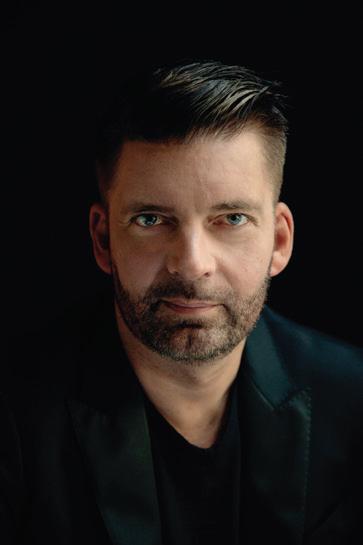
Matthias Pintscher, conductor & CSO Creative Partner
Matthias Pintscher is the newly appointed music director of the Kansas City Symphony as of the 2024–25 season. He launched his tenure with a highly successful tour with the orchestra to Europe, just before opening the season in Kansas City, with concerts at the Concertgebouw in Amsterdam, the Berlin Philharmonie and Hamburg’s Elbphilharmonie.
Highlights of the 2025–26 season include the world premiere of Pintscher’s new opera Das kalte Herz by the Berlin State Opera; Pintscher will conduct the January premiere and the March reprise performance, in a French version titled Nuit sans aube, at the Opéra-Comique in Paris. He also returns to the Los Angeles Philharmonic and The Philadelphia Orchestra and is in his sixth year as Creative Partner for the Cincinnati Symphony Orchestra.
Pintscher was formerly music director of the Ensemble intercontemporain and has held several titled positions, including nine seasons as BBC Scottish Symphony Orchestra’s artist-in-association, principal conductor of the Lucerne Festival Academy Orchestra, music director for the 2020 Ojai Festival and season creative chair with the Tonhalle-Orchester Zürich.
Pintscher is also well known as a composer. His music is championed by some of today’s finest performing artists, orchestras and conductors, and has been performed by the Boston Symphony, Chicago Symphony, Cleveland Orchestra, New York Philharmonic, Berlin Philharmonic, London Symphony Orchestra, Royal Concertgebouw Orchestra and the Orchestre de Paris, among many others. He has been on the composition faculty at The Juilliard School since 2014.
Matthias Pintscher is published exclusively by Boosey & Hawkes, and recordings of his works can be found on Kairos, EMI, Teldec, Wergo and Winter & Winter. matthiaspintscher.com

This season, soprano Andriana Chuchman makes her debut at Pacific Opera Victoria in Orfeo ed Euridice and appears in concert with the Chamber Music Society of Lincoln Center, Cincinnati Symphony Orchestra and the Kansas City Symphony She has appeared with many prestigious opera companies, including the Metropolitan Opera, San Francisco Opera, Lyric Opera of Chicago, Houston Grand Opera, Dallas Opera, Los Angeles Opera, Washington National Opera, Glyndebourne Festival Tour, Salzburg Whitsun Festival and the Hamburg State Opera. In her native Canada, she has appeared with the Canadian Opera Company, Manitoba Opera and Edmonton Opera. Born in Winnipeg, Chuchman received her bachelor’s degree in Voice Performance from the School of Music at the University of Manitoba. She is also an alumna of the Ryan Opera Center at the Lyric Opera of Chicago and the San Francisco Opera’s Merola Program. andrianachuchman.com
To view the Digital Program for exclusive content, such as full-length program notes and artist biographies, please text PROGRAM to 513.845.3024*, use your mobile device to scan the QR code or visit cincinnatisymphony.org/digitalprogram.
*By texting to this number, you may receive messages that pertain to the organization and its performances; msg & data rates may apply. Reply HELP to help, STOP to cancel.
Garrett Sorenson, tenor Grammy Award-winning and Tony Award-nominated American tenor Garrett Sorenson has been praised as an artist of unique interest, acclaimed for the beauty and power of his rich lyric voice.
In the 2025–26 season, Sorenson joins the Grand Rapids Symphony for Beethoven’s Symphony No. 9, conducted by Marcelo Lehninger, and performs Rachmaninoff’s The Bells with both the Kansas City Symphony and Cincinnati Symphony Orchestra, conducted by Matthias Pintscher.
Recent highlights include his return to San Francisco Opera as Steve Wozniak in Mason Bates’ The (R)evolution of Steve Jobs — a role he created at Santa Fe Opera in 2017 and later recorded for the 2019 release, which won the Best Opera Recording Grammy. He has also appeared with Artis–Naples in Mahler’s Das Lied von der Erde, performed Handel’s Messiah and Rachmaninoff’s The Bells with the Nashville Symphony under Giancarlo Guerrero, reprised Wozniak at Seattle Opera, returned to Kentucky Opera as Bacchus in Ariadne auf Naxos and sang Faust in the world premiere of The Beyond with Louisville Ballet.
At the Metropolitan Opera, Sorenson has performed Laca in Jenůfa, Matteo in Arabella, Cassio in Otello under James Levine, and numerous additional roles including Itulbo in Il pirata, Da-ud in Die Ägyptische Helena and Alfred in Die Fledermaus. On the concert stage, he has appeared with major orchestras including the Cleveland Orchestra, Houston Symphony, San Francisco Symphony and Orquesta Sinfónica de Castilla y León.
A graduate of the Lindemann Young Artist Development Program, Sorenson is the recipient of a Richard Tucker Career Grant and resides in Kentucky with his wife, mezzo-soprano Elizabeth Batton, and their two children. imgartists.com/ roster/garrett-sorenson
Joshua Hopkins, baritone
In the 2025–26 season, Joshua Hopkins, a JUNO Award-winning and Grammynominated Canadian baritone, returns to two of his most acclaimed operatic roles: Papageno in Mozart’s Die Zauberflöte at both The Metropolitan Opera and Semperoper Dresden and Rossini’s Figaro at San Francisco Opera. His busy concert season includes several works that are new to the artist; he sings Rachmaninoff’s The Bells under Matthias Pintscher with both the Cincinnati Symphony Orchestra and the Kansas City Symphony, debuts with the George Enescu Philharmonic Orchestra in performances of Walton’s Belshazzar’s Feast in Bucharest and returns to the San Francisco Symphony with longtime collaborator Bernard Labadie in Bach’s Easter Oratorio. He also returns to the Colorado Symphony in Vaughan Williams’ Dona nobis pacem and Haydn’s Mass in Time of War.
Hopkins brings his most personal project, Songs for Murdered Sisters, to two new venues this season, performing the song cycle with the Victoria Symphony in British Columbia and the University of Michigan’s Philharmonia Orchestra in Ann Arbor. Written by composer Jake Heggie and author Margaret Atwood, Songs for Murdered Sisters was conceived by Hopkins in remembrance of his sister, Nathalie Warmerdam, to bring awareness to ending intimate partner violence. The critically acclaimed film, directed by James Niebuhr, is available to watch on YouTube, and the JUNO-nominated digital album, released on the Pentatone label, is available on all streaming platforms joshuahopkins.com

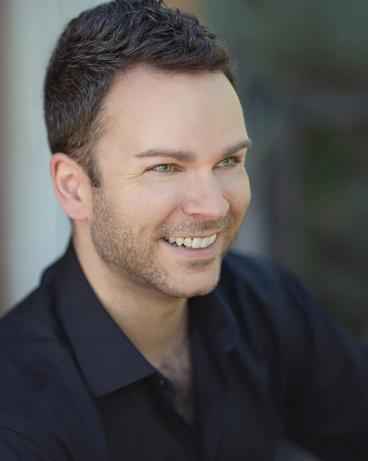










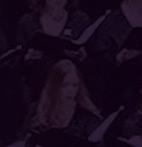










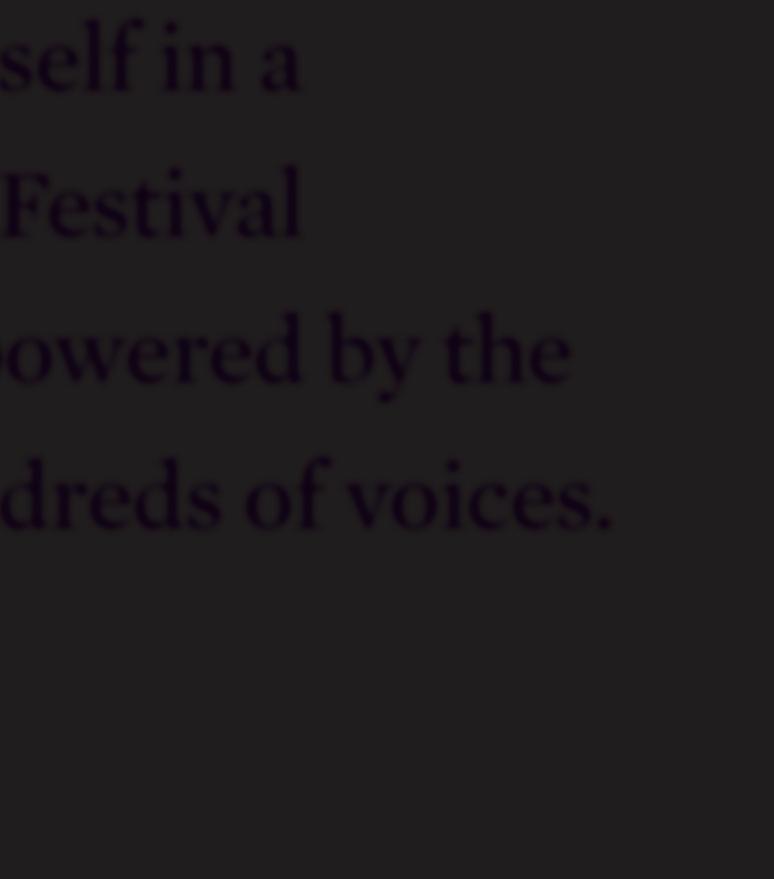

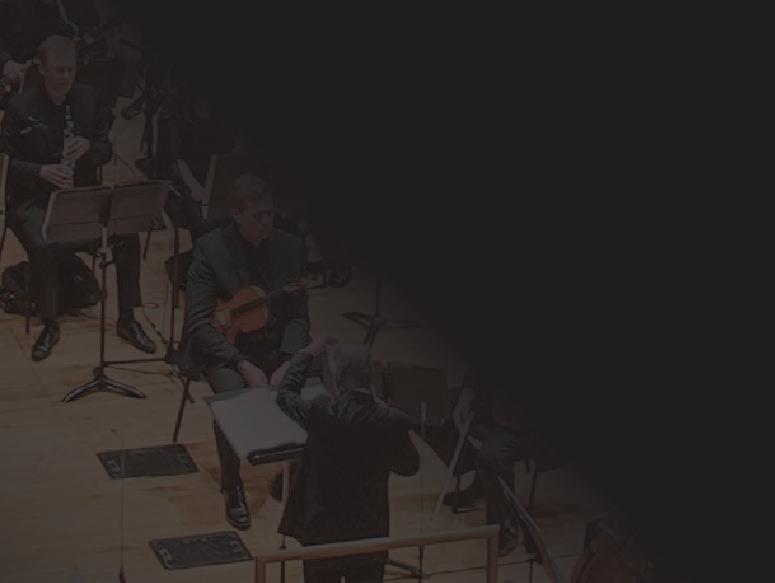



MATTHEW SWANSON, Director of Choruses
Jason Alexander Holmes, Associate Director of Choruses & Youth Chorus Director
Heather MacPhail, Accompanist
Max Trombley, Conducting Fellow
Jennelle John-Lewis, Chorus Operations Manager
Kathleen Moran, Chorus Librarian
The May Festival Chorus has earned national and international acclaim for its musicality and command of repertoire. Consisting of 145 avocational singers who collectively devote more than 45,000 hours in rehearsals and performances annually, the Chorus is the core artistic element of the Cincinnati May Festival and the official chorus of the Cincinnati Symphony Orchestra and Cincinnati Pops. The premier choral ensemble in Cincinnati, the May Festival Chorus has garnered national and international attention through numerous PBS broadcasts and award-winning recordings, many in collaboration with the CSO and Pops. Most recently, a live recording of Robert Nathaniel Dett’s The Ordering of Moses featuring Music Director Laureate James Conlon conducting the Chorus and CSO at Carnegie Hall was released to critical acclaim in 2016 on Bridge Records, and, in 2017, the Chorus re-released its popular a cappella holiday recording Christmas with the May Festival Chorus on the Fanfare Cincinnati label. The Chorus is also featured on several Pops recordings, which have sold more than 10 million copies worldwide. mayfestival.com/chorus
MATTHEW SWANSON, Director of Choruses
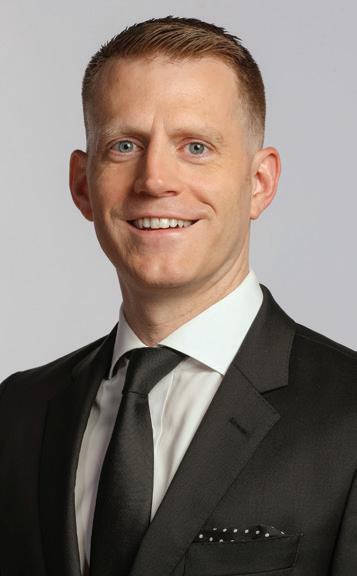
Matthew Swanson is Director of Choruses for the Cincinnati May Festival. He is the artistic head of the May Festival’s choral ensembles — the May Festival Chorus, May Festival Chamber Choir, May Festival Youth Chorus and Cincinnati Boychoir — and collaborates with the annually appointed Festival Director to craft programming for the May Festival. He conducts and prepares the May Festival Chorus — the core artistic element of the Cincinnati May Festival and the official Chorus of the Cincinnati Symphony Orchestra (CSO) and Cincinnati Pops Orchestra — for their performances at historic Music Hall and beyond. As Director of Choruses, he also leads the May Festival Conducting Fellowship, a collaboration of the May Festival and the Choral Studies Program at the University of Cincinnati CollegeConservatory of Music (CCM).
Beyond Cincinnati, Swanson has been affiliated with the Mostly Mozart Festival, the Swedish Radio Choir and the Swedish Chamber Orchestra. He taught on the faculties of CCM and Xavier University and is frequently engaged as a presenter of lectures, concerts and broadcasts.
A native of southeast Iowa, Swanson was educated at the University of Notre Dame (BA), CCM (MM, DMA) and King’s College, Cambridge (MMus). He held the May Festival Conducting Fellowship in 2015. Prior to his fellowship appointment, he began singing with the May Festival Chorus in 2012 and worked in the CSO and May Festival box office from 2014 to 2015. He was the Associate Director of Choruses and Youth Chorus Director for the May Festival 2018–2024.
Caitlin Ahmann-Miller*
Hannah Bachmann
Tracy Bailey*
Cassandra Bailey-Langjahr*
Avery Bargasse*
Mark Barnes
Deborah Barnett*
Jim Baxter
Ronny Beck
Emily Benoit
Mariah Berryman*
Nathan Bettenhausen*
Kenny Bierschenk
Jennifer Blair
Laurel Boisclair Ellsworth
David Bower*
Andrew L. Bowers
Scott Brody
Douglas J. Bruestle
Dawn Bruestle*
Darren Bryant
Sage Bushstone
Christopher Canarie*
Miriam Cantwell
Timothy Carnahan
Sophia Choi
Renee Cifuentes
Alexis Cook
Emily Cotten
Julie Cowger
Rachel Curran
Charles Daston
Steven L. Dauterman*
Grace Devoid*
Kathy Dietrich
Jennifer Dobson
Brian Donaldson
The May Festival Chorus is endowed by the Betsy & Alex C. Young Chair
Bethany Dorsel*
David Dugan
Donna Dunlap
Douglas Easterling*
Sarah Fall
Jonathan Fissel
Lindsey Fitch
Benjamin Flanders*
Joy France
Steve France*
Amanda Gast
Ella Giesler
David Gillespie
Joelle Graham
Anita Marie Greer*
Bella Gullia
Peter Guthrie
Grace Guthrie
Melissa Haas
Emma Hage
Sally Vickery Harper
Mary Wynn Haupt*
Carolyn Hill
Caleb Hixon
Grace Ho
Mark Hockenberry*
Jason Alexander Holmes*
Kim P Icsman*
Spence B. Ingerson
Karolyn L. Johnsen
Mark Johnston
Lauren Kerber
Alexandra Kesman
Erin Kie er
Jenifer Klostermeier
Andrew Kneer
Fansheng Kong
Takuya Konishi
Lisa Koressel
Judith C. LaChance
Hilary Landwehr*
Audrey Lanier
Julie Laskey
Jim Laskey
Emma Lawrence*
Megan Lawson*
Kevin Leahy*
Matthew Leonard*
Jennifer Leone*
Scott Lincoln*
Robert Lomax
Katherine Loomis
Alexx Lujan
Julia Marchese
Noelle Marousis
Melissa A. Martin
David Martin
Teri McKibben
John McKibben
Margaret Meece
Andrew Miller*
Jennifer Moak*
James Murray
H. Scott Nesbitt*
Scott C. Osgood
Mary Patton
Alison Peeno
Amy M. Perry*
Caitlin Powell
James V. Racster
Jason Ramler
Regina Rancourt*
Audrey Ray
Kristi C. Reed
Suzette Reid
Brian Reilly*
Larry Reiring*
Beth Roberts*
Christy Roediger
Lily Rollison
Hannah Schafer-Reese
Julia H. Schieve
Ann Schwentker
Karen Scott-Vosseberg
Molly Scruta
A.J. Seifert*
Adam Shoa
Emily Stevenson
Katherine Sullivan
Nikki Tayidi
Katie Tesmond
Maxwell Trombley*
Joshua Wallace
Megan Weaver*
Mark Weaver
Gary Wendt
Paul Wessendarp
Tommy Wessendarp
Stephen West
Robin Rae Wiley
Patricia Wilkens
Nathaniel Wilkens*
Taraneh R. Wilkinson
Lynnsey Williams
Evan Young
Meg Zeller
Olivia Zimmerman
*Chamber Choir for Messiah, Dec. 5–6


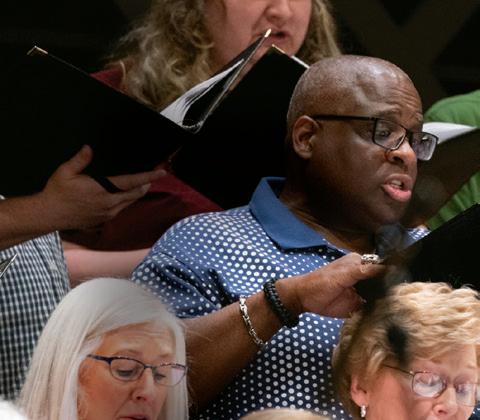
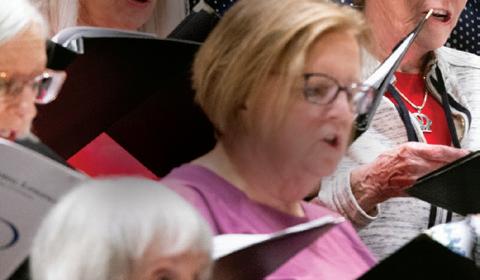
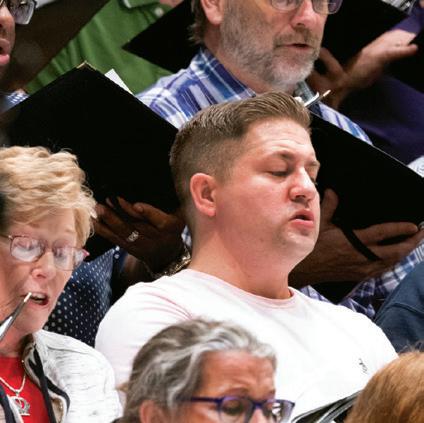
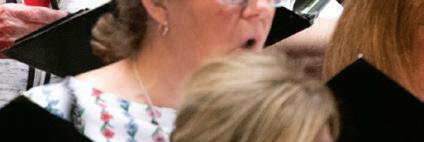









Sergei Rachmaninoff: The Bells, Op. 35
Composed: 1913
Premiere: November 13, 1913, in St. Petersburg, conducted by the composer
Instrumentation: SATB chorus and STB soloists, 3 flutes, piccolo, 3 oboes, English horn, 3 clarinets, bass clarinet, 3 bassoons, contrabassoon, 6 horns, 3 trumpets, 3 trombones, tuba, timpani, bass drum, chimes, crash cymbals, glockenspiel, snare drum, suspended cymbals, tam-tam, tambour de Basque, triangle, harp, celeste, pianino, strings
CSO notable performances: First: February 1974, Erich Kunzel conducting; soloists Patricia Wise, Seth McCoy and John Reardon; Miami University Choraliers, Miami University Men’s Glee Club, Northern Kentucky State College Concert Choir, Northern Kentucky Chamber Singers, Highlands High School Senior Chorus Ensemble. Most Recent: February 2016, Giancarlo Guerrero conducting; soloists Angela Meade, Garrett Sorenson and Hugh Russell; May Festival Chorus.
Duration: approx. 35 minutes
Within five years of the spectacular premiere of his Second Piano Concerto in 1901, Sergei Rachmaninoff had become the most popular musician in Russia and probably the busiest — invitations for him to share his prodigious talents as pianist, composer and conductor poured in from across the country and around the world. His many performances severely restricted his time for creative work, however.
Early in 1906, frustrated with his lack of time to compose, he quit his post as opera conductor at the Moscow Imperial Grand Theater and tried (unsuccessfully) to live incognito in Dresden while writing his Second Symphony. It was for a similar reason six years later that he packed up his family and his manuscript paper, left Moscow on December 5, 1912, and headed for an extended working holiday in Switzerland and Italy.
By early 1913, Rachmaninoff had been piecing together ideas for a new symphony since the previous summer, and he planned to realize the work during his stay in Italy. He continued the story in his memoirs:
In Rome, I was able to take the same flat on the Piazza di Spagna that Modest Tchaikovsky had used for a long time and which had served his brother as a temporary retreat from his numerous friends. ... Here I worked on my Second Piano Sonata and the Choral Symphony, The Bells. … The work had an unusual source. During the previous summer I had sketched a plan for a symphony, and then one day I received an anonymous letter begging me to read Balmont’s wonderful translation of Poe’s poem, saying that the verses were ideal for music and that they should particularly appeal to me. I read the enclosed poem and decided at once to use it for a Choral Symphony in four movements.
The unsigned letter, Rachmaninoff learned only after he had introduced The Bells to Moscow in February 1914, was from one Maria Danilova, a cello student of his friend Mikhail Bukinik at the Moscow Conservatory. After hearing the performance, Miss Danilova could no longer contain the secret that it was she who had been the catalyst for Rachmaninoff’s new work, and she revealed everything to Bukinik, even that she had nearly fainted from excitement during the concert.
Rachmaninoff declared The Bells to be his favorite among his compositions, probably as much for the emotional resonances of its subject as for the quality of its musical setting. He recalled:
The sound of church bells dominated all the cities of the Russia I used to know — Novgorod, Kiev, Moscow. They accompanied every Russian from childhood to the grave, and no composer could escape their influence. … All my life, I have taken pleasure in the differing moods and music of gladly chiming and mournfully tolling bells. This love for bells is inherent in every Russian.
It is little wonder that a work so evocative for Russian audiences as The Bells enjoyed excellent success at its November 1913 premiere; the listeners at the first Moscow performance the following February decorated the rafters and balconies with paper bells in anticipation of the event, and they showered the composer with flowers and laurel wreaths when it was over.
—©Dr. Richard E. Rodda
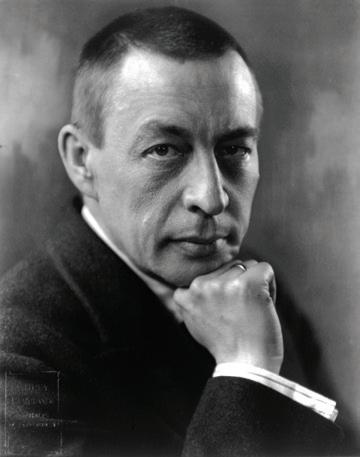
Born: April 1, 1873, Oneg (near Novgorod), Russia Died: March 28, 1943, Beverly Hills, California

Born: December 11, 1803, La Côte-SaintAndré, France
Died: March 8, 1869, Paris, France
Hector Berlioz: Symphonie fantastique, Op. 14a
Composed: 1830
Premiere: December 5, 1830, at the Paris Conservatoire
Instrumentation: 2 flutes (incl. piccolo), 2 oboes (incl. English horn), 2 clarinets (incl. E-flat clarinet), 4 bassoons, 4 horns, 2 trumpets, 2 cornets, 3 trombones, 2 tubas, 2 timpani, 2 bass drums, bells, crash cymbals, snare drum, suspended cymbals, 4 harps, strings
CSO notable performances: First: March 1897, Frank Van der Stucken conducting. Most Recent: March 2022, Louis Langrée conducting.
Duration: approx. 55 minutes
Berlioz had few compositional models when he began work on the Symphonie fantastique, so he turned inward for inspiration, drawing on his own life, loves and slim compositional portfolio. The earliest material to make its way into the work can be traced to around 1815, when the 12-year-old Berlioz, madly in love with the 18-year-old Estelle Duboeuf, penned an angsty song whose vocal line shaped the “sigh” motives of the violins heard in the opening of the first movement. The relationship — if there even was one — went nowhere, but Berlioz would continue to find creative muses throughout his life, including English actress Harriet Smithson. Berlioz first saw Smithson on the stage of the Paris Odéon in 1827, where she played Ophelia, and he excitedly returned four days later to see her as Juliet. He later noted in his Mémoirs that he was, “[by] the third act, scarcely able to breathe — it was as though an iron hand gripped me by the heart — I knew I was lost.” With Smithson completely unaware of Berlioz’s affections (they would not meet until 1832), the Symphonie fantastique thus became a vessel for the composer’s pent-up longing. Indeed, it is no coincidence that the program describes “a young musician, afflicted with that moral disease that a well-known writer [Berlioz was referencing François-René de Chateaubriand] calls the vague des passions,” who falls for an unattainable, ideal woman.
Berlioz’s deep love of literature and the theatre enabled his serendipitous encounter with Smithson, but it also provided important material for many of the “events” that make up the plot of the Symphonie fantastique. As did Part I of Goethe’s Faust, which had appeared in a celebrated French translation by Gérard de Nerval in 1827 that Berlioz admitted he read “incessantly, at meals, at the theatre, in the street, wherever I happened to be.” Berlioz’s Eight Scenes from Faust, for voice and piano, was his first compositional response to Goethe’s play; the fifth movement of the Symphonie fantastique, partially inspired by the play’s Walpurgis Night scene, would be his most celebrated. Berlioz was also likely inspired by Victor Hugo, who was actively challenging the classical orthodoxy of French theatre in works like Cromwell (1827) and Hernani (1830).
Beyond literary luminaries like Shakespeare, Goethe and Hugo, Berlioz also drew on his early schooling in medicine and a general interest in academic psychology and Romantic fantasy, including Thomas De Quincey’s Confessions of an English Opium Eater (1821–22), which explored drug-induced dreams, fantasies and other workings of the human mind.
Notably, the version of the Symphonie fantastique that premiered in 1830 no longer exists. Its full score did not appear in print until 1845, by which time Berlioz had altered the work in ways big and small. The third movement, which Berlioz reported “made no impression at all” at the first performance, was probably the first significant part to undergo revision, followed by the second. By the time the Symphonie fantastique was next heard, on December 9, 1832, again at the hall of the Conservatoire, the first and fifth movements had also been revised, in part to better align the work with its wild “sequel,” Le retour à la vie. Berlioz’s artistic vision evolved over the decade, and he continued to tweak the symphony’s shapes and sounds well into his foreign tours of the early 1840s.
— ©Jonathan Kregor, University of Cincinnati College-Conservatory of Music
THANK YOU
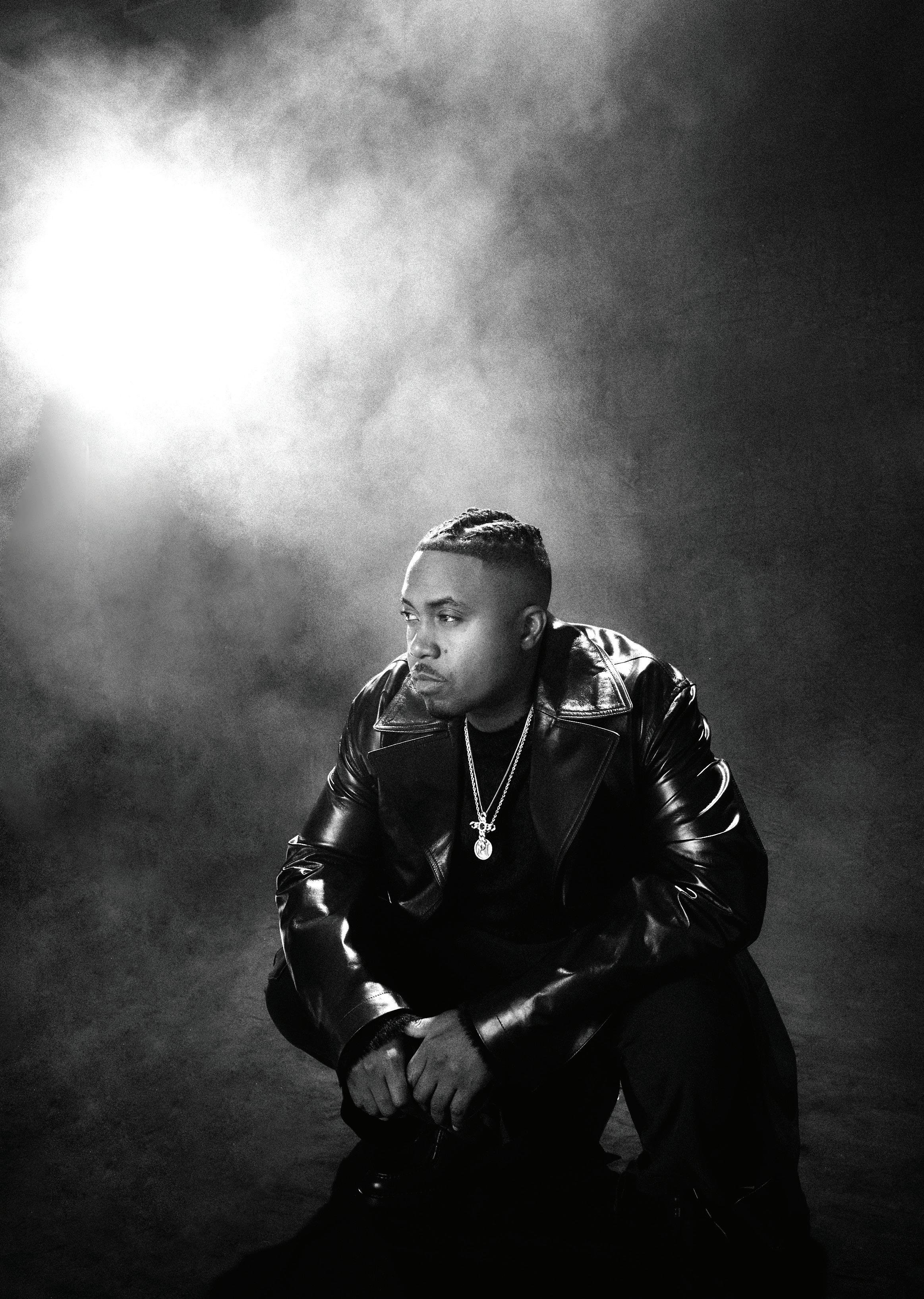
JEFFREY & JODY LAZAROW and JANIE & PETER
SCHWARTZ FAMILY FUND
Leadership Sponsor


WED NOV 12, 7:30 PM | THU NOV 13, 7:30 PM Music Hall

Thirty years after Illmatic’s critically acclaimed release, Grammy-winning hip-hop legend Nas performs the iconic album in its entirety — plus additional tracks from his illustrious career — with the Cincinnati Pops! Released in 1994, Illmatic is the groundbreaking debut from Nas and has long been considered one of the greatest hip-hop records of all time, with hits including “N.Y. State of Mind,” “The World is Yours,” “Memory Lane (Sittin’ in Da Park),” and “It Ain’t Hard to Tell.”
There will be one 20-minute intermission.
Please do not record the concert.

The Cincinnati Pops Orchestra is grateful to Pops Season Presenter PNC, Leadership Sponsor The Lazarow Schwartz Family Fund, Presenting Sponsor BlaCkOWned™ and Supporter Sponsor The Voice of Your Customer.
The Cincinnati Symphony Orchestra is grateful for the support of the Louise Dieterle Nippert Musical Arts Fund of the Greenacres Foundation, the Nina Browne Parker Trust, and the thousands of people who give generously to the ArtsWave Community Campaign, the region’s primary source for arts funding. This project was supported in part by the Ohio Arts Council, which receives support from the State of Ohio and the National Endowment for the Arts
The CSO in-orchestra Steinway piano is made possible in part by the Jacob G. Schmidlapp Trust.





PROUD SPONSOR OF THE LOLLIPOPS FAMILY CONCERT SERIES
PROUD SPONSOR OF THE LOLLIPOPS FAMILY CONCERT SERIES

LOLLIPOPS FAMILY CONCERT: Let’s Dance! | 2025–26 SEASON
SAT NOV 15, 10:30 AM | SAT NOV 15, 2 PM Music Hall
ALEX AMSEL conductor
CIARA HARPER vocalist
CITY GOSPEL MISSION’S PRINCESSES BALLET
McGING IRISH DANCERS
QKIDZ DANCERS
“Nimble Feet” from Dances in the Canebrakes
Florence Price
La cumparsita Gerardo Matos Rodriguez
FInale from the Suite from The Firebird
Igor Stravinsky
“Simple Gifts” from Lord of the Dance Traditional Electric Boogie (The Electric Slide)
Neville Livingston
Happy Pharrell Williams
Shut Up and Dance

Walk the Moon
The Cincinnati Pops is grateful to Series Sponsor UDF & Homemade Brand Ice Cream
Lollipops Family Concerts are supported in part through the George & Anne Heldman Endowment Fund and the Vicki & Rick Reynolds Endowment Fund























































































































































LOUIS CONDUCTS PETRUSHKA | 2025–26 SEASON
FRI NOV 21, 7:30 PM | SAT NOV 22, 7:30 PM Music Hall
LOUIS LANGRÉE conductor
DWIGHT PARRY oboe
CHRISTOPHER PELL clarinet
CHRISTOPHER SALES bassoon
ELIZABETH FREIMUTH horn
Jennifer Higdon blue cathedral (b. 1962)
Wolfgang Amadeus Sinfonia concertante in E-flat Major for Oboe, Clarinet, Mozart Bassoon, Horn and Orchestra, K. 297b (1756–1791)
Allegro
Adagio
Andantino con variationi
Igor Stravinsky Petrushka (1882–1971)
The Shrove-Tide Fair; The Magic Trick; Russian Dance Petrushka’s Room
The Moor’s Room; Dance of the Ballerina
The Shrove-Tide Fair (Towards Evening)
These performances are approximately 110 minutes long, including intermission.
The CSO is grateful to CSO Season Sponsor Western & Southern Financial Group and Fort Washington Investment Advisors
The Cincinnati Symphony Orchestra is grateful for the support of the Louise Dieterle Nippert Musical Arts Fund of the Greenacres Foundation, the Nina Browne Parker Trust, and the thousands of people who give generously to the ArtsWave Community Campaign, the region’s primary source for arts funding. This project was supported in part by the Ohio Arts Council, which receives support from the State of Ohio and the National Endowment for the Arts. Pre-Concert Talks are made possible by an endowed gift from Melody Sawyer Richardson. WGUC is the Media Partner for these concerts. This concert will air on 90.9 WGUC on January 25, 2026, followed by 30 days of streaming at cincinnatisymphony.org/replay.
The CSO in-orchestra Steinway piano is made possible in part by the Jacob G. Schmidlapp Trust
ARTIST BIOGRAPHIES
Louis Langrée, conductor and CSO Music Director Laureate French conductor Louis Langrée was named director of the Théâtre national de l’Opéra Comique in November 2021 by the President of France, Emmanuel Macron. Following a successful 10 years as Music Director of the Cincinnati Symphony Orchestra, Langrée was appointed Music Director Laureate through the 2027–28 season.
In the 2025–26 season, Langrée makes debuts with the Kansas City Symphony and Barcelona Symphony and returns to the National Symphony Orchestra in Washington, D.C., New York Philharmonic, Orchestra of St. Luke’s at Carnegie Hall, Los Angeles Philharmonic at the Hollywood Bowl and the Cincinnati Symphony Orchestra, for his first performances as Music Director Laureate. On the operatic stage, Langrée leads productions of Così fan tutte with the Wiener Staatsoper in Vienna and Monte Carlo.
A regular presence in New York since his 1998 debut, Langrée has conducted around 250 performances and concerts at Lincoln Center, Mostly Mozart Festival, Metropolitan Opera and New York Philharmonic. Guest conductor appearances include the Berlin Philharmonic, Vienna Philharmonic, London Philharmonic, Philadelphia Orchestra, Budapest Festival Orchestra, Czech Philharmonic, NHK Symphony, Orchestre National de France, Orchestre de Paris and Leipzig Gewandhaus, as well as Orchestre des Champs-Elysées, Freiburg Baroque and the Orchestra of the Age of Enlightenment. In addition to the Met, he frequently conducts at the leading opera houses and at festivals including Glyndebourne, Aix-en-Provence, BBC Proms, Edinburgh International, Hong Kong Arts Festival, Wiener Festwochen, Salzburg Mozartwoche and Whitsun.
An advocate for the music of our time, Langrée has conducted world premieres by Daníel Bjarnason, Julia Adolphe, Guillaume Connesson, Anna Clyne, Jonathan Bailey Holland, David Lang, Julia Wolfe, Nico Muhly, André Previn, Caroline Shaw and Christopher Rouse.
Among his recent recordings, the DVD of Thomas’ Hamlet, filmed at the Opéra Comique in Paris with the Orchestre des Champs-Elysées, won the Best Recording of the Year award at the International Opera Awards, Best Video Performance at the International Classical Music Awards, the Grand Prix de l’Académie Charles Cros, Caecilia Prize and Diapason d’Or of the Year. His two last CDs with the Cincinnati Symphony Orchestra were both nominated for “Best Orchestral Performance” Grammy Awards.
A native of Alsace, France, Langrée is an Honorary Member of the Confrérie Saint-Étienne d’Alsace, an Alsatian winemakers’ brotherhood dating back to the 14th century. He is a Chevalier de la Légion d’Honneur and an Officier des Arts et des Lettres. askonasholt.com/artist/louis-langree
Dwight Parry, oboe
Dwight Parry is Principal Oboe of the Cincinnati Symphony Orchestra (Josephine I. & David J. Joseph, Jr. Chair) and assistant professor of oboe at Bowling Green State University. He also teaches chamber music at the University of Cincinnati CollegeConservatory of Music.
Guest appearances include the New World Symphony and universities such as University of Michigan, Indiana University, CCM, Cleveland Institute of Music, San Francisco Conservatory of Music, University of Southern California and Juilliard.
Parry is a versatile and passionate soloist, an avid chamber musician and an advocate for new music. A background in jazz led Parry to pursue a career that spans from concert halls to the streets of New Orleans, where he has improvised with Dixie bands. In May 2022, Parry premiered an oboe concerto, Les belles heures, by Guillaume Connesson, which was written for him and co-commissioned by the Cincinnati Symphony Orchestra. He was then featured in the same piece with the Springfield (MO) Symphony and, in July 2025, with the Stellenbosch Festival Orchestra in South Africa (the work’s African premiere). Parry
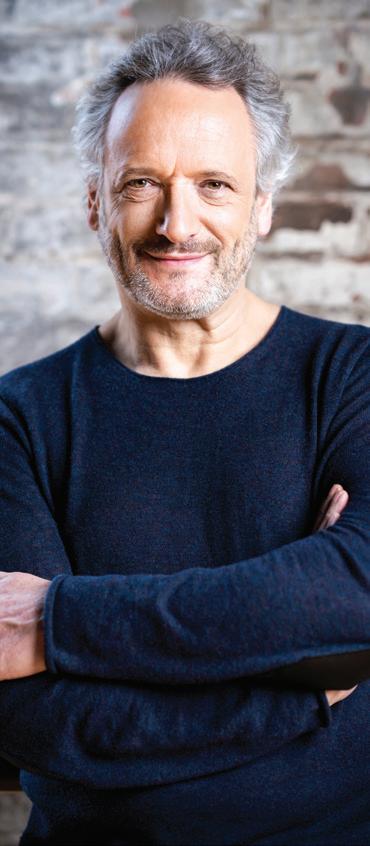
NOTE: To read more about Louis’ return to the CSO, visit the digital program at bit.ly/ Louis-Returns, or scan the QR code below.



subsequently gave the U.S. premiere of Carl Vine’s Oboe Concerto with the Ohio Valley Symphony. In May 2025, he performed the Strauss Oboe Concerto with the Jakarta Symphony Orchestra.
Parry was formerly principal oboist of the San Diego Symphony and a Fellow with the New World Symphony. He has appeared as guest principal oboist with the New York Philharmonic, Philadelphia Orchestra, Chicago Symphony, LA Philharmonic, Minnesota Orchestra, San Francisco Symphony, Saint Paul Chamber Orchestra, Guangzhou Symphony, Deutsche Symphonie of Berlin and Korean Broadcasting Symphony.
Originally from Southern California, Parry found his passion for music early on through piano, voice and saxophone. In high school, he took up the oboe and decided to make a life in music. He went on to study at the Cleveland Institute of Music and at the University of Southern California.
Dwight Parry is a Lorée artist.
Christopher Pell, clarinet
Christopher Pell is Principal Clarinet of the Cincinnati Symphony Orchestra (Emma Margaret & Irving D. Goldman Chair), second clarinetist of the Festival Orchestra of Lincoln Center and the former principal clarinetist of the Louisiana Philharmonic Orchestra. Pell has performed with the Toronto Symphony, Saint Paul Chamber Orchestra, Orpheus Chamber Orchestra, The Knights, Orquesta Sinfónica de Minería (Mexico City), Baton Rouge Symphony Orchestra, Mainly Mozart Festival Orchestra and American Ballet Theatre. He has appeared as a soloist with the Cincinnati Symphony Orchestra, Louisiana Philharmonic Orchestra, Ohio Valley Symphony, Park Avenue Chamber Symphony, U.S. Army Band at Lincoln Center’s Avery Fisher Hall and the Long Island Sound Symphony. He has also won first prize in the Vandoren Emerging Artist Competition.
As a chamber musician, Pell often performs with the Linton Chamber Music Series and has performed with concert:nova, Cape Cod Chamber Music Festival, Twickenham Fest, Lyrica Baroque, Orlando Chamber Soloists, Luzerne Chamber Music Festival, NOLA 360 and the Lake George Music Festival.
Pell teaches at the University of Cincinnati College-Conservatory of Music and Indiana University’s Jacobs School of Music. He has also taught at the Interlochen Arts Camp and the University of New Orleans. He has given recitals and masterclasses at Miami University (OH), University of South Carolina and the University of Kentucky.
Christopher Pell graduated from The Juilliard School in 2013 and has twice been a fellow at the Tanglewood Music Center. He is a performing artist for Vandoren and is also a board member for Lyrica Baroque.
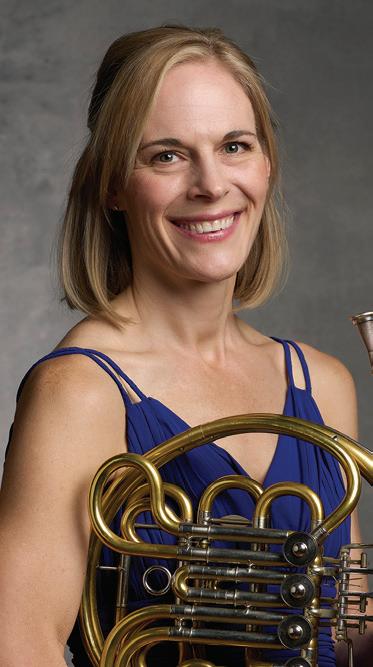
Elizabeth Freimuth, currently on a leave of absence from her position as Principal Horn with the Cincinnati Symphony Orchestra, is Professor of Horn at Rice University’s Shepherd School of Music. Before joining the CSO in 2006, Freimuth was principal horn of the San Francisco Ballet Orchestra, principal horn of the Kansas City Symphony and assistant principal/utility horn of the Colorado Symphony.
Freimuth has performed as featured soloist with the Cincinnati Symphony Orchestra, Kansas City Symphony, Butler County Symphony (PA), Johnson City Symphony Orchestra (TN), Overland Park Symphony (KS) and the Lakewood Symphony (CO). She has also performed as guest principal horn with the New York Philharmonic, Chicago Symphony, San Francisco Symphony, Philadelphia Orchestra, Pittsburgh Symphony, Minnesota Orchestra, KBS Symphony (Korea), Saint Paul Chamber Orchestra and the St. Louis Symphony. She has been a featured artist at international horn symposiums at Ball State University and the University of Memphis, as well as for the International Women’s Brass Conference at the University of Northern Kentucky.
Freimuth has also served as an adjunct instructor at the University of Cincinnati College-Conservatory of Music, and she previously was the horn teacher at the University of Missouri–Kansas City Conservatory of Music. She has also given numerous masterclasses and taken on several guest teaching engagements throughout the U.S. and in Beijing.
During the summer, Freimuth plays at the Sun Valley Music Festival, and, since 2015, she has been a principal horn and teaching faculty member at the Brevard Music Center in North Carolina. Since 2019, she has co-hosted a summer horn intensive at the Eastman School of Music.
Freimuth is a graduate and recipient of the coveted Performer’s Certificate of the Eastman School of Music (B.M. Horn Performance and B.M. Instrumental Music Education). She is also a graduate of Rice University’s Shepherd School of Music (M.M.).
Christopher Sales is Principal Bassoon of the Cincinnati Symphony Orchestra (Emalee Schavel Chair). He has also held principal bassoon positions with the Calgary Philharmonic, Charleston Symphony and Jacksonville Symphony orchestras.
As a soloist, Sales has showcased his virtuosity in concerto performances with the Cincinnati Symphony Orchestra and the Calgary Philharmonic Orchestra, among others, as well as the Aspen and Eastern music festivals. Sales has played with many other institutions over the years, including the Toronto Symphony Orchestra and the Bellingham (WA) Festival of Music, among others. He is also an adjunct faculty member at the University of Cincinnati College-Conservatory of Music.
Sales has played countless masterclasses and solo recitals across North America in venues such as the Mount Royal Conservatory in Calgary, the Glenn Gould School and The Juilliard School, among others. He has participated in a number of recording sessions and livestreams with the Cincinnati Symphony Orchestra.
Jennifer Higdon: blue cathedral
Composed: 2000
Premiere: 2000, Curtis Institute of Music
Instrumentation: 2 flutes (incl. piccolo), oboe, English horn, 2 clarinets, 2 bassoons, 4 horns, 3 trumpets, 3 trombones, tuba, timpani, bass drum, bell tree, chimes, crotales, glockenspiel, marimba, sizzle cymbal, suspended cymbals, tam-tam, tomtom, triangles, vibraphone, harp, celeste, piano, strings (various orchestra members double on crystal glasses (horns, trombones, tuba) and Chinese bells (strings)
CSO notable performances: These are the first CSO performances of blue cathedral
Duration: approx. 11 minutes
Jennifer Higdon is one of America’s most acclaimed figures in contemporary classical music, receiving the 2010 Pulitzer Prize in Music for her Violin Concerto, a 2010 Grammy for her Percussion Concerto, a 2018 Grammy for her Viola Concerto and a 2020 Grammy for her Harp Concerto. Higdon’s first opera, Cold Mountain, won the International Opera Award for Best World Premiere and the opera recording was nominated for two Grammy Awards.
In 2018, Higdon received the prestigious Nemmers Prize, awarded to contemporary classical composers of exceptional achievement who have significantly influenced the field of composition. Most recently, she was inducted into the American Philosophical Society and the American Academy of Arts and Letters. Higdon enjoys several hundred performances a year of her works, and blue cathedral is today’s most performed contemporary orchestral work, with more than 850 performances worldwide. Her works have been recorded on more than 70 CDs. Her music is published exclusively by Lawdon Press.
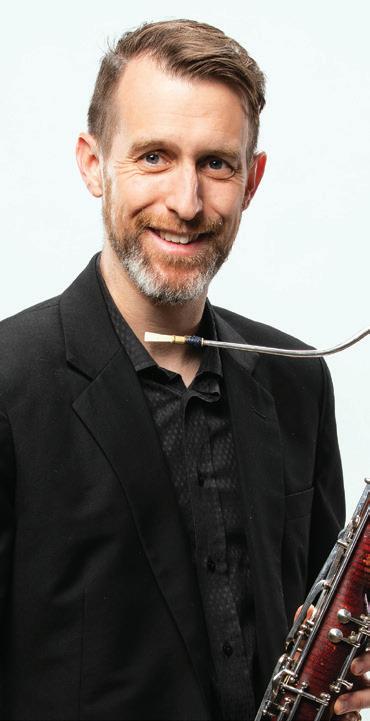

Born: 1962, Brooklyn, New York
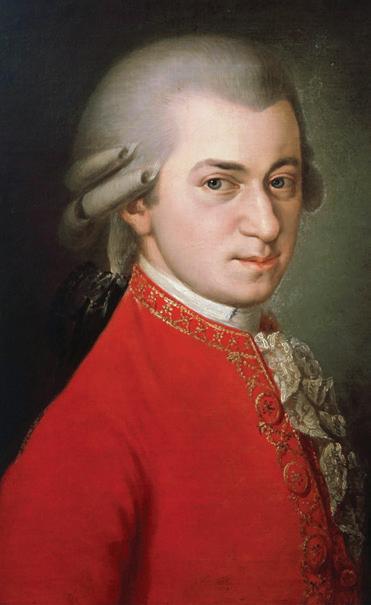
Born: January 27, 1756, in Salzburg, Austria
Died: December 5, 1791, in Vienna, Austria
Higdon describes blue cathedral as follows:
Blue … like the sky. Where all possibilities soar. Cathedrals … a place of thought, growth, spiritual expression … serving as a symbolic doorway into and out of this world. Blue represents all potential and the progression of journeys. Cathedrals represent a place of beginnings, endings, solitude, fellowship, contemplation, knowledge and growth. As I was writing this piece, I found myself imagining a journey through a glass cathedral in the sky. Because the walls would be transparent, I saw the image of clouds and blueness permeating from the outside of this church. In my mind’s eye the listener would enter from the back of the sanctuary, floating along the corridor among giant crystal pillars, moving in a contemplative stance. The stained-glass windows’ figures would start moving with song, singing a heavenly music. The listener would float down the aisle, slowly moving upward at first and then progressing at a quicker pace, rising toward an immense ceiling which would open to the sky … as this journey progressed, the speed of the traveler would increase, rushing forward and upward. I wanted to create the sensation of contemplation and quiet peace at the beginning, moving toward the feeling of celebration and ecstatic expansion of the soul, all the while singing along with that heavenly music.
These were my thoughts when the Curtis Institute of Music commissioned me to write a work to commemorate its 75th anniversary. Curtis is a house of knowledge — a place to reach toward that beautiful expression of the soul which comes through music. I began writing this piece at a unique juncture in my life and found myself pondering the question of what makes a life. The recent loss of my younger brother, Andrew Blue, made me reflect on the amazing journeys that we all make in our lives, crossing paths with so many individuals singularly and collectively, learning and growing each step of the way. This piece represents the expression of the individual and the group … our inner travels and the places our souls carry us, the lessons we learn, and the growth we experience. In tribute to my brother, I feature solos for the clarinet (the instrument he played) and the flute (the instrument I play). Because I am the older sibling, it is the flute that appears first in this dialog. At the end of the work, the two instruments continue their dialogue, but it is the flute that drops out and the clarinet that continues the upward-progressing journey.
This is a story that commemorates living and passing through places of knowledge and of sharing and of that song called life.
This work was commissioned and premiered by the Curtis Institute of Music.
Wolfgang Amadeus Mozart: Sinfonia concertante in E-flat Major for Oboe, Clarinet, Bassoon, Horn and Orchestra, K. 297b
Composed: 1778
Premiere: unknown
Instrumentation: solo oboe, clarinet bassoon and horn; 2 oboes, 2 horns, strings
CSO notable performances: First: November 1962, Max Rudolf conducting; soloists (CSO principals) Dennis Larson, Richard Waller, Otto Eifert and Michael Hatfield. Most Recent: January 1988, Jesús López Cobos conducting; soloists (CSO principals) Richard Johnson, Richard Waller, William Winstead and Robin Graham.
Duration: approx. 32 minutes
Mozart arrived in Paris, chaperoned by his mother, on March 23, 1778, hoping that the music lovers of the French capital would recognize his genius and reward him with an appropriate position. With the help of Baron Friedrich Grimm, whom he had met on his first trip to Paris as a Wunderkind of seven in 1763, he was introduced to several of the aristocracy, though his treatment at their hands was something less than he had hoped for — his letters home often complain of being kept waiting in drafty anterooms and of having to perform on wretched harpsichords.
In May, it appeared that Mozart’s foray into Parisian culture might be rewarded. He reported to his father that he had been offered the post of organist at Versailles, a job with light duties, six months’ leave per year and proximity to the royal family.
However, his longing was for the opera house (and for a sweetheart, Aloysia Weber, whom he had met on the stop in Mannheim while journeying to Paris), and he refused the post. “After all, 2,000 livres is not such a big sum,” he rationalized to his furious father.
Mozart’s stay in Paris grew sad. His mother fell ill in June, and died the following month. He lingered in Paris, sorrowful and alone, until September 26, when, without the position he sought or the commissions he hoped to receive, he returned to Salzburg.
The musical highlight of Mozart’s Parisian venture was his association with the illustrious series of orchestral programs given by the Concert Spirituel under the direction of Joseph Legros. Legros commissioned him to write a symphony (No. 31 in D major, K. 297/K. 300a, Paris), several substitute movements for a choral Miserere by the Mannheim composer Ignaz Holzbauer (K. 297a, lost) and something in the sinfonia concertante form that was then popular with Parisian audiences. On April 5, 1778, Mozart announced in a letter to his father that he planned to write a sinfonia concertante for three Mannheim wind virtuosos then visiting Paris: Johann Baptist Wendling, flute; Friedrich Ramm, oboe; and Georg Wenzel Ritter, bassoon. Jan Václav Stich, better known by his assumed Italian name of Giovanni Punto (assumed when he bolted illegally from the service of a Bohemian nobleman to undertake a career as a touring musician), the greatest horn player of the day (Beethoven wrote his Horn Sonata, Op. 17 for Punto), was in Paris at the time, so Mozart also included a part for him in the score. The resulting Sinfonia concertante for Flute, Oboe, Bassoon, Horn and Orchestra was composed quickly later that month and scheduled for performance by Legros.
Although the sinfonia concertante nominally bridges the genres of symphony and concerto, this example stands closer in style and form to the latter, as do Mozart’s other works in the form (Flute and Harp Concerto, Two Piano Concerto and Sinfonia concertante for Violin and Viola, all dating from 1778–79). Each of its three movements remains in the tonic key of E-flat major, a result both of Mozart’s recognition of the Parisian taste for harmonic simplicity (Legros asked him to write a substitute slow movement for the “Paris” Symphony because the impresario claimed the rich chordal peregrinations of the original confused his audience) and the inability of the wind instruments of the time to easily negotiate all but rudimentary chromaticism. The opening Allegro follows the traditional first-movement concerto form: orchestral introduction — presentation of the soloists — thematic elaboration — recapitulation of earlier themes. Its abundance of melodic materials, suavity of gesture and gliding grace would seem to dispel any doubts concerning its authenticity. The following Adagio is a sweet song shared by the wind quartet lightly supported by orchestra, a sort of slow, wordless madrigal updated into 18th-century style. The closing movement is a set of 10 variations on a theme of opera-buffa jocularity that exploits both the soloistic and conversational characteristics of the little clan of winds.
—©Dr. Richard E. Rodda
To view the Digital Program for exclusive content, such as full-length program notes and artist biographies, please text PROGRAM to 513.845.3024*, use your mobile device to scan the QR code or visit cincinnatisymphony.org/digitalprogram.
*By texting to this number, you may receive messages that pertain to the organization and its performances; msg & data rates may apply. Reply HELP to help, STOP to cancel.
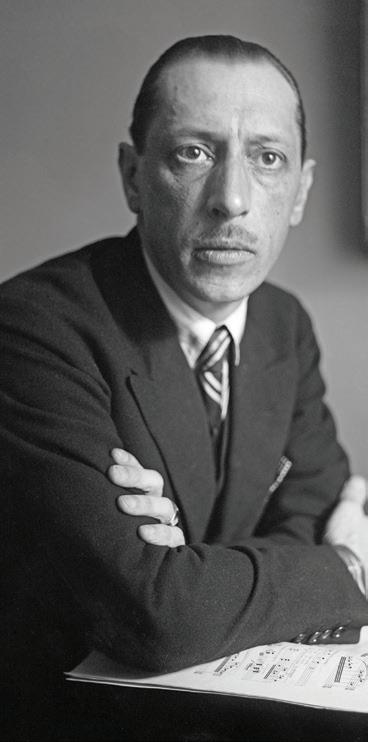
Born: June 17, 1882, Oranienbaum, Russia
Died: April 6, 1971, New York
Igor Stravinsky: Petrushka
Composed: 1910–1911
Premiere: June 13, 1911, Paris, at the Théâtre du Châtelet (staged ballet) by the Ballet Russes, Pierre Monteux conducting; Michel Fokine, choreographer. Stravinsky revised the orchestration 1915–1946, and his final thoughts are known as the “Revised 1947 Version,” which is heard at these concerts.
Instrumentation: 3 flutes (incl. piccolo), 2 oboes, English horn, 3 clarinets (incl. bass clarinet), 2 bassoons, contrabassoon, 4 horns, 3 trumpets, 3 trombones, tuba, timpani, bass drum, bass drum with attached cymbal, crash cymbals, snare drums, suspended cymbals, tam-tam, tambourine, triangle, xylophone, harp, celeste, piano, strings
CSO notable performances: First: November 1961, Max Rudolf conducting. Most Recent: November 2019, Louis Langrée conducting.
Duration: approx. 34 minutes
After the resounding success of The Firebird in 1908, Stravinsky became an instant celebrity in Paris. His name was now inseparable from the famous Ballets Russes, whose director, Sergei Diaghilev, was anxious to continue this most promising collaboration. Plans were soon underway for what eventually became The Rite of Spring. But events took a slight detour: in the summer of 1910, Stravinsky began writing a piece for piano and orchestra in which the piano represented for him “a puppet, suddenly endowed with life, exasperating the patience of the orchestra with diabolical cascades of arpeggios.” The puppet was none other than Petrushka, the popular Russian puppet-theatre hero, the equivalent of Punch in “Punch and Judy” shows.
When Diaghilev visited Stravinsky in Lausanne later in the summer, he expected his friend to have made some progress with The Great Sacrifice (the working title of The Rite of Spring); instead, he found him engrossed in a piece for piano and orchestra. Diaghilev immediately saw the dramatic potential of Stravinsky’s concert piece and persuaded the composer to turn it into a ballet. (The soloistic handling of the piano in the final version is a reminder of the original scoring.) Alexandre Benois, a Russian artist and longtime Diaghilev collaborator, wrote the scenario with Stravinsky, and designed the sets and costumes for the performance.
In traditional Russian puppet shows, Petrushka was, according to one description, “a devil-may-care oddball, a wisecracker and disturber of the peace.” As musicologist Richard Taruskin has pointed out, however, the hero of the ballet has little to do with that characterization. He is, rather, a reincarnation of the French Pierrot, the sad-eyed clown with a white face and wearing a white suit with large black buttons. The plot was based not on the Russian Petrushka plays but rather on the classical love triangle from the commedia dell’arte tradition from Renaissance Italy, involving Pierrot, Colombine and Harlequin (to use their French names, which are more relevant here). Yet in the first and last scenes, Benois recreated the atmosphere of the old shrove-tide fairs in Russia, a tradition he remembered from his childhood. The structure of the ballet, with two outer scenes depicting a Russian fair and two inner scenes representing a love story that transcends time and place, is more than a neat symmetrical device. It expresses a contrast between Russia and the West, between the public and the private spheres, and between the worlds of humans and puppets. Yet, as Taruskin writes:
… the “people” ... are represented facelessly by the corps de ballet. Only the puppets have “real” personalities and emotions. The people in Petrushka act and move mechanically, like toys. Only the puppets act spontaneously, impulsively— in a word, humanly.
—©Peter Laki
Carlos Simon
SAT NOV 29, 7:30 PM | SUN NOV 30, 2 PM Music Hall
Cristian Măcelaru conductor
Tessa Lark violin
Tales: A Folklore Symphony (b. 1986)
Motherboxx Connection
Flying Africans
Go Down, Moses (Let My People Go)
John Henry
Lisa Bielawa
Violin Concerto No. 2, PULSE cso co-commission (b. 1968)
Tin Pan Alley
The Shapes
Old Time
Aaron Copland Variations on a Shaker Melody from Appalachian Spring (1900–1990)
Antonín Dvořák
Symphony No. 7 in D Minor, Op. 70 (1841–1904)
Allegro maestoso
Poco adagio
Scherzo: Vivace
Finale: Allegro
These performances are approximately 125 minutes long, including intermission.
The CSO is grateful to CSO Season Sponsor Western & Southern Financial Group and Fort Washington Investment Advisors. Violin Concerto No. 2, PULSE by Lisa Bielawa is made possible by Kari and Jon Ullman.

Support for the co-commission of Violin Concert No. 2, PULSE was provided by New Music USA’s Amplifying Voices Program. New Music USA’s Amplifying Voices program is powered by the Sphinx Organization, with additional support from ASCAP, the Sorel Organization, the Virginia B. Toulmin Foundation, the Wise Music and the Wise Family Charitable Foundation, and the Francis Goelet Charitable Lead Trust.
The Cincinnati Symphony Orchestra is grateful for the support of the Louise Dieterle Nippert Musical Arts Fund of the Greenacres Foundation, the Nina Browne Parker Trust, and the thousands of people who give generously to the ArtsWave Community Campaign, the region’s primary source for arts funding. This project was supported in part by the Ohio Arts Council, which receives support from the State of Ohio and the National Endowment for the Arts.
Pre-Concert Talks are made possible by an endowed gift from Melody Sawyer Richardson. WGUC is the Media Partner for these concerts. This concert will air on 90.9 WGUC on February 1, 2026, followed by 30 days of streaming at cincinnatisymphony.org/replay.
The CSO in-orchestra Steinway piano is made possible in part by the Jacob G. Schmidlapp Trust
with Cristian Măcelaru, Music Director

Last season, on breaks from some CSO business, Cristian Măcelaru attended banjoist Béla Fleck’s concert at Music Hall. It was, he recalls with equal parts pleasure and astonishment, “a completely different crowd. People, of course, associate the banjo with Appalachian culture. And that’s totally true,” he says.
Lisa Bielawa will lean into that heritage in her concerto PULSE, a CSO co-commission for violinist Tessa Lark. An alum of CCM’s preparatory strings program, Lark enriches her classical career with bluegrass chops from her upbringing in Kentucky.
PULSE is flanked by three other pieces with folk origins. The most famous of the bunch is Aaron Copland’s “Variations on a Shaker Melody,” from his 1944 ballet Appalachian Spring. The short piece riffs on “Simple Gifts,” a song little-known outside the pacifist religious sect at the time Copland arranged it for orchestra. Another is Carlos Simon’s Tales: A Folklore Symphony.
Măcelaru first met Simon through the Cabrillo Festival of Contemporary Music, where he also serves as music director. The symphony’s roots in the African-American spiritual tradition — Simon grew up in the Black church — deeply appealed to Măcelaru.
He sees parallels between Simon’s work and Antonín Dvořák’s campaign to create an American school of music based on AfricanAmerican and Native American traditions. But because of the difference in their identities — Dvořák as a middle-aged, homesick Czech immigrant in late 19th century America, and Simon as a Black millennial living in the 21st century — “their treatment of the same spiritual is a world apart,” says Măcelaru.
“That’s why it’s important to have different composers talk about the same thing: It has different meanings,” he says. “What’s really beautiful to me is to see how four different composers turn the idea of folklore into a truly personal statement of identity, of who they are as artists.”
—Hannah Edgar
To view the Digital Program for exclusive content, such as full-length program notes and artist biographies, please text PROGRAM to 513.845.3024*, use your mobile device to scan the QR code or visit cincinnatisymphony.org/digitalprogram.
*By texting to this number, you may receive messages that pertain to the organization and its performances; msg & data rates may apply. Reply HELP to help, STOP to cancel.
Cristian Măcelaru, conductor
A complete biography for Music Director Cristian Măcelaru can be found on p. 23.
violin
Violinist Tessa Lark is one of the most captivating artistic voices of our time, consistently praised by critics and audiences for her astounding range of sounds, technical agility and musical elegance. She is also a highly acclaimed fiddler in the tradition of her native Kentucky, delighting audiences with programming that includes Appalachian and bluegrass music and inspiring composers to write for her.
In addition to her performance schedule, Lark is the newly minted artistic director of the Moab Music Festival. She also continues her work as artistic director of Musical Masterworks, a chamber music series in Old Lyme, Connecticut.
Lark’s 2025–26 season features PULSE, a new concerto written for her by Lisa Bielawa. Other season highlights include returns to the Chamber Music Society of Palm Beach, Pasadena Symphony, Tucson Symphony and Lexington Philharmonic. In recital, she debuts with the Da Camera Society of Texas and returns to The Cliburn and Oregon’s Sunriver Music Festival. She reprises Michael Torke’s violin concerto, Sky — the piece was written for her and her 2020 recording of it earned a Grammy nomination — with the San Antonio Philharmonic. As a chamber musician, she tours with her string trio project with composer-bassist Edgar Meyer and cellist Joshua Roman.
Lark’s most recent album, The Stradgrass Sessions, released in spring 2023, features an all-star roster of collaborators and composers, including Edgar Meyer, pianist Jon Batiste, mandolinist Sierra Hull and fiddler Michael Cleveland. The album’s selections mix original compositions by Lark and her collaborators with a sonata by Eugène Ysaÿe, a selection of Bartók violin duets arranged for violin and mandolin and the world premiere recording of John Corigliano’s STOMP.
Lark is a recipient of the Hunt Family Award, one of Lincoln Center’s prestigious Emerging Artist Awards, as well as a 2018 Borletti-Buitoni Trust Fellowship and a 2016 Avery Fisher Career Grant, among other awards. She is a graduate of the New England Conservatory and earned her Artist Diploma at The Juilliard School. She plays a ca. 1600 G.P. Maggini violin on loan from an anonymous donor through the Stradivari Society of Chicago. tessalark.com
Carlos Simon: Tales: A Folklore Symphony
Composed: 2021
Premiere: January 26, 2022, Ann Arbor, Mich., University of Michigan Symphony Orchestra, Kenneth Kiesler conducting
Instrumentation: 2 flutes (incl. piccolo), 2 oboes, 2 clarinets, 2 bassoons, 4 horns, 2 trumpets, 3 trombones, tuba, timpani, drum set, anvil, bass drum, glockenspiel, guiro, 2 leather gloves, mark tree, snare drum, suspended cymbals, tam-tam, tomtom, triangle, tubular bells, vibraphone, whip, strings
CSO notable performances: These are the first CSO performances of Tales: A Folklore Symphony.
Duration: approx. 23 minutes
Carlos Simon’s music ranges from concert works for large and small ensembles to film scores with influences of jazz, gospel and neo-romanticism. He is the current composer-in-residence for the John F. Kennedy Center for the Performing Arts and frequently writes for the National Symphony Orchestra and Washington National Opera. Simon also is the inaugural composer chair of the Boston Symphony Orchestra.
Recent premiere performances of his music have been given by the National Symphony Orchestra, Boston Symphony Orchestra, BBC Symphony Orchestra for the Last Night of the Proms (his BBC Proms commissioning debut), Jacksonville Symphony Orchestra, Cincinnati Pops Orchestra, Carnegie Hall for the National
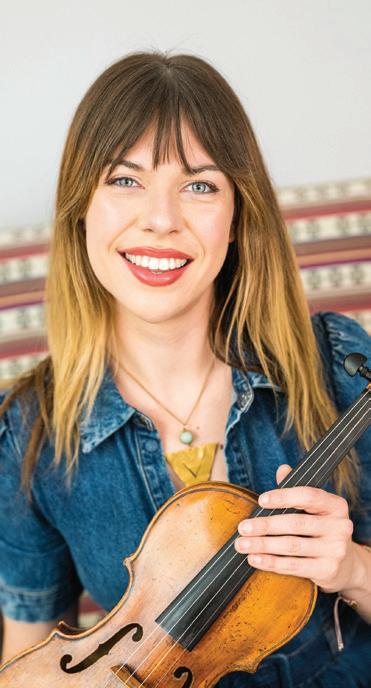

Born: 1986, Washington, D.C.
Youth Orchestra of the USA and the LA Philharmonic, for Gospel Mass, a work reimagining the traditional mass with gospel soloists and choir, with visual creations from Melina Matsoukas (Beyoncé’s Formation, Queen & Slim). Simon was nominated for a 2023 Grammy for Best Contemporary Classical Composition for Requiem for the Enslaved, a multi-genre musical tribute to commemorate the stories of the 272 enslaved men, women and children sold in 1838 by Georgetown University. He has served as a member of the music faculty at Spelman College and Morehouse College in Atlanta and now is an associate professor at Georgetown University. carlossimonmusic.com
Here are excerpts from Carlos Simon’s synopsis of Tales: A Folklore Symphony:
Tales: A Folklore Symphony is a four-movement piece for orchestra that explores African American folklore as well as Afrofuturist stories. The work was commissioned by the Sphinx Organization for its 25th anniversary and the University of Michigan Symphony Orchestra.
I. Motherboxx Connection. “Where are all the Black people in comics?” This is a question posed by the creative duo Black Kirby (John Jennings and Stacey Robinson). Based heavily in Afrofuturism, Black Kirby’s characters show Black people as heroes, using ancient customs and futurist motifs from the African and African American diaspora. This piece is inspired by the many heroic characters found in the work of Black Kirby, but mainly Motherboxx Connection. …
II. Flying Africans. Once, all Africans could fly, but lost their ability once they crossed the Atlantic Ocean as enslaved humans. This story tells how one African maintained the ability and secretly passed the gift on to others. The Negro spiritual “Steal Away” is referenced in the woodwinds, as well as in the cello section, while the upper strings hover effortlessly in the higher register.
III. Go Down Moses (Let My People Go). The Jewish biblical story of the Plagues of Egypt resonated with the enslaved, and they created songs that related to this story of bondage. While the horrific plagues that swept across Egypt are compelling in and of themselves, the focus of this piece is recounted from the perspective of the stubborn Pharaoh, who unwillingly loosens his grip on the enslaved people. The Pharaoh’s hardened heart is conveyed through two sharp, accented chords. The spirit of God, represented by light, heavenly, metallic sounds from the percussion, signals the beginning of each new plague. … The orchestral texture grows thinner and thinner as the Pharaoh loathes in emotional anguish. The once prideful Pharaoh is now broken down to a powerless whimper. I use the Negro spiritual “Let My People Go (Go Down, Moses)” as a musical framework throughout this movement.
IV. John Henry. The story of John Henry is traditionally told through the work song, in versions with wide-ranging and varying lyrics. The well-known narrative ballad of “John Henry” is essentially the battle between man versus machine. Enslaved prisoners would often sing the story more slowly and deliberately, often with a pulsating beat suggestive of swinging the hammer. These songs usually contain the lines, “This old hammer killed John Henry / but it won’t kill me.”
Lisa Bielawa: Violin Concerto No. 2, PULSE cso co-commission
Composed: 2024, co-commissioned by the Koussevitzky Foundation, Library of Congress; Boston Modern Orchestra Project; and Louisville Orchestra; with the Cincinnati Symphony Orchestra and Santa Fe Pro Musica. Support has been provided by James Rosenfield, Justus Schlichting, Kari and Jon Ullman, New Music USA’s Amplifying Voices Program and the Loghaven Artist Residency. Dedicated to the memory of Jim Rosenfield. Composed for violinist Tessa Lark.
Premiere: October 2025, Teddy Abrams conducting the Louisville Orchestra
Instrumentation: solo violin, 2 flutes (incl. piccolo), oboe, English horn, 2 clarinets (incl. bass), 2 bassoons, 4 horns, 3 trumpets, 2 trombones, tuba, timpani, bass drum, bongo, crash cymbals, finger cymbals, glockenspiel, mark tree, sizzle cymbal, snare drum, suspended cymbals, tam-tam, tambour de Basque, temple blocks, tenor drum, tom-toms, triangle, tubular bells, vibraphone, wind chimes, harp, strings
CSO notable performances: These are the first CSO performances of PULSE.
Duration: approx. 23 minutes
Composer, producer and vocalist Lisa Bielawa is a Guggenheim Fellow and Rome Prize winner who takes inspiration for her work from literary sources and close artistic collaborations. Her music has been premiered at the NY Phil Biennial, Lincoln Center, Carnegie Hall, The Kennedy Center, SHIFT Festival, National Cathedral, Rouen Opera, MAXXI Museum in Rome and Helsinki Music Center, among others. Orchestras that have championed her music include The Knights, Boston Modern Orchestra Project, ROCO and the Orlando Philharmonic. Premieres of her work have been commissioned and presented by the Chamber Music Society of Lincoln Center, Brooklyn Rider, Seattle Chamber Music Society, Radio France, Yerevan Concert Hall in Armenia, the Venice Architectural Biennale, American Music Week in Salzburg, the INFANT Festival in Novi Sad, Serbia, and more. Bielawa consistently incorporates community-making as part of her artistic vision. She has created music for public spaces in Lower Manhattan, a bridge over the Ohio River in Louisville, the banks of the Tiber River in Rome, on the sites of former airfields in Berlin and San Francisco, and to mark the 30th anniversary of the fall of the Berlin Wall. During the pandemic, Bielawa cultivated a virtual community using submitted testimonies and recorded voices from six continents through her work Broadcast from Home, now archived by the Library of Congress. lisabielawa.net.
Below are excerpts from Bielawa’s program note about PULSE:
The musical definition of “pulse” takes center stage in this work, composed expressly for a violinist with an impeccable inner metronome. But the word’s other meanings have guided its fascinations as well. This concerto was conceived as a way of keeping my finger on the pulse of American life during a period of seismic change and self-examination. Composed over a six-month period starting just before the 2024 presidential election, it is also informed by my immersion during this time in our sentimental history as told through our traditional musics.
Tessa Lark’s artistry draws from multiple musical traditions, from old-time to jazz to the classical avant-garde. I have had the enviable opportunity to hear Tessa play in the Smoky Mountains with Appalachian traditional musicians, at the Blue Note in midtown Manhattan, and on concert stages in concertos and chamber music both new and old.
I turned first to the surging popular song market of Tin Pan Alley, during the time just before, during and after the Great War. Composers and lyricists, many of them recent Jewish immigrants from Eastern Europe, churned out their songs all along 28th Street in Manhattan. … The first two orchestral sections of the Tin Pan Alley movement, which are separated by a freely composed first cadenza, are actually mosaics, faithfully composed entirely of small fragments — from a couple of beats to a couple of measures — of 27 different songs published between 1914 and 1923. The remainder of the movement captures some of the rich sonorities created by the chromatic passing harmonies and stretches them out into “changes” over which the soloist dances virtuosically, eventually improvising over them as in a jazz chart.
The second movement, The Shapes, takes its name from the directive “Sing the shapes,” which is what song leaders in the Old Harp tradition say when they are
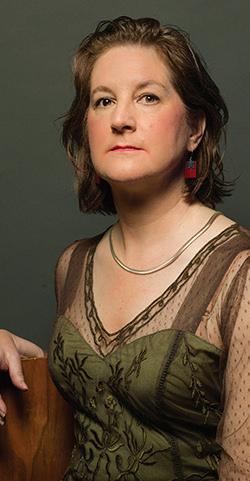
Born: September 30, 1968, San Francisco, California
standing in the “hollow square” of a traditional shape-note Singing. This lyrical movement is a meditation on the traditional American hymn “Wondrous Love,” which was a favorite of mine when I was a child in my mother’s church choir. … The movement also derives some of its color from another deeply intimate meaning of “pulse” — lying awake with my ear on the pillow, hearing the sound of my own blood pumping. …
The last movement gives Tessa a chance to bring her old-time fiddling onto the orchestral stage. Three traditional American tunes are embedded wholesale in the score — “Blackberry Blossom” (Texas/Oklahoma), “Ducks on the Pond” (West Virginia) and “Dry & Dusty” (Southwest). Only the starting point and the number of verses is given in the score. While Tessa brings this whole other side of her virtuosity to her fiddle, changing eventually to an instrument in traditional “D” tuning, the orchestra partners her with its own enthusiasms and fragmentary looks back to the first two movements. In this movement, as in the other two to some degree, I liken my encounter with a musical tradition that is outside my own experience to the philosophy guiding traditional Japanese cuisine: different elements must balance each other perfectly but must never actually touch on the plate. Tessa’s own American voice comes through in its purest form, and the orchestra pulses along.
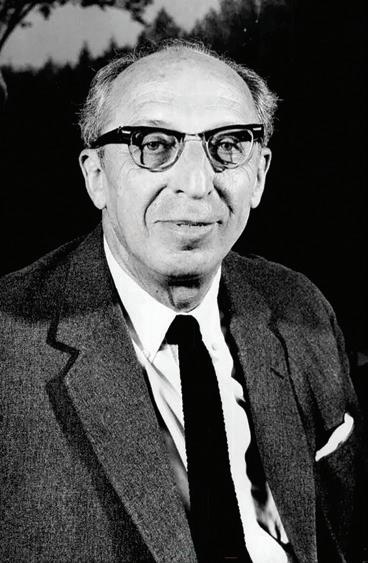
Composed: Full ballet, 1944; wind band version, 1956, orchestral version, 1967
Premiere: Full ballet, October 30, 1944, at the Library of Congress, Washington, D.C.
Instrumentation: 2 flutes (incl. piccolo), 2 oboes, 2 clarinets, 2 bassoons, 2 horns, 2 trumpets, 2 trombones, timpani, glockenspiel, triangle, harp, piano, strings
CSO notable performances: Although the CSO has performed the Variations on a Shaker Melody many times over the decades on Educational, Parks and Pops concerts, this weekend marks the first CSO subscription performances.
Duration: approx. 4 minutes
Aaron Copland created his Variations on a Shaker Melody by revising his version of the now-familiar “Simple Gifts” Shaker tune as it is heard at the center of his score for Appalachian Spring (1944). Though he found “Simple Gifts” in an anthology and did not collect it himself, Copland has been credited with bringing it to wide renown and fostering its rich and growing American musical legacy.
The ballet portrays vignettes around a Bride and Husbandman’s wedding as a Pioneer Woman, a Revivalist Preacher and his Followers mingle throughout. The “Simple Gifts” variations serve as the drama’s focal point, during which the betrothed perform an extended danced duet. The ballet’s stock characters and simple plot have been to the ballet’s advantage, lending audiences an opportunity to see themselves in its personae. The song’s familiar text (“’Tis a gift to be simple, ’tis a gift to be free”) reflects a sense of place and community that is difficult to parse from the appeal of Appalachian Spring and the Variations. Within Copland’s musically diverse catalog, many take these pieces and their style as most emblematic of an American sound. Indeed, Appalachian Spring was composed during the transitional period at the end of World War II, and the Variations were created in the thick of the Cold War. Each version resonates the challenges of history while also sounding out an intractable optimism. Indeed, the melody is imbued with an enduring quality and has been used and reused for many purposes, from serving as the basis of a popular Christian hymn to inspiring film scores and musical performances for the inaugurations of American presidents.
The Variations themselves play out such that individual sections indispensably construct a larger, emotionally varied whole. After an introduction, a solo clarinet presents the melody in full, supported by punctuating flute. Various instruments then take charge of the melody through the variations — highlighted by one variation with a tick-ticking accompaniment and another with exclamatory brass — culminating in a broad, chorale-like finale with the full orchestra.
—©Jacques Dupuis
Antonín Dvořák: Symphony No. 7 in D Minor, Op. 70
Antonín Dvořák: Symphony No. 7 in D Minor, Op. 70
Composed: 1884–85
Composed: 1884–85
Premiere: April 22, 1885, London Philharmonic Orchestra, St. James’s Hall, London, Antonín Dvořák conducting
Premiere: April 22, 1885, London Philharmonic Orchestra, St. James’s Hall, London, Antonín Dvořák conducting
Instrumentation: 2 flutes (incl. piccolo), 2 oboes, 2 clarinets, 2 bassoons, 4 horns, 2 trumpets, 3 trombones, timpani, strings
Instrumentation: 2 flutes (incl. piccolo), 2 oboes, 2 clarinets, 2 bassoons, 4 horns, 2 trumpets, 3 trombones, timpani, strings
CSO notable performances: First: December 1940, Eugene Goossens conducting. Most Recent: October 2016, Neeme Järvi conducting. Notable: As part of the 2004 European Tour, Paavo Järvi conducting.
CSO notable performances: First: December 1940, Eugene Goossens conducting.
Most Recent: October 2016, Neeme Järvi conducting. Notable: As part of the 2004 European Tour, Paavo Järvi conducting.
Duration: approx. 35 minutes
Duration: approx. 35 minutes
Widely considered one of the most famous Czech composers, Antonín Dvořák composed masterfully in a wide variety of genres and styles. Over the course of his career, his compositional style shifted as he developed new musical languages and adopted new approaches. Dvořák’s music reflects the tensions of identity he experienced as a Czech composer loyal to his heritage and navigating a German musical network.
Widely considered one of the most famous Czech composers, Antonín Dvořák composed masterfully in a wide variety of genres and styles. Over the course of his career, his compositional style shifted as he developed new musical languages and adopted new approaches. Dvořák’s music reflects the tensions of identity he experienced as a Czech composer loyal to his heritage and navigating a German musical network.
He composed the Symphony No. 7 in the early 1880s for the Philharmonic Society of London, when political tensions in Europe gave rise to anti-Czech sentiments in Vienna. This political climate placed Dvořák in a complicated position, as he wanted to remain loyal to his homeland while also seeking success in the Germanic musical scene. During this time of conflicting pressures in his compositional identity, Dvořák stepped back from the explicit Slavonic elements that permeated his earlier works. Hints of Slavonic tones became more subtle, and his music overall became darker and more dramatic.
He composed the Symphony No. 7 in the early 1880s for the Philharmonic Society of London, when political tensions in Europe gave rise to anti-Czech sentiments in Vienna. This political climate placed Dvořák in a complicated position, as he wanted to remain loyal to his homeland while also seeking success in the Germanic musical scene. During this time of conflicting pressures in his compositional identity, Dvořák stepped back from the explicit Slavonic elements that permeated his earlier works. Hints of Slavonic tones became more subtle, and his music overall became darker and more dramatic.
The serious and dramatic nature of his symphony reflects the complex emotions he had been experiencing in his crisis of compositional identity. The music also exhibits Dvořák’s ambition to compose a great symphony, inspired after hearing Brahms’s Third Symphony at the end of 1883. Dvořák was resolved to present the London Philharmonic Society with quality work. His choice of the key of D minor positions his Seventh Symphony alongside other great works in that key, including Mozart’s Requiem, Beethoven’s Ninth Symphony and Brahms’ Piano Concerto No. 1.
The serious and dramatic nature of his symphony reflects the complex emotions he had been experiencing in his crisis of compositional identity. The music also exhibits Dvořák’s ambition to compose a great symphony, inspired after hearing Brahms’s Third Symphony at the end of 1883. Dvořák was resolved to present the London Philharmonic Society with quality work. His choice of the key of D minor positions his Seventh Symphony alongside other great works in that key, including Mozart’s Requiem, Beethoven’s Ninth Symphony and Brahms’ Piano Concerto No. 1.
The first movement, Allegro maestoso, begins with the dark sounds of the low strings establishing the somber mood of D minor in the primary theme. A solo line in the horn and oboe momentarily breaks through the darkness, and the sweet B-flat major second theme in the flutes and clarinets lightens the atmosphere. The movement proceeds with drama, with the recapitulation bringing back the majorkey second theme first followed by the minor-key main theme. As the movement comes to a close, the music grows in intensity before suddenly subsiding and ending in a subdued spirit.
The first movement, Allegro maestoso, begins with the dark sounds of the low strings establishing the somber mood of D minor in the primary theme. A solo line in the horn and oboe momentarily breaks through the darkness, and the sweet B-flat major second theme in the flutes and clarinets lightens the atmosphere. The movement proceeds with drama, with the recapitulation bringing back the majorkey second theme first followed by the minor-key main theme. As the movement comes to a close, the music grows in intensity before suddenly subsiding and ending in a subdued spirit.
The second movement is a serene F major, opening with prayer-like melodies in the winds. Moments of heaviness and agitation threaten to disrupt the tranquility, but expressive solos and pastoral sweetness restore hopefulness.
The second movement is a serene F major, opening with prayer-like melodies in the winds. Moments of heaviness and agitation threaten to disrupt the tranquility, but expressive solos and pastoral sweetness restore hopefulness.
The Scherzo third movement quietly introduces the syncopated rhythms of a furiant, a Czech folk dance, growing in energy to the full exuberance of the dance rhythm. A calmer pastoral Trio section takes over before the furiant music returns to conclude the movement.
The Scherzo third movement quietly introduces the syncopated rhythms of a furiant, a Czech folk dance, growing in energy to the full exuberance of the dance rhythm. A calmer pastoral Trio section takes over before the furiant music returns to conclude the movement.
The fourth movement concludes the symphony with the drama and compositional mastery exhibited throughout the piece. An octave jump and pronounced shift in dynamics in the D minor first theme set the stage for the intensity to follow. The A major second theme is introduced by the cello and taken up by the flute and oboe, offering a moment of brightness. Emotional turbulence builds as the movement continues to develop, culminating in an expressive coda in D minor that turns to a resolute D major in the final bars.
The fourth movement concludes the symphony with the drama and compositional mastery exhibited throughout the piece. An octave jump and pronounced shift in dynamics in the D minor first theme set the stage for the intensity to follow. The A major second theme is introduced by the cello and taken up by the flute and oboe, offering a moment of brightness. Emotional turbulence builds as the movement continues to develop, culminating in an expressive coda in D minor that turns to a resolute D major in the final bars.
—©Dr. Rebecca Schreiber
—©Dr. Rebecca Schreiber

Born: September 8, 1841, Nelahozeves, Czechia
Born: September 8, 1841, Nelahozeves, Czechia
Died: May 1, 1904, Prague, Czechia
Died: May 1, 1904, Prague, Czechia
HANDEL’S MESSIAH | 2025–26 SEASON
FRI DEC 5, 7:30 PM | SAT DEC 6, 7:30 PM Music Hall
Cristian Măcelaru conductor
Lauren Snouffer soprano
Sasha Cooke mezzo-soprano
Nicholas Phan tenor
Jonathan Lemalu bass
May Festival Chorus Matthew Swanson, director
George Frideric Handel Messiah (1685–1759)
PART I
Overture
Comfort ye, my people
Ev’ry valley shall be exalted And the glory of the Lord
Thus saith the Lord But who may abide And He shall purify
Behold, a virgin shall conceive
O thou that tellest good tidings to Zion For, behold, darkness
The people that walked in darkness For unto us a Child is born
Pastoral Symphony
There were shepherds abiding in the field And lo! the Angel of the Lord came upon them And the Angel said unto them And suddenly there was with the Angel Glory to God
Rejoice greatly, O daughter of Zion
Then shall the eyes of the blind be opened He shall feed his flock like a shepherd His yoke is easy, His burthen is light
The CSO is grateful to CSO Season Sponsor Western & Southern Financial Group and Fort Washington Investment Advisors.
The Cincinnati Symphony Orchestra is grateful for the support of the Louise Dieterle Nippert Musical Arts Fund of the Greenacres Foundation, the Nina Browne Parker Trust, and the thousands of people who give generously to the ArtsWave Community Campaign, the region’s primary source for arts funding. This project was supported in part by the Ohio Arts Council, which receives support from the State of Ohio and the National Endowment for the Arts Pre-Concert Talks are made possible by an endowed gift from Melody Sawyer Richardson WGUC is the Media Partner for these concerts. This concert will air on 90.9 WGUC on February 8, 2026, followed by 30 days of streaming at cincinnatisymphony.org/replay.
The CSO in-orchestra Steinway piano is made possible in part by the Jacob G. Schmidlapp Trust.
PART II
Behold the Lamb of God
He was despised
Surely He hath borne our griefs
And with His stripes we are healed
All we like sheep have gone astray
All they that see Him laugh Him to scorn He trusted in God that He would deliver Him
Thy rebuke hath broken His heart
Behold, and see if there be any sorrow
He was cut off out of the land of the living
But Thou didst not leave His soul in hell
Hallelujah
PART III
I know that my Redeemer liveth Behold, I tell you a mystery
The trumpet shall sound
If God be for us, who can be against us?
Worthy is the Lamb that was Slain. Amen.
These performances are approximately 135 minutes long, including intermission.

with Cristian Măcelaru, Music Director

Back when he wielded a bow more often than a baton, CSO Music Director Cristian Măcelaru’s Decembers used to be clotted with performances of Handel’s Messiah Workaday musicians joke that performances of the perennial are so plentiful that they tend to pay for their holiday plans many times over. Măcelaru was no exception. Even so, no two performances of the Christmas classic were ever the same — especially not when Măcelaru was coming of age, in the early 2000s. No longer a fringe musical movement, historically informed performance practice had solidly entered the mainstream, where it remains today. Still, the purism of approach varies wildly. Does one use a countertenor or a mezzo? Period or modern instruments? And what cuts are observed, if any?
Măcelaru’s experience in historically informed performance practice dates back to his graduate work at Rice University.
Unbeknownst to him, his violin teacher, Sergiu Luca, was a leader in the historically informed performance movement; the two played together as part of an organization called Music in Context, which performed repertoire on instruments from the period and region.
Though he’s not going to ask the orchestra to use Baroque bows and gut strings, Măcelaru says his Messiah with the CSO and May Festival Chorus will draw on lessons he learned from Luca — and, yes, years of playing his own Messiahs with minimal rehearsal time.
“I tell the orchestra and chorus to begin with a very simple concept: If the music goes up, so does the intensity; if the musical line goes down, so does the intensity. Then, I’ll let them know when we inevitably break this rule,” he says. “But if you start from that point of view, you already have a different way of listening to each other.”
—Hannah Edgar
To view the Digital Program for exclusive content, such as full-length program notes and artist biographies, please text PROGRAM to 513.845.3024*, use your mobile device to scan the QR code or visit cincinnatisymphony.org/digitalprogram.
the organization and its performances; msg & data rates may apply. Reply HELP to help, STOP to cancel.
Cristian Măcelaru, conductor
A complete biography for Music Director Cristian Măcelaru can be found on p. 23.
Lauren Snouffer, soprano
Recognized for her unique artistic curiosity in world-class performances spanning the music of Claudio Monteverdi and Georg Frideric Handel through to Missy Mazzoli and Sir George Benjamin, American Lauren Snouffer is celebrated as one of the most versatile and respected sopranos on the international stage.
Lauren Snouffer makes her Metropolitan Opera debut this season as Sarah Kavalier in the premiere of The Amazing Adventures of Kavalier and Clay, an adaptation by Mason Bates and Gene Scheer of Michael Chabon’s Pulitzer Prizewinning novel. Additionally, Snouffer makes her role debut as Stella Kowalski at Opera Theatre of Saint Louis in Sir André Previn’s A Streetcar Named Desire. Symphonic performances of the 2025–26 season include the world premiere of Angélica Négron’s For everything you keep losing with the Dallas Symphony Orchestra, Hans Abrahamsen’s Let Me Tell You at the Minnesota Orchestra, and the role of Pamina in Die Zauberflöte with the Saint Louis Symphony. Her concert profile has yielded marvelous results with Franz Welser-Möst and The Cleveland Orchestra, Raphaël Pichon and the Handel & Haydn Society, Masaaki Suzuki and the San Francisco Symphony, Dame Jane Glover and Music of the Baroque, Manfred Honeck and the Pittsburgh Symphony, Jaap van Zweden and the New York Philharmonic, Alan Gilbert conducting the NDR Elbphilharmonie Orchester and Marin Alsop and the Orquestra Sinfônica do Estado de São Paulo. Fervently committed to repertoire of the Baroque and Classical eras, Lauren Snouffer has performed Die Zauberflöte at Glyndebourne, Opernhaus Zürich and Seattle Opera; La clemenza di Tito and Orphée et Eurydice at Lyric Opera of Chicago; Hasse’s Siroe at the Opéra Royal de Versailles with additional performances in Budapest and Vienna; and Monteverdi’s Orfeo with a world premiere orchestration by Nico Muhly at Santa Fe Opera. She has enjoyed many successes at Houston Grand Opera in productions led by Patrick Summers and Harry Bicket, among others. etudearts.com/artists/lauren-snouffer
Sasha Cooke, mezzo-soprano
Praised by Opera magazine for her “agile, glamorous presence,” two-time Grammy Award-winning mezzo-soprano Sasha Cooke has been called a “luminous standout” by The New York Times and “equal parts poise, radiance and elegant directness” by Opera News. Cooke has sung at the Metropolitan Opera, San Francisco Opera, English National Opera, Seattle Opera, Opéra National de Bordeaux, and Gran Teatre del Liceu, among others, and with over 80 symphony orchestras worldwide, frequently in the works of Mahler. This season, she returns to Houston as Hänsel in Houston Grand Opera’s Hänsel und Gretel opposite Mané Galoyan, making her directorial debut leading the company’s family day presentation of the opera. She later joins Seattle Opera for her role debut in the title role of Bizet’s Carmen. In recital, Cooke tours her program Of Thee I Sing with pianist Myra Huang, appearing at the Kennedy Center presented by the Vocal Arts Society of D.C., Baylor University’s Distinguished Artists Series, Park Avenue Armory and the Isabella Stewart Gardner Museum. On the concert stage, she sings Mahler’s Symphony No. 2 at the Ravinia Festival with the Chicago Symphony Orchestra and Marin Alsop, followed by the world premiere of Alex Turley’s the ocean’s dream of itself at the Grand Teton Music Festival, conducted by Sir Donald Runnicles. She joins Yannick Nézet-Séguin and The Philadelphia Orchestra for Verdi’s Requiem at Saratoga Performing Arts Center and appears with the Baltimore Symphony, Palau de les Arts Reina Sofía and the Yomiuri Nippon Symphony Orchestra in Mahler’s Das Lied von der Erde, a signature piece of hers. She sings Handel’s Messiah with Music

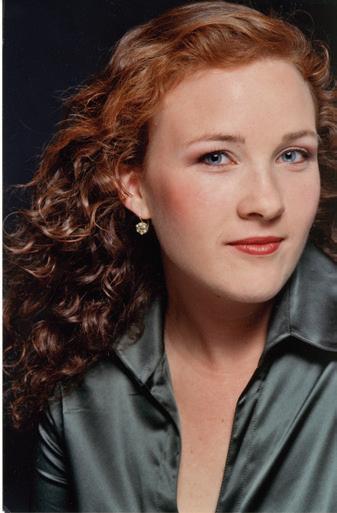
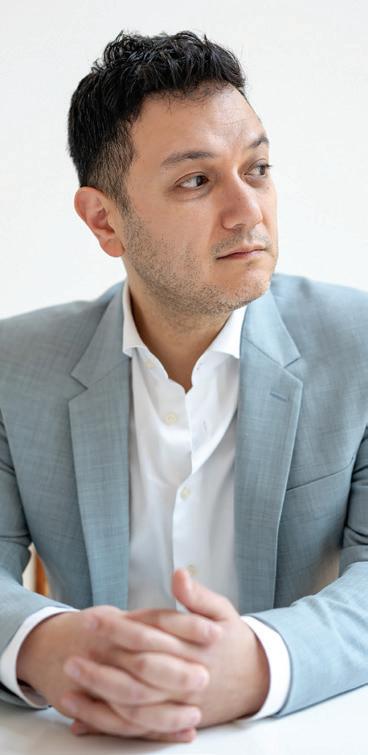
of the Baroque and Jane Glover, and with the Cincinnati Symphony Orchestra and Cristian M celaru. She returns to the San Francisco Symphony for Mozart’s Requiem conducted by Manfred Honeck and joins the Wiener Symphoniker in Mahler’s Symphony No. 3 conducted by Petr Popelka. Additional concert appearances include Elgar’s Sea Pictures with the Sydney Symphony and Sir Donald Runnicles and Verdi’s Requiem with the Detroit Symphony. She joins the Boston Symphony Orchestra Chamber Players for Mahler’s Lieder eines fahrenden Gesellen, which she also sings with Bilbao Orkestra Sinfonika. sashacooke.com
Nicholas Phan, tenor
Nicholas Phan is a Grammy Award-winning lyric tenor, curator and educator, celebrated for his expressive artistry and versatility across a repertoire spanning nearly 500 years. Described by The Boston Globe as “one of the world’s most remarkable singers,” he has earned international recognition for his captivating stage presence, keen intelligence and natural musicianship. In 2010, he co-founded Art Song Chicago to promote art song and vocal chamber music and serves as its artistic director.
Phan won the 2025 Grammy Award for Best Opera Recording for his recording of Kaija Saariaho’s Adriana Mater with Esa-Pekka Salonen and the San Francisco Symphony. His album, A Change is Gonna Come, was nominated for the 2025 Grammy Award for Best Classical Solo Vocal Album. His previous albums, Stranger: Works for Tenor by Nico Muhly, Clairières and Gods and Monsters, were nominated for the same award in 2023, 2020 and 2017. He is the first singer of Asian descent to be nominated in the history of the Best Classical Solo Vocal Album category, which has been awarded by the Recording Academy since 1959.
Sought after as a curator and programmer, in addition to his work as artistic director of Art Song Chicago, Phan is the host and creator of BACH 52, a web
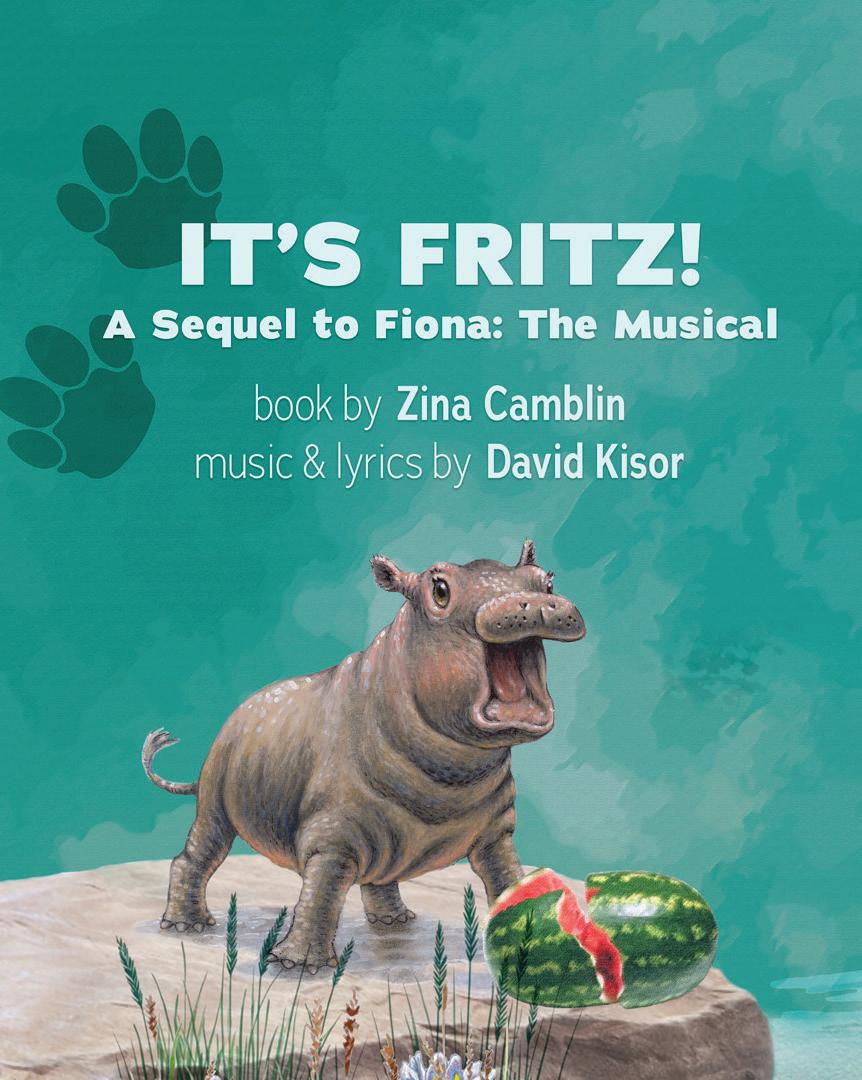















series examining the music of Johann Sebastian Bach. He has created programs for broadcast on WFMT and WQXR and has also served as guest curator for projects with the Philadelphia Chamber Music Society, Bravo! Vail Music Festival, San Francisco Opera Center and San Francisco Performances, where he served as the vocal artist-in-residence from 2014 to 2018. Phan’s programs often examine themes of identity, highlight unfairly underrepresented voices from history and strive to underline the relevance of music from all periods to the currents of the present day. nicholas-phan.com
Jonathan Lemalu, bass
Jonathan Lemalu is a New Zealand-born Samoan who holds a Bachelor of Laws degree from Otago University and an Artist Diploma from the Royal College of Music, where he won the Tagore Gold Medal. Lemalu has sung at the Royal Opera House–Glyndebourne, English National Opera, Bayerische Staatsoper, Theater an der Wien, Oper Frankfurt, Metropolitan Opera, Chicago Lyric and San Francisco Opera, as well as the Salzburg, Baden-Baden and Edinburgh festivals, with conductors including Sir Simon Rattle, Sir Antonio Pappano, Sir Colin Davis, Zubin Mehta, Valery Gergiev, Nikolaus Harnoncourt, Vladimir Jurowski, Sir Roger Norrington, Ivor Bolton, Charles Dutoit, Alexander Joel, Yannick Nézet-Séguin, Edward Gardner and Patrick Summers. Roles include Osmin in Il Seraglio, Rocco in Fidelio, Leporello in Don Giovanni, Sarastro in Die Zauberflöte, Nick Shadow in The Rake’s Progress, Hunding in Die Walküre, Bottom in A Midsummer Night’s Dream, Collatinus in The Rape of Lucretia, Colline in La bohème, Dulcamara in L’elisir d’amore, Queequeg in Moby Dick, Weit Pogner in Die Meistersinger von Nürnberg and Nourabad in Les pêcheurs de perles
Recent and upcoming operatic highlights include Rocco in Fidelio at Garsington; Mayor in Jenufa at the ROH; Bartolo in Le nozze di Figaro for Opera North; Doctor








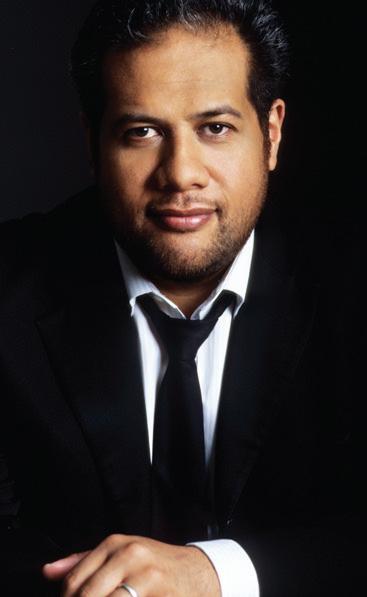





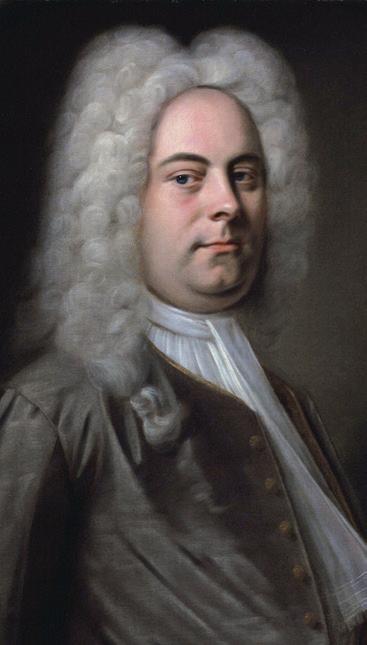
Born: February 23, 1685, Halle, Prussia (Germany) Died: April 14, 1759, London, England
NOTE: The composer was baptized under the name Georg Friederich Händel, but long before his death he adopted an English version of his name, George Frideric Handel.
in La traviata, as well as Sarastro and Speaker in The Magic Flute for ENO; Seneca in L’incoronazione di Poppea and Banco in Macbeth for Grange Festival Opera; Don Fernando in Fidelio for Glyndebourne; Tiresias in Oedipus Rex for Opera Philadelphia and Sagristano in Tosca for Liceu. Concert performances include Brander in La damnation de Faust with the Accademia Nazionale di Santa Cecilia in Rome with Dutoit conducting, City of Birmingham Symphony Orchestra under Kazuki Yamada and the London Philharmonic Orchestra led by Edward Gardner, and The Seasons with the Academy of Ancient Music and Handel’s Samson for the BBC Proms, both led by Laurence Cummings.
In 2022, Lamalu was made a Royal College of Music Honorary Fellow, a patron of New Zealand Opera and an Officer of the New Zealand Order of Merit in the Queen’s Jubilee Honours for services to opera. askonasholt.com/artist/jonathan-lemalu
The May Festival Chorus is endowed by the Betsy & Alex C. Young Chair
Matthew Swanson, Director of Choruses
Jason Alexander Holmes, Associate Director of Choruses & Youth Chorus Director
Heather MacPhail, Accompanist
Max Trombley, Conducting Fellow
Jennelle John-Lewis, Chorus Operations Manager
Kathleen Moran, Chorus Librarian
May Festival Chorus biographies and Chorus roster can be found on pp. 37–38.
George Frideric Handel: Messiah
Composed: August 22–September 14, 1741; libretto assembled by Charles Jennens from passages in the Bible
Premiere: April 13, 1742, in a matinée at the Great Music Hall in Fishamble Street, Dublin, Ireland; an open rehearsal had been held four days earlier
Instrumentation: SATB chorus and SATB soloists, 2 oboes, bassoon, 2 trumpets, timpani, harpsichord, portative organ, strings
CSO notable performances: First: December 1935, Eugene Goossens conducting; soloists Rose Bampton, Agnes Davis, Franz Trefger and Sherwood Kains; University of Cincinnati Oratorio Society Chorus. Most Recent: December 2009, Nicholas McGegan conducting; soloists Dominique Labelle, Marietta Simpson, Norman Shankle and Christòpheren Nomura; May Festival Chorus.
Duration: approx. 108 minutes
Handel’s oratorio Messiah dates from a pivotal moment in his career. He composed his first oratorios in 1707–08, during his early residence in Rome. Not until a decade later did he essay an oratorio in English — Esther (1718) — by which time he had settled in London and achieved distinction as an opera composer. Italian-language opera would be his principal concern for a period of 36 years, during which he rode both the waves of success and the troughs of indifference that marked the topsyturvy world of lyric theatre. By the late 1730s, however, he had his fill with the high-stress management of opera productions, and the opera he wrote for London’s 1740–41 season — Deidamia — would be his last.
Just then, he received an invitation to produce a series of concerts in Dublin in 1741, and the idea of a change of scenery appealed to him. He traveled from London to Dublin in mid-November 1741 and remained until August 13, 1742. The highpoint of his Dublin season was without a doubt the premiere of his new oratorio, Messiah. He had composed it while still in London during the late summer of 1741, over the course of about three weeks. That so great — and large — a masterpiece should have been created in so brief a span seems all but incredible to most of us, but Handel documented its progress by entering dates in his score as it unrolled.
His librettist, Charles Jennens, a well-to-do fellow-about-the-arts-world who was 15 years his junior, was pressed into service to assemble a text for the new
oratorio. This he apparently did in the early summer of 1741, drawing creatively on Biblical passages from the Books of Isaiah, Haggai, Malachi, Matthew, Luke, Zechariah, John, Psalms, Lamentations, Hebrews, Romans, I Corinthians and Revelation to create a loose story comprising historical narrative about the life of Jesus and reflections about him by Christian believers. He organized the texts into three discrete sections, the first relating to the prophecy of Christ’s coming and the circumstances of his birth, the second to the vicissitudes of his life on earth and the third to the events surrounding the resurrection and the promise of redemption. With the libretto in hand, Handel leapt into action on August 22. He finished the draft of Part One on August 28, of Part Two on September 6, and of Part Three on September 12 — and then he took another two days to polish details on the whole score, which numbered 53 movements in toto.
This prodigious pace was not exceptional for Handel, and it is no more than Romantic fantasy to view it (as once was routine) as a fever of divine inspiration peculiar to the composition of Messiah. In fact, he allowed himself about a week’s rest after finishing Messiah before embarking on his next oratorio, Samson, which he wrote in the relatively leisurely span of five weeks.
Handel’s Dublin season began auspiciously with performances of several earlier works — L’Allegro, il Penseroso ed il Moderato; Acis and Galatea; Esther; Alexander’s Feast — which paved the way for the excitement attending the unveiling of Messiah. These consisted of an open rehearsal on April 9, 1742, and two official performances, on April 13 and June 3 (the income from the last being earmarked for the composer). The first concert was given as a benefit, organized with the assistance of the Charitable Musical Society, “For Relief of the Prisoners in the several Gaols, and for the Support of Mercer’s Hospital in St. Stephen’s-street, and of the Charitable Infirmary on the Inns Quay” (as The Dublin Journal announced a couple of weeks in advance). After the open rehearsal, The Dublin News Letter pronounced that the new oratorio “in the opinion of the best judges, far surpasses anything of that Nature, which has been performed in this or any other Kingdom.” The Journal concurred that it “was allowed by the greatest Judges to be the finest Composition of Musick that ever was heard, and the sacred Words as properly adapted for the Occasion.” It continued with advice for persons lucky enough to hold tickets for the official premiere: “Many Ladies and Gentlemen who are well-wishers to the Noble and Grand Charity for which this Oratorio was composed, request it as a Favour, that the Ladies who honour this Performance with their Presence would be pleased to come without Hoops as it will greatly encrease the Charity, by making Room for more Company.” To which it added in a follow-up article: “The Gentlemen are desired to come without their Swords’, to increase audience accommodation yet further.”
Messiah was given often in Handel’s lifetime, and from 1742 to 1754 he provided alternate versions of some of its numbers, usually to accommodate the strengths of specific singers in revivals. This leaves modern conductors with choices about which versions of certain numbers to perform — and, indeed, which to cut, since the running-time of the “complete” Messiah can prove forbidding to audiences. Typically, Part One is offered in its entirety, with judicious cuts being made in Parts Two and Three, as in this performance.
—©James M. Keller
James M. Keller, for 25 years the program annotator of the San Francisco Symphony and the New York Philharmonic, is the author of Chamber Music: A Listener’s Guide (Oxford University Press).
Florence Price
SUN DEC 7, 2 PM, Music Hall COMMON LINES
ANTOINE T. CLARK, conductor
Concert Overture No. 2 (1887–1953)
Samuel Coleridge-Taylor Ballade (1875–1912)
Zhou Tian
Broken Ink (b. 1981)
Watching the Tidal Bore
Hearing the Sound of the Rain and the Bell
The Mighty River Runs Eastward
SUN DEC 7, 7 PM, Music Hall THE YEAR 1905
ALEX AMSEL, conductor
Dmitri Shostakovich
Symphony No. 11 in G Minor, Op. 103, The Year 1905 (1906–1975)
The Palace Square
The 9th of January In Memoriam The Tocsin
For program notes, please visit our digital program by texting PROGRAM to 513.845.3024.
Ellen and Richard Berghamer Foundation
The Charles H. Dater Foundation
The Unnewehr Foundation
Support provided by the Ellen and Richard Berghamer Foundation, The Charles H. Dater Foundation and The Unnewehr Foundation. The Cincinnati Symphony Youth Orchestras is a program of the Cincinnati Symphony Orchestra and receives generous support in the form of rehearsal space from the University of Cincinnati College-Conservatory of Music and Walnut Hills High School.
FIRST VIOLIN
Alexander Wang, Concertmaster
Grace Barnett
Elessar Dehoff
Bella Duhaime
Emma Leong
Julia Li
Eric Liu
Lukas Meinken
Ella Shadix
Sarang Srikanth
Stacy Villo
Mia Wang
Kevin Wen
Ethan Yao
Ethan Yuan
Angela Zhang
Jenna Zhang
SECOND VIOLIN
Andrew Zhang, Principal
Alice Chi
Kathryn Dillman
Soham Gudsoorkar
Joy Jang
Jiffannie Fredy
Daniel Kong
Nathan Lee
Brianna Luo
Rishi Pampati
Noah Stulberg
Sarah Wang
Luke Wright
Iris Xu
Clairette Yang
VIOLA
Lucia Schartung, Principal
Sungwoo Choi
Ryley From Andrew Jee
Henrik Reinsalu
Annabel Schulte
John Vasconcelos
Adele Williams
CELLO
Alexander Berger
Eliot Brown, Principal
Cynthia Li, Assistant Principal
Sieun Ghim
Marie Godarova
Zoe Lee
Jason Liew
Reign Matu
Gabriel Shin
Ethan Wang
James Yeoh
Emma Zhu
Alex Zhuang
DOUBLE BASS
Jonathan McGrath, Principal
Joel Bierkan
Jameson Hornsby
Miles Manning
Darcy McMahon
Christopher Southern
FLUTE/PICCOLO
Ethan Li
Yuxin Liu1
Penny Schackmann3
Samantha Wong2
OBOE/ENGLISH HORN
Sophia Cheng2
Gary Forsyth3
Sab Rajan
Isabella Vilanueva1
CLARINET
Lucian Chang1
Vincent Dicicco2
Ian Duff3
Evelyn Shin
BASSOON
Justus Chapman2,3
Scott Singleton1
HORN
Nathan Barkley1
Zoey Little
Maxwell Nelson2
Eden Proctor
Akio Wiese3
TRUMPET
Elijah Flores3
Benjamin Holloway1
Emma Ogden2
FIRST VIOLIN
Angela Tang, Concertmaster
Youngwoo Choi+
Anna Christos
Marley Feng
Yuhan Gu
Hyori Han
Andy Li
Annie Li
Madeline Mozlin
Sarah Perpignan
Clara Schmid
Ian Shang
Jubilee Shang
Eva Cate Wesley
Raina Yang
Elizabeth Yeoh
SECOND VIOLIN
Paul Ku, Principal
Andrew Cheng+
Carmen DeAtely-Rosales
Maren Heisler
Evie Hu
Eli Hu
Grace Kim,
Julia Lancman
Cecilia Lehmann
Elaine Peng
Santhosh Rajan
Ben Truong
Kenneth Wu
Irene Zhang
VIOLA
Grace Yu, Principal
Christy Kim, Co-Assistant Principal
Kasinda Willingham, Co-Assistant Principal
Samuel Butler+
Anna Cameron
Goehring, Ethan
Simon Park
Blake Roberts
Lainie Stautberg
Isabella Wang
Alina Zhang
CELLO
Sonya Moomaw, Principal
Autumn Rinaldi, Assistant Principal
Lillian Duhaime+
Adhi Nayak,
Kallea Willingham
William Yeoh
DOUBLE BASS
Matteo Meli, Co-Principal
Aaron Scott1, Co-Principal
Evan Butler
Alaz Erdem
Josiah Eriksen
Gerrit Johnson
TROMBONE
Tvasta Gajjar2
Mikayla November1
Colin Van Niman3
BASS TROMBONE
Jessica Ries
TUBA
Evan Moore
PERCUSSION
Murray Cummings
Chloe Dick
Adolphus McCullom II
HARP
Magdalena Milroy
+Begins the alphabetical listing of players who participate in a system of rotated seating within a string section.
All wind players are considered principals and rotate between pieces.
Wind Principals
1 Price
2 Coleridge-Taylor
3 Tian
FLUTE/PICCOLO
Mona Allen
Camille Kolar
Allison Sayles1
Riya Tummala
OBOE/ENGLISH HORN
Lydia Banzhof
August Hagen
Eden Potterton1
Gwendolyn Stapp
CLARINET
Edward Riddle
Jackson Runtenelli
Liheng Wang1
Mario Ynga Orellana
BASSOON
Sean Hayes
Josie Youtsler1
HORN
Josh Baxter
Lucas Elmore
Eva Fuller
Cate Mahoney
Lucas Monjot1
TRUMPET
Ryan Metsker
Trent Stricker
Thomas Stricker1
Benjamin Yoby
TROMBONE
Jack Izor1
Connor Perkins
BASS TROMBONE
Douglas Jacobo
TUBA
George Kaiser
PERCUSSION
Braeden Brown
Benjamin Hofmann
+Begins the alphabetical listing of players who participate in a system of rotated seating within a string section.
All wind players are considered principals and rotate between pieces.
1 Principal Players for Shostakovich
The CSYO CCM Conducting Fellow for 2025–26 is Mouye Zhoue.

PNC is proud to be the Pops Season Presenter and to support the Cincinnati Symphony Orchestra and Cincinnati Pops. Thank you for mastering the art of making Greater Cincinnati a more brilliantly beautiful place.
HOLIDAY POPS | 2025–26 SEASON
FRI DEC 12, 11 AM & 7:30 PM | SAT DEC 13, 2 PM & 7:30 PM
SUN DEC 14, 2 PM & 7 PM Music Hall
JOHN MORRIS RUSSELL conductor* CODY FRY vocalist
CINCINNATI STUDIO FOR DANCE
MAY FESTIVAL YOUTH CHORUS
SYCAMORE HIGH SCHOOL SELECT ENSEMBLE
SCHOOL FOR CREATIVE AND PERFORMING ARTS CHORALE and MERIDIAN 8 WINTON WOODS HIGH SCHOOL VARSITY ENSEMBLE
O Tannenbaum Traditional
There’s No Place Like Home for the Holidays
Robert Allen/Al Stillman
It’s Beginning to Look a Lot Like Christmas/This Christmas Meredith Willson/Donny Hathaway/ Nadine McKinnor
I’ll Be Home for Christmas Buck Ram/Kim Gannon
Christmas Waltz/Waltz of the Flowers
Sammy Cahn/Jule Styne/Piotr Ilyich Tchaikovsky
Festive Sounds of Hanukkah (“A Candle is a Small Thing”) Traditional
Little Bolero Boy
Maurice Ravel/Katherine Kennicott Davis
Siyahamba Traditional
Jingle Bell Rock Joe Beal
Angels We Have Heard on High Traditional
Sugar Plum/Favorite Christmas Movies Piotr Ilyich Tchaikovsky
The Christmas Song
Mel Tormé/Robert Wells
Christmas Concerto (“‘Twas the Night Before Christmas”) Arcangelo Corelli
Jolly Old St. Nicholas/Santa Claus is Coming to Town John Frederick Coots/Haven Gillespie
A Suite of Carols Traditional
What a Wonderful World
Bob Thiele/George David Weiss
We Wish You a Merry Christmas Traditional
* A biography for John Morris Russell is on p. 23.
Program subject to change
The Cincinnati Pops Orchestra is grateful to Pops Season Presenter PNC, Concert Sponsor Graeter’s Ice Cream and Associate Sponsor AARP Ohio
The Cincinnati Symphony Orchestra is grateful for the support of the Louise Dieterle Nippert
Musical Arts Fund of the Greenacres Foundation, the Nina Browne Parker Trust, and the thousands of people who give generously to the ArtsWave Community Campaign, the region’s primary source for arts funding. This project was supported in part by the Ohio Arts Council, which receives support from the State of Ohio and the National Endowment for the Arts.
The CSO in-orchestra Steinway piano is made possible in part by the Jacob G. Schmidlapp Trust
THE STUDIO FOR DANCE
Shari Po , director; Della
Lehane, choreographer
Jossi Baum
Charlotte Becker
Cate Bingcang
Lily Bingcang
Lucy Brockman
Sophia Brockman
Maria Colas
Lola Darbyshire
Doris Du
Declan Dyer
Mia Goodlett
Chana Horewitz
Anna Kalb
Nika Kartashov
Evan Knight
Krystyna Laux
Fiona Lehane
Winifred Lehane
Sienna Parnes
Maddie Perdue
Caroline Reinke
Lucy Salters
Maddalena Serrangeli
Anna Wonderling
Ellie Wonderling
MAY FESTIVAL YOUTH CHORUS*
Jason Alexander Holmes, Director
Ja’Vierre Adams
Carter J Allen
Ava Altenau
Seth Barry
Hope Bowden
Lenora Braukman
Anna Burkhart
Poplar Cagnon
Cameron Carnahan
Romeo Ciolino
Sophia Clever
Thanh-Tam Dao
Lucy Dixon
Alijah Frost
Katherine Gieson
Mary Hollon
Zipporah Horn
Genevieve Howard
Naomi Jackson
Preston Koeninger
Claire Kruckeberg
Arpad Lallement
Talula Lane
Emily Lewis
Elyse Longbottom
Ella Martin
Claire Miller
Runako Muvirimi
Arianna Pence
*The May Festival Youth Chorus receives generous support from the Bea Aldrink Idema Foundation.
To view the Digital Program for exclusive content, please text PROGRAM to 513.845.3024*, use your mobile device to scan the QR code or visit cincinnatisymphony.org/digitalprogram.
*By texting to this number, you may receive messages that pertain to the organization and its performances; msg & data rates may apply. Reply HELP to help, STOP to cancel.
Pearl Ramstetter
Nathan Share
Jenavieve Southcombe
Genevieve Stevenson
Oliver Wagner
Eden Walker
Daniel Winhusen
SCPA CHORALE
Sterling Finkbine, Director of Choirs
Amani Akins
Paige Arterburn
Tysean Brown
Naomi Childress
Tamiah Day
Riley Dills
Mariam Elwafi
Aspen Fecher
Parker Flautt
Palmer Goodman
Sydney Hall
Clark Hamlet
Ashley Hammond
Mabel Hodson
Evelyn Huey
Isabella Kreft
Skylar Jones
Cora Koltak
Ethan Leonard
Joel Leptak-Moreau
Maiyara Long
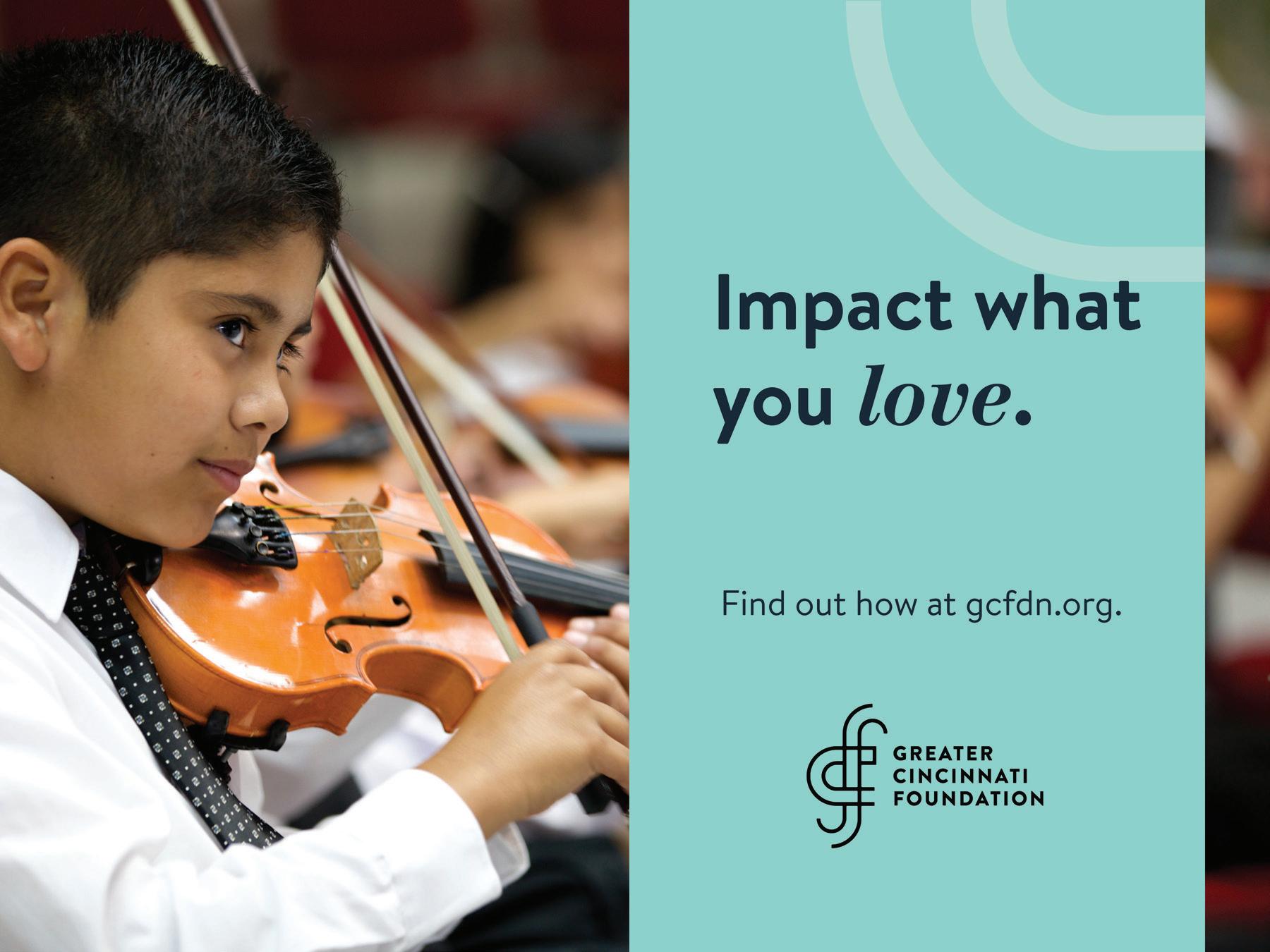
Kelly Lonneman
Morgan Lumpkins
Grace Manning
Sam Nguyen
Madison Perkins
Rhema Postell
Christian Rauen
Ezra Reidel
Luna Roberts
Heather Sherwood
Jenny Smith
Jenavieve Southcombe
Olive Stewart
Margaret Todd
Fallon Towns
Lydia Trout
Abby Turner
Athena Updike
Eden Walker
Gemariah Washington
Espen Wells-Jordan
SCPA MERIDIAN 8
Naomi Childress
Parker Flautt
Christian Rauen
Ezra Reidel
Jenny Smith
Maggie Todd
Athena Updike
Espen Wells-Jordan


SYCAMORE
HIGH SCHOOL
SELECT ENSEMBLE
Ken Holdt, Director of
Choral Activities
Carter Allen
Jaedyn Amos
Leland Anderson
Johanna Blackmore
Samuel Broxterman
Lexi Coman
Baden Danner
Hannah Donnellan
Katelyn Dunphy
Yasmeen Faruqui
Emma Garcia
Evan Gonzalez
Isabela Green
Grace Howard
Isabelle Jackson
Andy Lee
Rohan Mathew
Sharon Mathew
Shanaya Pal
Emily Phillips
Jai’Den Pritchett
Chloe Robinson

Khadijah Rodriguez
Alex Ru
Maevry Sams
Jack Smith
Sithara Venkatraman
Oliver Wagner
Hadley Wick
WINTON WOODS HIGH SCHOOL
VARSITY ENSEMBLE
Beth Caikowski, Director of Choirs
Payton Beacher
Asa Bouldin
Jaxon Braswell
Lyric Bridges
Ronin Buhl
Trinity Chapman-Davis
Zariah Clark
Damyah Coats
Mahesh Dhimal
Michael Doughman
Nyla Freeman
Edward Gray
Naima Groves
Relle Johnson
Lael Jones
Sacarii Kemper
Jason Kouomo
Joseph Kuhl
Tariyah Loggins
Jenique McDay
Jayden McKinney
Paiyton Miller
Je Njokou Dimou
Shontaz Phim
Sovit Regmi
Christopher Reid
Kai Richards
Cambria Robison
Shaniya Ruth
Raydale Smith
Everson Stallworth
Selena Stevison
Ella Sullivan
Madeline Tarber
Kel Thompson
Isabella Vargas
Chris Velasco
Arabella Vires
Camryn Wilkinson
Ariane Williams
Ariel Williams




































































































Local and national foundations, businesses, and government agencies are integral to the Orchestra’s vibrant performances, community engagement work, and education activities. We are proud to partner with the following funders.
PLATINUM BATON CIRCLE ($50,000+)
Anonymous ArtsWave
Ellen and Richard Berghamer Foundation
Charles H. Dater Foundation
The Fifth Third Foundation
Local Initiative for Excellence Foundation
H.B., E.W. & F.R. Luther Charitable Foundation
Mellon Foundation
Dr. John & Louise Mulford Fund for the CSO National Endowment for the Arts
Louise Dieterle Nippert Musical Arts Fund of the Greenacres Foundation
Ohio Arts Council
PNC Bank
Margaret McWilliams Rentschler Fund of Greater Cincinnati Foundation
Nina Browne Parker Trust
Robert H. Reakirt Foundation Equities

CONDUCTOR’S CIRCLE ($10,000–$14,999)
Bartlett Wealth Management
Chemed Corporation
CVG Airport Authority
Crosset Family Fund
Kelly Dehan and Rick Staudigel
Graeter’s Ice Cream
Messer Construction Co.
The Daniel & Susan Pfau Foundation
Taft Stettinius & Hollister LLP
YOT Full Circle Foundation
CONCERTMASTER’S CIRCLE ($5,000–$9,999)
Interact for Health
JRH Consultants
The Andrew Jergens Foundation
Keating Muething & Klekamp PLL
Richard and Carmen Kovarsky
Queen City (OH) Chapter of The Links, Incorporated
The Willard & Jean Mulford Charitable Fund
SORTA/Metro
Thompson Hine LLP
Harold C. Schott Foundation / Francie and Tom Hiltz, Trustees
The Unnewehr Foundation
Western & Southern Financial Group
GOLD BATON CIRCLE ($25,000–$49,999)
The Cincinnati Symphony Club
HORAN Wealth
Louis H. and David S. Ingalls Foundation Inc.
George and Margaret McLane Foundation
The Ladislas & Vilma Segoe Family Foundation
United Dairy Farmers & Homemade Brand Ice Cream
SILVER BATON CIRCLE ($15,000–$24,999)
BlaCkOWned™
BT Rise
Johnson Investment Counsel
Peter E. Landgren and Judith Schonbach Landgren Millstone Fund
The Procter & Gamble Company
The Rendigs Foundation
Scott and Charla Weiss
Wodecroft Foundation
WOW Windowboxes
ARTIST’S CIRCLE ($2,500–$4,999)
Closing the Health Gap
Duke Energy Foundation
d.e. Foxx and Associates, Inc.
Hispanic Chamber Cincinnati USA
HUB International
Learning Links Fund of Greater Cincinnati Foundation
NAMI Urban Greater Cincinnati
Charles Scott Riley III Foundation
Southern Grace Eats
Visit Cincy
BUSINESS & FOUNDATION PARTNERS (up to $2,499)
AARP Ohio
African American Chamber of Commerce
Albert B. Cord Charitable Foundation
American Red Cross, Greater Cincinnati-Dayton Region
The Blue Book of Cincinnati
William G. and Mary Jane Helms Charitable Foundation
Hixson Architecture Engineering Interiors
Journey Steel
Robert A. & Marian K. Kennedy Charitable Trust
The Kroger Co.
League of American Orchestras
Frances L. P. Ricketts Sullivan Memorial Fund
The Voice of Your Customer
Join this distinguished group! Contact Sean Baker at 513.744.3363 or sbaker@cincinnatisymphony.org to learn how you can become a supporter of the CSO and Pops. This list is updated quarterly.
The Cincinnati Symphony Orchestra and Cincinnati Pops acknowledge the following partner companies, foundations and their employees who generously participate in the Annual ArtsWave Community Campaign at the $100,000+ level. Thank you!
$2 million+ P&G
$1 million to $1,999,999
Fifth Third Bank and Fifth Third Foundation
$500,000 to $999,999
GE Aerospace
$250,000 to 499,999
The Cincinnati Insurance Companies
The H.B., E.W. and F.R. Luther Charitable Foundation, Fifth Third Bank, N.A., Trustee
Western & Southern Financial Group

$100,000–$249,999
altafiber
Cincinnati Children’s Hospital Medical Center
Cincinnati Reds
Dinsmore & Shohl LLP
The E.W. Scripps Company and Scripps Howard Foundation
The Enquirer | Cincinnati.com
Great American Insurance Group
Greater Cincinnati Foundation
The Kroger Co.
Messer Construction Co.
PNC
The Cincinnati Symphony Orchestra and Cincinnati Pops are grateful to the following individuals that support our efforts by making a gift to the Orchestra Fund. We extend our heartfelt thanks to each and every one and pay tribute to them here. You can join our family of donors online at cincinnatisymphony.org/donate or by contacting the Philanthropy Department at 513.744.3271.
Gifts of $50,000 and above
Mr. and Mrs. Frederick E. Bryan, III §
Sheila and Christopher C. Cole §
David C. Herriman Fund of Greater Cincinnati Foundation
Robert W. Dorsey §
Kathy Grote in loving memory of Robert Howes §
Healey Liddle Family Foundation, Mel & Bruce Healey
Harold C. Schott Foundation, Francie & Tom Hiltz
Dr. and Mrs. Stephen Joffe
Florence Koetters
Jo Anne and Joe Orndorff
Vicky and Rick Reynolds
Irwin and Melinda Simon §
Dee Stegman §
Jackie and Roy Sweeney Family Fund*
Mr. and Mrs. Jonathan Ullman
Mr. Randolph L. Wadsworth Jr. §
Ginger Warner Scott and Charla Weiss §
GOLD BATON CIRCLE
Gifts of $25,000–$49,999
Joe and Patricia Baker
Dr. and Mrs. John and Suzanne Bossert §
Robert and Debra Chavez
Stephen J Daush
Mr. and Mrs. Tom Evans
Dr. and Mrs. Carl G. Fischer
Ashley and Bobbie Ford §
Dr. Lesley Gilbertson and Dr. William Hurford §
Marvin P. Kolodzik and Linda S. Gallaher §
Calvin and Patricia Linnemann
Carolyn Baker Miller
Dianne and J. David Rosenberg
Moe and Jack Rouse §
Ann and Harry Santen §
Carol B. Striker
Sarah Thorburn
SILVER BATON CIRCLE
Gifts of $15,000–$24,999
Mr. and Mrs. Larry Brueshaber
Mr. Gregory D. Buckley and Ms. Susan Berry-Buckley
The Garber Family
Tom and Jan Hardy §
Patti and Fred Heldman
Mr. and Mrs. Joseph W. Hirschhorn §
Mrs. Andrea Kaplan
Mrs. Erich Kunzel
Will and Lee Lindner
Mark and Tia Luegering
Mr. and Mrs. Timothy Maloney
Susan McPartlin & Michael Galbraith
Joseph A. and Susan E. Pichler Fund*
Mark S. and Rosemary K. Schlachter §
Jacqueline Sifri
In memory of Mary and Joseph S. Stern, Jr
DeeDee and Gary West §
Mr. and Mrs. James M. Zimmerman § Anonymous (2)
Gifts of $10,000–$14,999
Access Audio, Inc.
Mr. and Mrs. Andrew Akers
Jan and Roger Ames
Michael L. Cioffi & Rachael Rowe §
Mrs. Thomas E. Davidson §
Dianne Dunkelman and Clever Crazes for Kids
Emory P. Zimmer Insurance Agency
Dr. G. Russell and Renee S. Frankel
Lynne Friedlander and Jay Crawford
John B. and Judith O. Hansen
Ms. Barbara Johnson
Robert Johnson
John and Molly Kerman
Michael and Marilyn Kremzar §
John and Ramsey Lanni
Phillip Long
Alan Margulies and Gale Snoddy
In memory of Bettie Rehfeld
Linda and James Miller
James and Margo Minutolo
Martha and Lee Schimberg
Mike and Digi Schueler
Mr. Lawrence Schumacher
Ralph C. Taylor §
Nancy C. Wagner and Patricia M. Wagner §
Anonymous (3)
Gifts of $5,000–$9,999
Heather Apple and Mary Kay Koehler
Thomas P. Atkins
Mrs. Thomas B. Avril
Kathleen and Michael Ball
Robert and Janet Banks
Michael P. Bergan and Tiffany Hanisch
Louis D. Bilionis and Ann Hubbard
Robert L. and Debbie Bogenschutz
Thomas A. Braun, III §
The Otto M. Budig Family Foundation
Ms. Melanie M. Chavez
Sally and Rick Coomes
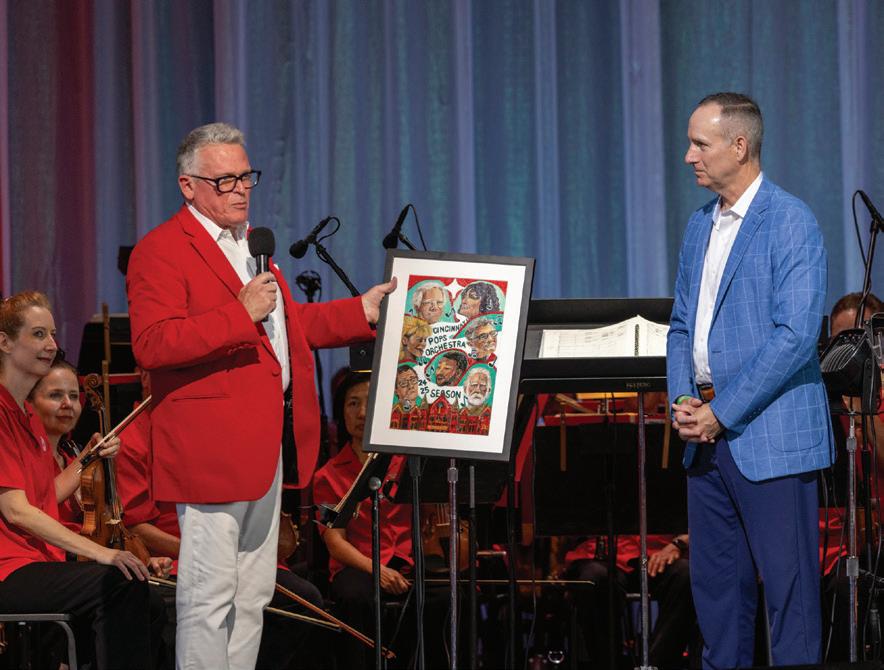
George Deepe and Kris Orsborn
Bedouin and Randall Dennison
Dennis W. and Cathy Dern
Mrs. Diana T. Dwight
In Loving Memory of Diane Harrison Zent
David and Kari Ellis Fund*
Dr. and Mrs. Alberto Espay
Estate of E.J. and Jean Krabacher
Mr. and Mrs. James T. Fitzgerald
Dr. and Mrs. Harry F. Fry
L. Timothy Giglio
Jim and Jann Greenberg
Mr. and Mrs. Lawrence Hamby
Ms. Delores Hargrove-Young
William and Jo Ann Harvey
Dr. James and Mrs. Susan Herman
John M. and Lynda Hoffman Jeep for their 50th Anniversary
Barbara M. Johnson
Mr. and Mrs. Geoffrey Keenan
Mrs. Barbara Kellar in honor of Mr. Lorrence T. Kellar
Holly King
Frank and Ann Kromer
The Lewis and Marjorie Daniel Foundation
Mrs. Robert Lippert
Elizabeth and Brian Mannion
Mr. and Mrs. Donald Marshall
David L. Martin §
Mandare Foundation
Barbara and Kim McCracken §
Robert and Heather McGrath
Ms. Mary Lou Motl §
The Patel-Curran Family
Poul D. and JoAnne Pedersen §
David and Jenny Powell
Drs. Marcia Kaplan and Michael Privitera
Elizabeth and Karl Ronn §
Dr. E. Don Nelson and Ms. Julia Sawyer-Nelson
Dr. and Mrs. Michael Scheffler
Sandra and David Seiwert
Brent & Valerie Sheppard
Rennie and David Siebenhar
Michael and Donnalyn Smith
Brett Stover §
Christopher and Nancy Virgulak
M Elizabeth Warner
Donna A. Welsch §
Mr. Donald White
Ms. Diana Willen §
Cathy S. Willis
Wright Brothers, Inc.
Anonymous (2)
ARTIST’S CIRCLE
Gifts of $3,000–$4,999
Dr. Charles Abbottsmith
Mr. and Mrs. Gérard Baillely
Pamela & Jeffrey Bernstein
Ms. Marianna Bettman
Glenn and Donna Boutilier
Peter and Kate Brown
Dr. Ralph P. Brown
Chris and Tom Buchert
Daniel A. Burr
Janet and Bruce Byrnes
Andrea D. Costa, Esq. §
Peter G. Courlas §
Marjorie Craft
Jim and Elizabeth Dodd
Dr. and Mrs. Stewart B. Dunsker
Ann A. Ellison
Hardy and Barbara Eshbaugh
Mrs. Amy Forte
Yan Fridman
Linda P. Fulton §
Frank and Tara Gardner
Dr. and Mrs. Ralph A. Giannella
Lesha and Samuel Greengus
John and Elizabeth Grover
Esther B. Grubbs §
Mr. and Mrs. Byron Gustin
Dr. and Mrs. Jack Hahn
Mr. and Mrs. Robert R. Heidenreich
Mr. Fred Heyse
Ruth C. Holthaus
In Memory of Benjamin C. Hubbard §
Mr. and Mrs. Bradley G. Hughes
Mr. and Mrs. Michael C. Hughes
Karolyn Johnsen
Ms. Sylvia Johnson
Dr. Richard and Lisa Kagan
Dr. Robert W. Keith and Ms. Kathleen Thornton
Don and Kathy King
Lynn Keniston Klahm
Marie and Sam Kocoshis
Carol Louise Kruse
Mr. Shannon Lawson
Richard and Nancy Layding
Merlanne Louney
Luke and Nita Lovell
Mr. Jonathan Martin
Glen and Lynn Mayfield
The Allen-McCarren Trust
Ms. Sue Miller
Mr. and Mrs. David E. Moccia §
George and Sarah Morrison III
Phyllis Myers and Danny Gray
Alice Perlman
Mark and Kim Pomeroy
Rev. Dr. David V. Schwab
Michael and Katherine Rademacher
Dr. and Mrs. Robert Reed
James Rubenstein and Bernadette Unger
Carol J. Schroeder §
Mr. Rick Sherrer and Dr. Lisa D. Kelly
Sue and Glenn Showers §
Elizabeth C. B. Sittenfeld §
William A. and Jane Smith
Elizabeth A. Stone
Peggy and Steven Story
Mr. and Mrs. J. Dwight Thompson
Mr. and Mrs. Ronald Tinklenberg
Dr. Barbara R. Voelkel
Dr. and Mrs. Matthew and Diana Wallace
Mrs. Paul H. Ward §
Dr. and Mrs. Galen R. Warren
Jonathan and Janet Weaver
Jim and George Ann Wesner
Jo Ann Wieghaus
Steve and Katie Wolnitzek
Irene A. Zigoris
Anonymous (4)
SYMPHONY CIRCLE
Gifts of $1,500–$2,999
Jeff and Keiko Alexander §
Lisa Allgood
Mr. Nicholas Apanius
Judy Aronoff and Marshall Ruchman
Ms. Laura E. Atkinson
Dr. Diane S. Babcock §
Mr. and Mrs. Carroll R. Baker
David and Elaine Billmire §
Neil Bortz
Dr. Leanne Budde
Gay Bullock
Ms. Deborah Campbell §
Tom Carpenter and Lynne Lancaster
Stephen and Karen Carr
Dr. Alan Chambers
James Civille
Carol C. Cole
§
Mr. and Mrs. Philip K. Cone
Randy K. and Nancy R. Cooper
Charles and Kimberly Curran §
Mark Dauner and Geraldine Wu
Robert B. Dick, Ph.D.
Tom and Leslie Ducey
David and Linda Dugan
Mr. and Mrs. John G. Earls §
Barry and Judy Evans §
Dr. and Mrs. William J. Faulkner
Ms. Barbara A. Feldmann
Mr. Robert Ferrell
Philip Ficks
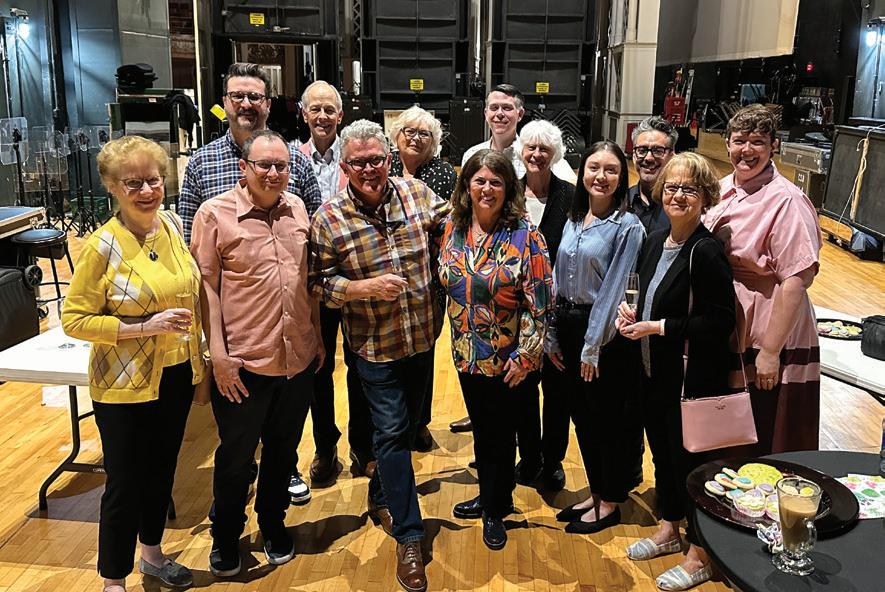
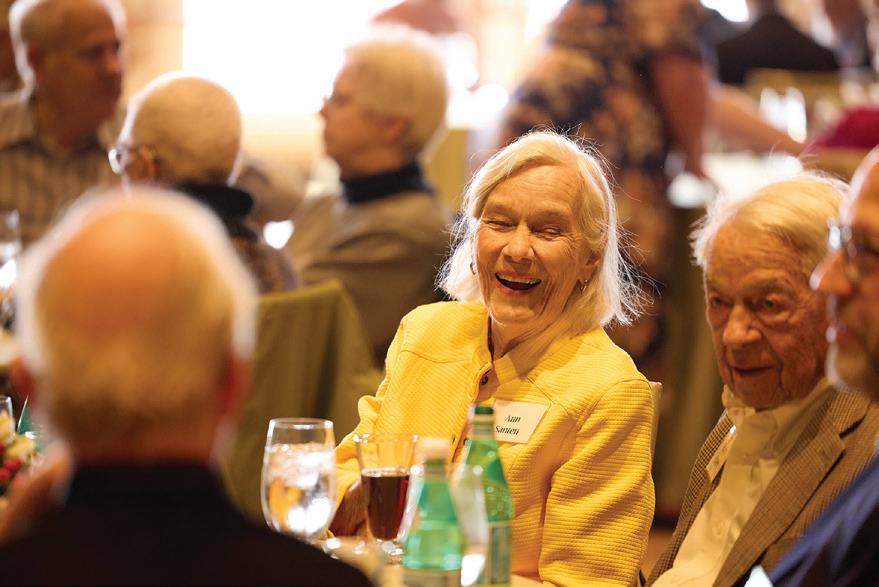
Anne and Alan Fleischer
Mrs. Charles Fleischmann
Carol S. Friel
Dudley Fulton
Anne E. Mulder and Rebecca M. Gibbs
Louis and Deborah Ginocchio
Donn Goebel and Cathy McLeod
Dr. and Mrs. Glenn S. Gollobin
Bill and Christy Griesser
Mary and Phil Hagner
Catherine K. Hart
Mrs. Jackie Havenstein
Mrs. Betty H. Heldman §
Mrs. Carol H. Huether
Mr. and Mrs. Paul Isaacs §
Heidi Jark and Steve Kenat
Andrew MacAoidh & Linda Busken Jergens §
The Marvin Jester Family
Christopher and Felecia Kanney
Holly H. Keeler
Mr. and Mrs. Woodrow Keown, Jr.
Bill and Penny Kincaid
Jack & Sharon Knapp
In Memory of Jeff Knoop
Mr. and Mrs. Richard Kovarsky
Pat and Randy Krumm §
Everett and Barbara Landen
Evelyn and Fred Lang
Charles and Jean Lauterbach
Mary Mc and Kevin Lawson
Mrs. Jean E. Lemon §
Dr. Carol P. Leslie
Andi Levenson Young and Scott Young
Mr. Peter F. Levin §
Mr. and Mrs. Lance A. Lewis
Mr. and Mrs. Clement H. Luken, Jr.
Mr. Gerron McKnight
John and Roberta Michelman
Nan L. Oscherwitz
Dr. Aik Khai Pung
In Memory of Daniel H. Reigle
Stephen and Betty Robinson
Laurie and Dan Roche
Ross Charitable Trust
Marianne Rowe
Mr. & Mrs. Peter A. Schmid
Stanley and Jane Shulman
Ms. Martha Slager
Susan and David Smith
Mark M. Smith (In memory of Terri C. Smith)
Stephanie A. Smith
Stephen and Lyle Smith
Albert and Liza Smitherman
Marian P. Stapleton
Bill and Lee Steenken §
Mrs. Donald C. Stouffer
Mr. and Mrs. Richard Stradling, Jr.
Mr. Mark Stroud
Rich and Nancy Tereba
Susan and John Tew
In Memory of Mr. William T. Bahlman, Jr.
Michael L. Walton, Esq
Ted and Mary Ann Weiss
Rev. Anne Warrington Wilson
Judy Wilson
Carol and Don Wuebbling
Anonymous (5)
Gifts of $500–$1,499
Christine O. Adams
Dr. Mary Albers
Mr. Thomas Alloy & Dr. Evaline Alessandrini
Patricia A. Anderson
Paul and Dolores Anderson §
Dr. Victor and Dolores Angel
Nancy J. Apfel
Lynne & Keith Apple, Honoring our Family
James Babb
Mrs. Gail Bain
Jerry and Martha Bain
Jack and Diane Baldwin
Scott Balmos
Glenda Bates
Drs. Carol and Leslie Benet
Fred Berger
Barbara and Milton Berner
Dr. David and Cheryl Bernstein
Glenda and Malcolm Bernstein
Milt and Berdie Blersch
Randal and Peter Bloch
Margaret Blomer
Dr. and Mrs. Jeffrey Bloomer
Michael and Pamela Boehm
Ron and Betty Bollinger
Clay and Emily Bond
Dr. and Mrs. Kevin Bove
David & Madonna Bowman
William & Mary Bramlage
Briggs Creative Services, LLC
Joan Broersma
Kathryn L. Brokaw
Harold and Gwen Brown
Jacklyn and Gary Bryson
Bob and Angela Buechner
Angie & Gary Butterbaugh
Jack and Marti Butz
Drs. Alan B. Cady and Anne K. Nestor
Joseph P. Cardone
Mr. and Mrs. Thomas Carothers
Mike and Shirley Chaney
Gordon Christenson
Dee and Frank Cianciolo Fund*
Mr. and Mrs. John Clapp
Bob and Tisha Clary
James Clasper and Cheryl Albrecht
Fred W. Colucci
Marilyn Cones
Janet Conway
Robin Cotton and Cindi Fitton
Martha Crafts
Tim and Katie Crowley
Susan and John Cummings
Jacqueline Cutshall
Loren and Polly DeFilippo
Stephen and Cynthia DeHoff
Nancy and Steve Donovan
Douglas & Kathy Dougherty
Meredith and Chuck Downton
Judy Doyle in Memory of James Johnson
Tom and Dale Due
Mrs. Shirley Duff
Mr. Corwin R. Dunn
Edgar J. and Elaine J. Mack Fund
Dale & Kathy Elifrits
Sally Eversole
Mr. Douglas Fagaly
Ms. Kate Farinacci
Mrs. Michelle Finch
Ilya Finkelshteyn and Evin Blomberg
Dr. and Mrs. Thomas Fischer
William and Carol Fisher
Mr. and Mrs. James Foreman
Janice and Dr. Tom Forte
Mr. and Ms. Bernard Foster
Dr. Charles E. Frank and Ms. Jan Goldstein
Harriet and Bill Freedman
Mr. and Mrs. John Freeman
Mr. Gregrick A. Frey
Mr. and Mrs. Joseph Fricke
Mr. and Mrs. James Fryman
Marjorie Fryxell
Mark S. Gay
Drs. Michael and Janelle J. Gelfand
Kathleen Gibboney
Mr. and Mrs. Donald R. Gilb
Dr. Jerome Glinka and Ms. Kathleen Blieszner
Dr. and Mrs. Charles J. Glueck
Dan Goetz
Mr. and Mrs. Jim Goldschmidt
Ms. Arlene Golembiewski
Anita J. and Thomas G. Grau
Robert and Cynthia Gray
Carl and Joyce Greber
Mary Grooms
Nina Gross
Janet C. Haartz and Kenneth V. Smith
Ham and Ellie Hamilton
Walter and Karen Hand
Roberta Handwerger, in memory of Dr. Stuart Handwerger
Mr. and Mrs. William Hardie
James and Sally Harper
Dr. Donald and Laura Harrison
Mariana Belvedere and Samer Hasan
Dr. Deborah Hauger
Mr. John A. Headley
Amy and Dennis Healy
Janet Heiden
Angie Heiman
Howard D. and Mary W. Helms
Donald and Susan Henson
Mr. Jeff Herbert
Herman & Margaret Wasserman Music Fund*
Michelle and Don Hershey
Janet & Craig Higgins
Mr. and Mrs. William A. Hillebrand
Susan and Jon Hoffheimer
Tim and Connie Holmen
Richard and Marcia Holmes
Ben Houck
Ms. Sandra L. Houck
Deanna and Henry Huber
Melissa Huber
Karen and David Huelsman
Dr. Edward & Sarah Hughes
Nada Christine Huron
Judith Imhoff
Ms. Idit Isaacsohn
Dr. Maralyn M. Itzkowitz
Mrs. Charles H. Jackson, Jr.
Ruth and Frederick Joffe
Ms. Anna R. Johnson
Mrs. Marilyn P. Johnston
Mr. Andrew Jones
Elizabeth A. Jones
Scott and Patricia Joseph
Jay and Shirley Joyce §
Mr. and Mrs. Robert Judd §
Rabbi Kenneth Kanter and Dr. Toni Kanter
Marilyn and Joseph Katz
Dr. James Kaya and Debra Grauel
Dr. and Mrs. Richard Kerstine
Rachel Kirley and Joseph Jaquette §
Mr. and Mrs. Dave Kitzmiller
Paul and Carita Kollman
Carol and Scott Kosarko §
Mr. and Mrs. Robert H. Kraimer
Kathleen B. and Michael C. Krug Fund*
Mark & Elisabeth Kuhlman
Mrs. John H. Kuhn §
Pinky Laffoon
Patricia Lambeck §
Asher and Kelsey Lanier
Ms. Sally L. Larson
Mrs. Julie Laskey
Joe Law and Phil Wise
Ms. Presley Lindemann
Mitchel and Carol Livingston
Mrs. Marianne Locke
JP and Footie Lund
David and Katja Lundgren
Larry and Mary Geren Lutz
Edmund D. Lyon
Mrs. Mary Reed Lyon
Marshall and Nancy Macks
Jenea Malarik
Barry and Ann Malinowski
Ms. Cheryl Manning
Ms. Wendy Marshall
Mr. and Mrs. Dean Matz
Ms. Elizabeth McCracken
Dr. Janet P. McDaniel
Tim and Trish McDonald
Mark McKillip and Amira Beer
Stephanie & Arthur McMahon
Stephanie McNeill
Charles and JoAnn Mead
Ms. Nancy Menne
Michael V. Middleton
Mr. Bradley Miller
Terence G. Milligan
Sonia R. Milrod
Leslie and Michael Minutolo
Mr. Steven Monder
Mr. and Mrs. Fred Moore
Regeana and Al Morgan
Janet Mott
Mr. Scott Muhlhauser
Kevin and Lane Muth
Alan Flaherty and Patti Myers § Hochwalt Naumann Fund
Mr. and Mrs. Christopher Newcomer
Amy Paul and Jerry Newfarmer
Cheryl and Roy Newman
Ms. Jane Nocito
Jane Oberschmidt §
Gary Oppito
Mr. Gerardo Orta
Ms. Sylvia Osterday
Anthony Paggett
John A. Pape
Rozelia Park and Christopher Dendy
Leslie D. Payne
Ms. Catherine J. Pearce
Carol and Jim Pearce
Barbara Persons
Mr. and Mrs. Paul Piazza
Ann and Marty Pinales
Jerry Rape
James W. Rauth §
Mrs. Genie Redman
Allan Reeves
Kenneth and Danielle Revelson
Becky and Ted Richards
Stephanie Richardson
Drs. Christopher and Blanca Riemann
Mr. David Robertson
Mr. Brian Robson
Dr. Anna Roetker
Ms. Jeanne C. Rolfes
Catherine Calko
Dr. and Mrs. Gary Roselle
Amy and John Rosenberg
Mr. and Mrs. G. Roger Ross
Dr. Deborah K. Rufner
Mr. Tom Samuels
Dr. Richard S. Sarason and Ms. Anne S. Arenstein
Cindy Scheets
Ms. Carol Schleker
Mr. and Mrs. Patrick Schleker
Dr. and Mrs. Michael Schmerler
Alice and Charles Schneider
George Palmer Schober
Tim and Jeannie Schoonover
Glenda C. Schorr Fund*
Janet R. Schultz
Dr. Joseph Segal and Ms. Debbie Friedman
Elaine Semancik
Mick and Nancy Shaughnessy
The Shepherd Chemical Company
Alfred and Carol Shikany
Mr. and Mrs. A. C. Shoop, Jr.
Jacqueline M. Mack and Dr. Edward B. Silberstein
Ms. Joycee Simendinger
Doug and Laura Skidmore
Nancy McGaughey and Sally Skillman
In Honor of Kenneth Skirtz
Jennifer S. Smith
Phillip and Karen Sparkes
Mrs. John A. Spiess
Mary Stagaman and Ron Kull
Dr. Jeffrey Stambough
Dana A. Stang
Mr. and Mrs. Timothy Stautberg
Mary M. Stein
Christopher and Meghan Stevens
Susan M. and Joseph Eric Stevens
Mr. and Mrs. Richard Stevie
Stephanie and Joseph Stitt
Nancy and Gary Strassel
Ms. Susan R. Strick
Mr. George Stricker, Jr.
Dr. Alan and Shelley Tarshis
Maureen Taylor
Mr. Fred Tegarden
Carlos and Roberta Teran
Linda and Nate Tetrick
Dale and Yana Thatcher
Marcia and Bob Togneri
POPS Disney in Concert: Hocus Pocus | NOV 1 & 2
Anderson High School
Artswave YP
Charles and Mary Birkenhauer Friends & Family
Elena Ivanov and Friends
Robert and Libby Turner Friends & Family
CSO Yo-Yo Ma Plays Elgar | NOV 4
Anderson High School
Indian Hill High School
Seasons Retirement Community
POPS Nas: Illmatic live | NOV 12 & 13
Romayne Jones and DePaul Cristo Rey High School
Crystal Kendrick Friends & Family
Lollipops Family Concert Let’s Dance | NOV 15
Debbie Patten and Family
Ashley Schomaker Friends & Family
Michael Stallkamp Friends & Family
CSO Handel’s Messiah: DEC 5 & 6
Thomas and Sondra Copanas Friends & Family
Analeis Larsen Friends & Family
Twin Lakes
Myra Yates Friends & Family
Holiday POPS | DEC 12–14
Anderson Senior Center
Bank of America
Barrington of Oakley
Batavia Middle School
Bayley at Green Township
Beechwood Independent Schools
Berkeley Square
Joseph Brinkmeyer
Mike and Barbara Burns Friends & Family
Butler Tech
Gary and Bonnie Carothers Friends & Family
James and Susan Troutt
Dr. Nicolette van der Klaauw
Mr. D. R. Van Lokeren
Dr. Judith Vermillion
Jim and Rachel Votaw §
Mrs. Barbara J. Wagner
Ms. Barbara Wagner
Mr. and Mrs. James L. Wainscott
Jane A. Walker
Rosemary Waller
Sarella Walton
Ping Wang
Claude and Camilla Warren
Mrs. Louise Watts
Mary Webster
Janice T. Wieland
Mr. Dean Windgassen and Ms. Susan Stanton Windgassen
Craig and Barbara Wolf
Donald and Karen Wolnik
Rebecca Seeman and David Wood
Judith R. Workman
Linda Wulff
Mr. and Mrs. Robert Wylly III
Mr. John M. Yacher
Edith and Leo Yakutis
David and Sharon Youmans
Judy and Martin Young
Mr. David Youngblood and Ms. Ellen Rosenman
Janice Zahn
Cheryl Zalzal
Mr. and Mrs. John Zeller
Moritz and Barbara Ziegler
Mr. and Mrs. Robert L. Zierolf
Mr. Richard K. Zinicola and Ms. Linda R. Holthaus
Daniel & Susmita Zuck
Mrs. Beth Zwergel
Anonymous (24)
List as of August 18, 2025
GIFTS IN-KIND
David and Carol Dunevant
Graeter’s Ice Cream
Hispanic Chamber Cincinnati USA
Southern Grace Eats
WOW Windowboxes
Carlos Zavala
List as of August 21, 2025
* Denotes a fund of The Greater Cincinnati Foundation.
* Denotes a fund of The Greater Cincinnati Foundation.
(as of September 25, 2025)
Christian Village at Mason
Connor Middle School
Cops to Pops
Countryside YMCA
Rosemary Franck Friends & Family
Garfield Middle School
Hoeting Realtors
Nancy Jacob Friends & Family
The Kenwood
Kerry Automative
The Knolls of Oxford
Steve Lynn Friends & Family
Maple Knoll Village
Sally Middlesworth Friends & Family
Otterbein Retirement Community
Jackie Ramsey Friends & Family
Lauren Reynolds Friends & Family
George Schmidt
Kate Schmitt Friends & Family
South Dearborn High School
Wilson Middle School
Theresa Zenz Friends & Family
Mary Blake Friends & Family
Seasons Retirement Community
Kevin and Kathleen Pater Friends & Family
§ Denotes members of The Thomas Schippers Legacy Society. Individuals who have made a planned gift to the Cincinnati Symphony Orchestra and Pops Orchestra are eligible for membership in the Society. For more information, please contact Kate Farinacci at 513.744.3202. ENJOY THE MUSIC, TOGETHER!
• Groups of 10+ save 20% on most concerts and seniors and students save even more!
• Curate your own event with a private reception, guided tour or meet and greet — the possibilities are endless.
Contact CSO Group Sales: 513.744.3252 or wmarshall@cincinnatisymphony.org cincinnatisymphony.org/groups

Mr. & Mrs. James R. Adams
Jeff & Keiko Alexander
Mrs. Robert H. Allen
Dr. Toni Alterman
Paul R. Anderson
Carole J. Arend
Donald C. Auberger, Jr.
Thomas Schippers was Music Director from 1970 to 1977. He left not only wonderful musical memories, but also a financial legacy with a personal bequest to the Orchestra. The Thomas Schippers Legacy Society recognizes those who contribute to the Orchestra with a planned gift. We thank these members for their foresight and generosity. For more information on leaving your own legacy, contact Kate Farinacci at 513.744.3202.
Kathy Grote
Esther B. Grubbs, Marci Bein, Mindi Hamby
William Hackman
Vincent C. Hand & Ann E. Hagerman
Tom & Jan* Hardy
William L. Harmon
Dr. Diane Schwemlein Babcock
Henrietta Barlag*
Peggy Barrett*
Jane* & Ed Bavaria
David & Elaine Billmire
Walter Blair
Dr. John & Suzanne Bossert
Dr. Mollie H. Bowers-Hollon
Ronald Bozicevich
Thomas A. Braun, III
Joseph Brinkmeyer
Mr. & Mrs. Frederick Bryan, III
Harold & Dorothy Byers
Deborah Campbell & Eunice M. Wolf
Catharine W. Chapman
Michael L. Cioffi & Rachael Rowe
Mrs. Jackson L. Clagett III
Lois & Phil* Cohen
Leland M.* & Carol C. Cole
Sheila & Christopher Cole
Jack & Janice Cook
Mr. & Mrs. Charles Cordes
Ms. Andrea Costa
Peter G. Courlas & Nick Tsimaras*
Mr. & Mrs. Charles E. Curran III
Amy & Scott Darrah, Meredith & Will Darrah, children
Caroline H. Davidson
Harrison R.T. Davis
Ms. Kelly M. Dehan
Amy & Trey Devey
Robert W. Dorsey
Jon & Susan Doucleff
Ms. Judith A. Doyle
Mr. & Mrs. John Earls
Mr. & Mrs. Barry C. Evans
Linda & Harry Fath
Alan Flaherty
Ashley & Barbara Ford
Guy & Marilyn Frederick
Rich Freshwater & Family
Mr. Nicholas L. Fry
Linda P. Fulton
H. Jane Gavin
Edward J. & Barbara C.* Givens
Kenneth A. Goode
Clifford J. Goosmann &
Andrea M. Wilson
Mrs. Madeleine H. Gordon
J. Frederick & Cynthia Gossman
Mary J. Healy
Frank G. Heitker
Betty & John* Heldman
Karlee L. Hilliard
Michael H. Hirsch
Mr. & Mrs. Joseph W. Hirschhorn
Daniel J. Hoffheimer
Kenneth L. Holford
George R. Hood
Mr. & Mrs. Terence L. Horan
Mrs. Benjamin C. Hubbard
Susan & Tom Hughes
Dr. Lesley Gilbertson & Dr. William Hurford
Mr. & Mrs. Paul Isaacs
Julia M. F. B. Jackson
Michael & Kathleen Janson
Andrew MacAoidh Jergens
Jean C. Jett
Jay & Shirley Joyce
Anne C. & Robert P. Judd
Margaret H. Jung
Mace C. Justice
Dr. & Mrs.* Steven Katkin
Rachel Kirley & Joseph Jaquette
Carolyn Koehl
Marvin Kolodzik & Linda Gallaher
Carol & Scott Kosarko
Marilyn & Michael Kremzar
Randolph & Patricia Krumm
Theresa M. Kuhn
Warren & Patricia Lambeck
Peter E. Landgren & Judith Schonbach Landgren
Susan J. Lauf
Owen & Cici Lee
Steve Lee
Mrs. Jean E. Lemon
Mr. Peter F. Levin
Janice W.* & Gary R. Lubin
Mr.* & Mrs. Ronald Lyons
Margot Marples
David L. Martin
Allen* & Judy Martin
David Mason
Barbara & Kim McCracken
Laura Kimble McLellan
Dr. Stanley R. Milstein
Mrs. William K. Minor
Mr. & Mrs. D. E. Moccia
Mary Lou Motl
Kristin & Stephen Mullin
Christopher & Susan Muth
Patti Myers
Ms. Phyllis A. Myers
Susan & Kenneth Newmark
Dr. & Mrs. Theodore Nicholas
Jane Oberschmidt
Marja-Liisa Ogden
Julie & Dick* Okenfuss
Dr. & Mrs. Richard E. Park, MD
Charlie & Tara Pease
Poul D. & JoAnne Pedersen
Sandy & Larry* Pike
Mrs. Harold F. Poe
Anne M. Pohl
Irene & Daniel Randolph
James W. Rauth
Barbara S. Reckseit
Mrs. Angela M. Reed
Melody Sawyer Richardson
Ellen Rieveschl
Elizabeth & Karl Ronn
Moe & Jack Rouse
Ann & Harry Santen
Rosemary & Mark Schlachter
Carol J. Schroeder
Mrs. William R. Seaman
Dr. Brian Sebastian
Mrs. Robert B. Shott
Sue & Glenn Showers
Irwin & Melinda Simon
Betsy & Paul* Sittenfeld
Sarah Garrison Skidmore*
Adrienne A. Smith
David & Sonja* Snyder
Marie Speziale
Mr. & Mrs. Christopher L. Sprenkle
Barry & Sharlyn Stare
Bill & Lee Steenken
Tom* & Dee Stegman
Barry Steinberg
Nancy M. Steman
John & Helen Stevenson
Mary & Bob Stewart
Brett Stover
Dr. Robert & Jill Strub
Patricia M. Strunk
Ralph & Brenda* Taylor
Conrad F. Thiede
Minda F. Thompson
Carrie & Peter Throm
Dr. & Mrs. Thomas Todd
Nydia Tranter
Dick & Jane Tuten
Thomas Vanden Eynden* & Judith Beiting
Mr. & Mrs. Robert Varley
Mr. & Mrs. James K. Votaw
Mr. & Mrs.* Randolph L. Wadsworth Jr.
Nancy C. Wagner
Patricia M. Wagner
Mr. & Mrs. Paul Ward
Jo Anne & Fred Warren
Mr. Scott Weiss & Dr. Charla Weiss
Donna A. Welsch
Anne M. Werner
Gary & Diane West
Charles A. Wilkinson
Ms. Diana Willen
Susan Stanton Windgassen
Mrs. Joan R. Wood
Alison & Jim Zimmerman
* Deceased
New Schippers members are in bold
SHARED SERVICES & SUBSIDIARIES. The Cincinnati Symphony Orchestra’s business model is unique within the orchestral industry because it provides administrative services for other nonprofits and operates two subsidiary companies — Music & Event Management, Inc. and EVT Management LLC. With the consolidation of resources and expertise, sharing administrative services allows for all organizations within the model to thrive. Under this arrangement, the CSO produces hundreds of events in the Greater Cincinnati and Dayton regions and employs hundreds of people annually.
SENIOR MANAGEMENT TEAM
Robert McGrath President & CEO
Harold Brown
The Honorable Nathaniel R. Jones Chief Inclusion Officer
John Clapp Chief Orchestra & Production Officer
Gregory Lee Chief Financial Officer
Felecia Tchen Kanney Chief Marketing & Communications Officer
Mary McFadden Lawson Chief Philanthropy Officer
Anthony Paggett Chief Artistic Officer
Kyle Wynk-Sivashankar Chief People Officer
EXECUTIVE OFFICE
Shannon Faith Executive Assistant to the President & CEO
ARTISTIC PLANNING
Julia Gaines
Artistic Planning Intern
Theresa Lansberry Manager of Artistic Planning & Artist Servicing
Shuta Maeno
Manager of Artistic Planning & Assistant to the Music Director
Jamie Ellen Ripperger Artist Liaison
Sam Strater Senior Advisor for Cincinnati Pops Planning
COMMUNITY ENGAGEMENT
Key Crooms Director of Community Engagement
Pamela Jayne Volunteer & Community Engagement Manager
Molly Rains Community Engagement Events Manager
Andrea Saavedra Ferreira Community Engagement Intern
FINANCE, IT & DATA SERVICES
Julian Cann Accounting Clerk
Leia Chan Finance Intern
Kathleen Curry Data Entry Clerk
Elizabeth Engwall Accounting Manager
Spencer Enright Accounting Clerk
Matt Grady Accounting Manager
Sharon Grayton Data Services Manager
Marijane Klug Staff Accountant
Shannon May Accounting Clerk
Kristina Pfeiffer Director of Finance
Judy Simpson Director of Finance
Tara Williams Data Services Manager
HUMAN RESOURCES & PAYROLL
Megan Inderbitzin-Tsai Director of Payroll Services
Natalia Lerzundi Human Resources Manager
LEARNING
Hollie Greenwood Learning Department Coordinator
Kyle Lamb School Programs Manager
Jack Obermeyer Youth Orchestras Manager
Anja Ormiston Learning Department Coordinator
Hannah Ross Director of Learning
MARKETING, COMMUNICATIONS & DIGITAL MEDIA
Charlie Balcom
Social Media Manager
Leon Barton Website Manager
Hannah Boettcher
Marketing Intern
KC Commander Director of Digital Content & Innovation
Maria Cordes
Video Editor
Jon Dellinger
Growth Marketing Manager
Drew Dolan
Box Office Manager
Kaitlyn Driesen
Digital Media & Label Services Manager
Jensen Fitch Publicity Manager
Gabriela Godinez Feregrino
Publications Manager
Daniel Lees Assistant Box Office Manager
Michelle Lewandowski Director of Marketing
Tina Marshall Director of Ticketing & Audience Services
Wendy Marshall Group Sales Manager
Madelyn McArthur Audience Engagement Manager
Nyla Nawab Communications Intern
Amber Ostaszewski Director of Audience Engagement
Devon Pine
Subscription Marketing Manager
Tyler Secor Director of Communications & Content Development
Alexis Shambley Audience Development Marketing Manager
Lee Snow Digital Content Technology Manager
Elise Wells
Digital Content Intern
Patron Services
Representatives
Hannah Blanchette, Lead
Monica Lange, Lead
Talor Marren, Lead
Lucas Maurer, Lead
Marian Mayen, Lead
Gregory Patterson, Lead
Andy Demczuk
Craig Doolin
Abby Dreith
Jacob Forte
Ebony Jackson
Grace Mattina
Scott Molnar
Kathleen Riemenschneider
Mekhi Tyree
PHILANTHROPY
Sean Baker
Director of Institutional Giving
Angelina Bush
Philanthropy Intern
Ashley Coffey Foundation & Grants Manager
Maddie Denning
Institutional Giving Coordinator
Kate Farinacci
Director of Special Campaigns & Legacy Giving
Catherine Hann
Assistant Director of Individual Giving
Rachel Hellebusch Corporate Giving Manager
Leslie Hoggatt-Minutolo
Director of Individual Giving & Donor Services
Quinton Jefferson Research & Grants Administrator
Ethan Mann
Donor Engagement Coordinator
D’Anté McNeal
Special Projects Coordinator
Emma Steward
Leadership Giving Manager
PRODUCTION
Laura Bordner Adams Director of Operations
Shawnta Hunter
Production Intern
Alex Magg
Production Manager
Isabella Prater
Production Coordinator
Brenda Tullos
Director of Orchestra Personnel
Rachel Vondra
Assistant Orchestra Personnel Manager
Tickets on sale now
DISNEY & PIXAR’S TOY STORY in Concert
JAN 3 & 4 SAT 7:30 PM & SUN 2 PM
Damon Gupton conductor “To infinity and beyond!”
TRIFONOV PLAYS BEETHOVEN
JAN 10 & 11 SAT 7:30 PM & SUN 2 PM
Cristian Mӑcelaru conductor
Daniil Trifonov piano
Ludwig van Beethoven Piano Concerto No. 2
Daníel Bjarnason I Want to Be Alive — Trilogy for Orchestra (Co-Commission)
AMERICAN VOICES
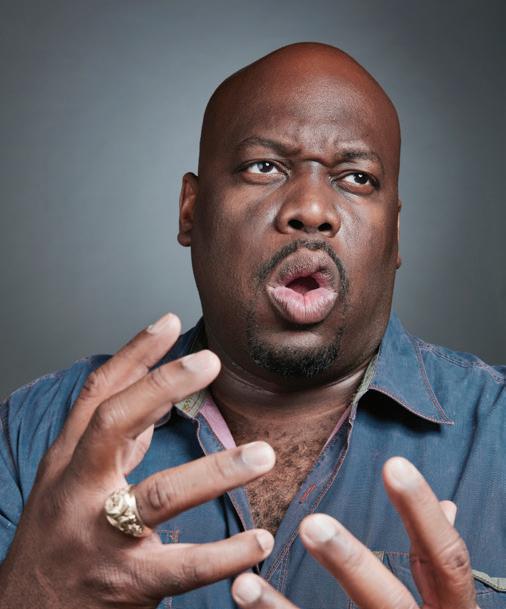
JAN 16 & 17* FRI 11 AM & SAT 7:30 PM
Cristian Mӑcelaru conductor
Morris Robinson narrator & bass
Rita Dove poet
Margaret Bonds Select movements from Montgomery Variations
Samuel Barber Adagio for Strings with poetry commissioned by the CSO Wynton Marsalis Select movements from Blues Symphony
Winstead Chamber Series BAROQUE AND BEYOND
JAN 22 THU 7:30 PM
J.S. Bach, arr. Perron Chaconne from Partita No. 2 in D Minor for Two Cellos
Bohuslav Martinů String Quartet No. 4
Maurice Ravel Piano Trio in A Minor
DOLLY PARTON’S THREADS: My Songs in Symphony
JAN 23–25 FRI & SAT 7:30 PM; SUN 2 PM
Sarah Hicks conductor
Katelyn Drye vocalist
Hollie Hammel vocalist
Blair Lamb vocalist
Derek Drye acoustic guitar
Lindsey Miller electric guitar
Gideon Klein banjo/mandolin
Chris Leidhecker drums
Dolly Parton’s Threads: My Songs In Symphony is an innovative multimedia experience featuring Dolly on screen, leading audiences in a visual-musical journey of her songs, her life and her stories.
SLAVIC LEGENDS
JAN 30 & 31 FRI & SAT 7:30 PM
Oksana Lyniv conductor
Esther Yoo violin
Evgeni Orkin Five Interrupted Lullabies
Sergei Prokofiev Violin
Concerto No. 1
Antonín Dvořák Golden Spinning Wheel
Bedřich Smetana “Vltava” (“The Moldau”) from Má vlast (“My Country”)
ACCESS TO MUSIC
FEB 1 SUN 2 PM
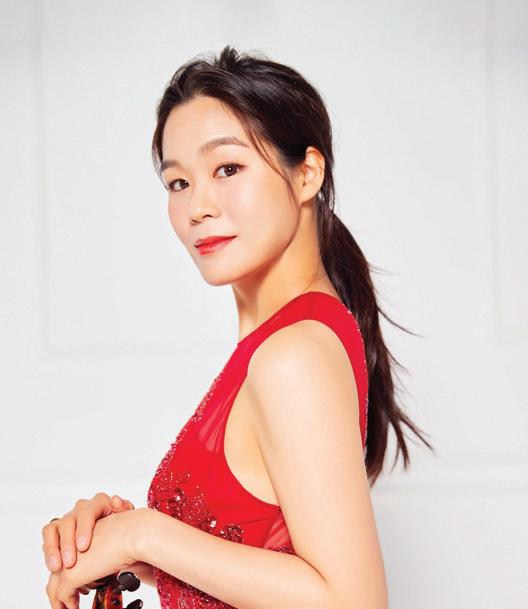
This all-ages, sensory-friendly performance celebrates the connection between autism and music, both of which exist on a vast spectrum.
MAHLER SYMPHONY NO. 4
FEB 6 & 7 FRI 11 AM & SAT 7:30 PM
Tabita Berglund conductor
Camilla Tilling soprano
Anna Thorvaldsdottir ARCHORA
Gustav Mahler Rückert-Lieder Symphony No. 4
Lollipops Family Concert
PETER AND THE WOLF
FEB 7 SAT 10:30 AM
Duo Shen conductor

Big sounds for little ears! Bring your kiddos to Music Hall for a magical musical adventure as Sergei Prokofiev’s beloved tale of Peter and the Wolf comes to life on stage through the sounds of the orchestra.
CSYO/CSO Side by Side
FEB 25 WED 10:30 AM
Cincinnati Symphony Youth Orchestra Philharmonic Orchestra
Cincinnati Symphony Orchestra
Members of the CSYO Philharmonic sit with their CSO counterparts to perform a thrilling hour of music. The students sit in the principal chairs and take the lead in this annual showcase.
*This performance will be livestreamed on the CSO’s YouTube channel, cincinnatisymphony.org/live.
